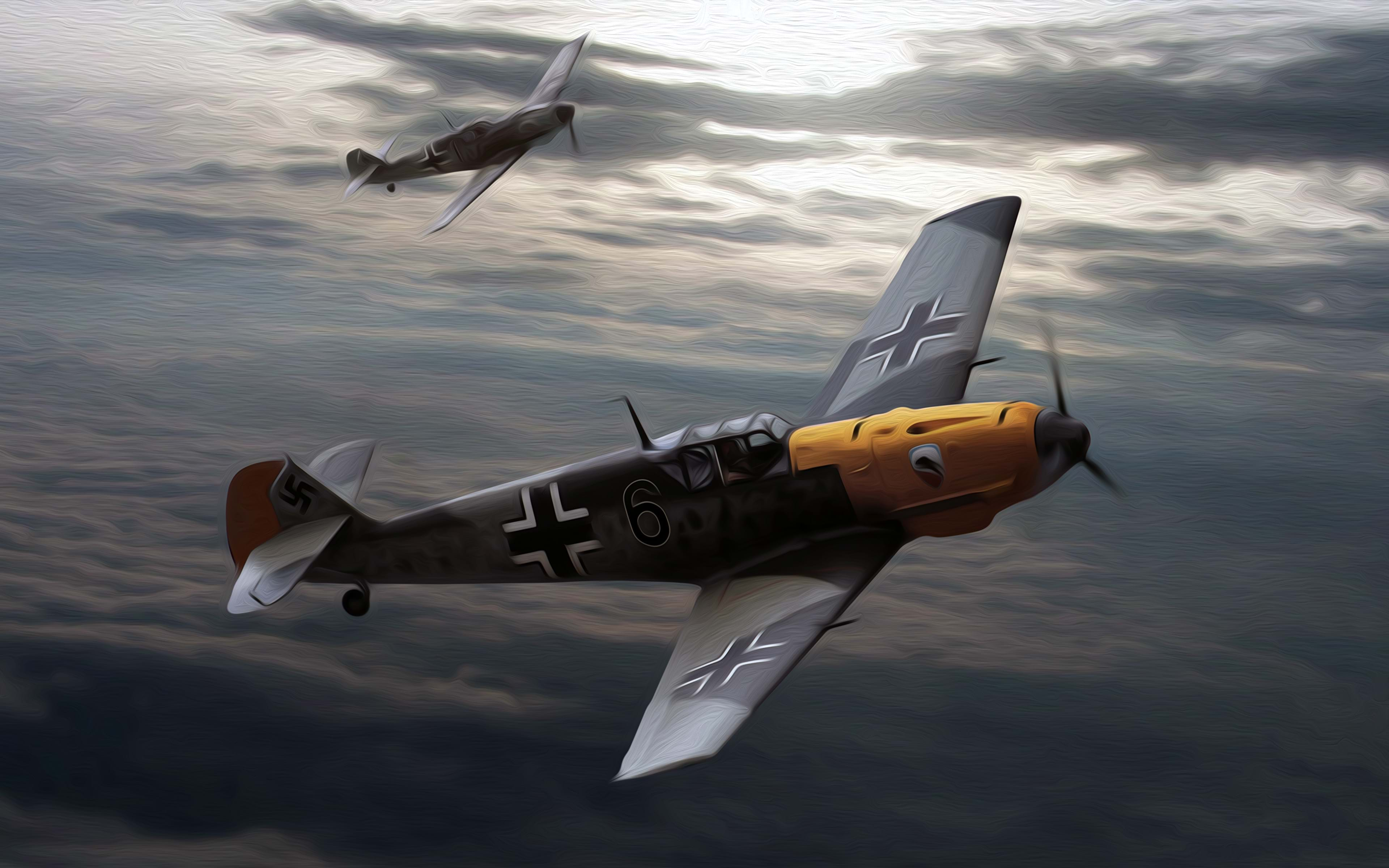Messerschmitt Bf 109
Contents
You can always turn back "Contents" section by using "to Top" bottom which will appear at the bottom right of screen. And you can expand images by clicking on. In addition, you can download the PDF file of this website which is at the bottom of page. Have a nice reading!
Introduction
The Bf 109 provides history with an interesting paradox. An unwanted fighter during its early development – due to unwarranted political influence and the high risk associated with its innovative and advanced design – it was to become the standard by which all other fighters of the World War II era would be judged.
Serving the Luftwaffe in almost every capacity including interceptor, fighter-bomber, nigh-fighter, photo-reconnaissance, escort fighter, and ground attack, the basic Bf 109 airframe survived the duration of the European conflict as the mainstay of the German air force, being produced in a greater number than any other plane (over 30,000 were delivered) past or present. The Bf 109 was also produced in more variants than any other aircraft of its era, with over eleven variants of the G version alone.
Although the Bf 109 had a number of inherent drawbacks that at times detracted from its adaptability to its multi-mission role, with a capable pilot at its controls it was normally more than a match for any of its counterparts. Its effectiveness is attested to by the fact that from its initial flight trials in 1935 until it was finally phased out of service with the Spanish Air Force in 1967, the basic Bf 109s career span over 30 years with various countries around the world.
Background
In 1940, some five years after its first introduction, the now famous Bf 109 remained superior to any fighter aircraft of the time. In 1945, with the ending of hostilities in Europe, the Bf 109 was still considered to be more than formidable enemy in the hands of a competent pilot. The introduction of what was to become the standard dayfighter for the Luftwaffe, however, was anything but ordinary. It was, in fact, the result of a number of daring and unconventional business tactics and several fortunate twists of fate that eventually provided the Bf 109 with the opportunity it deserved to prove itself the capable and respected fighter it was to become.
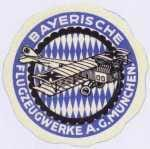
One of the primary reasons for the success of the Bf 109 lay in the factors that influenced its advanced structural design and unique aerodynamic features. Although the concepts were radical for their time, the majority of them were not new, having been tried and tested on several earlier aircraft from various manufacturers around the world. It was, however, in the Bf 109 that all the concepts and aero-technological advances were married into a single aircraft. The risk of this approach was evident, but the relationship of the Bayerische Flugzeugwerke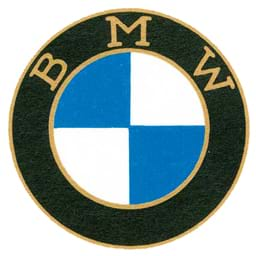 BMW's origins can be traced back to three separate German companies: Rapp Motorenwerke, Bayerische Flugzeugwerke, and Automobilwerk Eisenach. The history of the name itself begins with Rapp Motorenwerke, an aircraft engine manufacturer. After the end of World War I in 1918, BMW was forced to cease aircraft engine production by the terms of the Versailles Armistice Treaty. To maintain in business, BMW produced farm equipment, household items and railway brakes. In 1922, former major shareholder Camillo Castiglioni purchased the rights to the name BMW, which led to the company descended from Rapp Motorenwerke being renamed Süddeutsche Bremse AG (known today as Knorr-Bremse). Castiglioni was also an investor in another aircraft company, called "Bayerische Flugzeugwerke", which he renamed BMW. (Bavarian Aircraft Works) to the German government, left the company with no other alternative in the competition for a new Luftwaffe fighter.
BMW's origins can be traced back to three separate German companies: Rapp Motorenwerke, Bayerische Flugzeugwerke, and Automobilwerk Eisenach. The history of the name itself begins with Rapp Motorenwerke, an aircraft engine manufacturer. After the end of World War I in 1918, BMW was forced to cease aircraft engine production by the terms of the Versailles Armistice Treaty. To maintain in business, BMW produced farm equipment, household items and railway brakes. In 1922, former major shareholder Camillo Castiglioni purchased the rights to the name BMW, which led to the company descended from Rapp Motorenwerke being renamed Süddeutsche Bremse AG (known today as Knorr-Bremse). Castiglioni was also an investor in another aircraft company, called "Bayerische Flugzeugwerke", which he renamed BMW. (Bavarian Aircraft Works) to the German government, left the company with no other alternative in the competition for a new Luftwaffe fighter.
The poor standing of the Bayerische Flugzeugwerke (BFW) and the Luftwaffenfuehrungsstab (Operations Staff) had its origin in 1929 and involved a disagreement between Dr. Willy Messerschmitt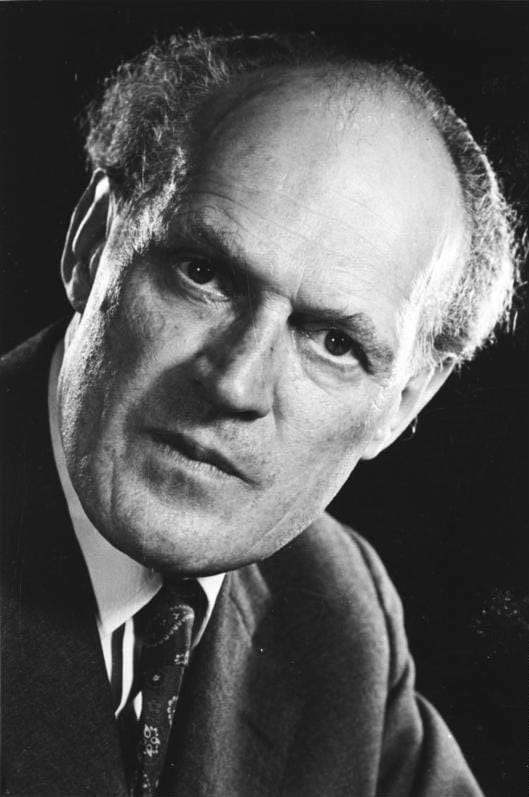 Willy Messerschmitt, (born June 26, 1898, Frankfurt am Main—died Sept. 17, 1978, Munich), German aircraft engineer and designer.
Willy Messerschmitt, (born June 26, 1898, Frankfurt am Main—died Sept. 17, 1978, Munich), German aircraft engineer and designer.
Messerschmitt was educated at the Munich Institute of Technology, where he received a degree in engineering in 1923. From 1926 he was employed as chief designer and engineer at the Bayerische Flugzeugwerke in Augsburg. His interest in gliders and sailplanes was carried into his early designs, which included the Bf 109 single-seat monoplane. and Erhard Milch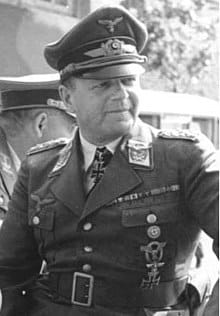 Erhard Milch (30 March 1892 – 25 January 1972) was a German field marshal and war criminal who oversaw the development of the Luftwaffe as part of the re-armament of Nazi Germany following World War I. Milch's father was Jewish but this fact was hidden by Hermann Göring. During World War II, he was in charge of aircraft production; his ineffective management resulted in the decline of the German air force and its loss of air superiority as the war progressed. He was convicted of war crimes during the Milch Trial held before the U.S. military court in 1947 and sentenced to life imprisonment; he was released in 1954., the Director of Lufthansa Procurement. Messerschmitt had established his own aircraft manufacturing company, Messerschmitt Flugzeughbau G.m.b.H.
Erhard Milch (30 March 1892 – 25 January 1972) was a German field marshal and war criminal who oversaw the development of the Luftwaffe as part of the re-armament of Nazi Germany following World War I. Milch's father was Jewish but this fact was hidden by Hermann Göring. During World War II, he was in charge of aircraft production; his ineffective management resulted in the decline of the German air force and its loss of air superiority as the war progressed. He was convicted of war crimes during the Milch Trial held before the U.S. military court in 1947 and sentenced to life imprisonment; he was released in 1954., the Director of Lufthansa Procurement. Messerschmitt had established his own aircraft manufacturing company, Messerschmitt Flugzeughbau G.m.b.H. Messerschmitt AG was a German aircraft manufacturing corporation (AG) named after its chief designer Willy Messerschmitt and known primarily for its World War II fighter aircraft, in particular the Bf 109 and Me 262. The company survived in the post-war era, undergoing a number of mergers and changing its name from Messerschmitt to Messerschmitt-Bölkow-Blohm before being bought by Deutsche Aerospace (DASA, now part of Airbus) in 1989., in March, 1926 and, based on early success, had been provided a subsidy from the Bavarian State Government, German Defense Ministry and a banking firm. It became apparent in 1927 that the Bavarian Government could not support both aircraft firms, and pressure was brought to bear on Messerschmitt to merge his company with BFW. On 8 September 1927, an agreement was signed which assigned total design and development responsibility for new aircraft to the Messerschmitt team and production responsibility to the BFW firm.
Messerschmitt AG was a German aircraft manufacturing corporation (AG) named after its chief designer Willy Messerschmitt and known primarily for its World War II fighter aircraft, in particular the Bf 109 and Me 262. The company survived in the post-war era, undergoing a number of mergers and changing its name from Messerschmitt to Messerschmitt-Bölkow-Blohm before being bought by Deutsche Aerospace (DASA, now part of Airbus) in 1989., in March, 1926 and, based on early success, had been provided a subsidy from the Bavarian State Government, German Defense Ministry and a banking firm. It became apparent in 1927 that the Bavarian Government could not support both aircraft firms, and pressure was brought to bear on Messerschmitt to merge his company with BFW. On 8 September 1927, an agreement was signed which assigned total design and development responsibility for new aircraft to the Messerschmitt team and production responsibility to the BFW firm.

The initial aircraft to be designed and produced under this new arrangement was a 10-seat passenger plane designated M-20.
Numerous problems plagued the development schedule of the aircraft and after the first prototype crashed during flight trials in February, 1928, Lufthansa, represented by Erhard Milch, cancelled the order. A second prototype was quickly produced and after a successful fight test, the order was reinstated by Lufthansa. A year later, however, the order for 10 of the M-20s was again cancelled and Lufthansa requested its downpayment returned. The BFW, having utilized on portion of this funding to place long lead material and component orders, and still another portion to finance in-house development of more advanced aircraft, was unable to meet the repayment demands and filed bankruptcy on 1 June, 1931.
The heated exchanges between Messerschmitt and Milch during this period resulted in an irreversible hatred between the two men that was to last through future years and have a definite influence on the success of BFW and on the design of the Bf 109.
Under Messerschmitt’s direction, the BFW was reformed and reorganized; however, the bitterness that existed between Messerschmitt and Milch, who had risen to the position of Secretary of State of Aviation under Adolf Hitler, continued to restrict growth and progress of the firm. Milch was adamant in his objective of restricting the BFW’s role in support of the new government’s aircraft program to strictly a licensed, second-source producer of other German aircraft manufacturer’s designs.
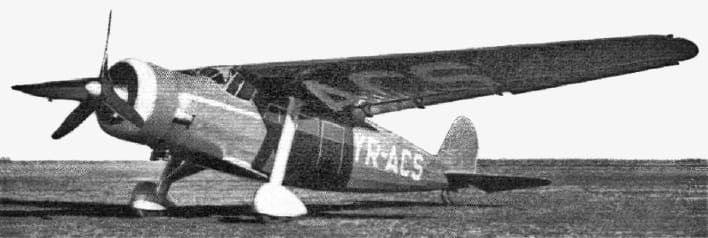
Due to the lack of German government support, either for commercial or military aircraft projects, Messerschmitt decided to chance the punishment of the Hitler regime and to solicit business outside of Germany in an effort to maintain his small design and manufacturing team. The company was successful in obtaining a pair of contracts from Rumania which placed orders for a commercial transport and a single-seat trainer under the designations M-36 and M-37.
It took Milch only a few days to publicly denounce Messerschmitt and the BFW for their support of a foreign government’s (and possible future enemy’s) aircraft industry. The Gestapo made a number of visits to Augsburg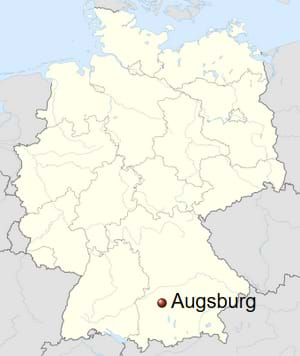 to discuss the matter with Messerschmitt and other officials of the Bayerische Flugzeugwerke. However, the young Messerschmitt held his ground and reiterated the fact that the only means of monetary support for his fledgling firm must come from foreign countries due to the prevailing attitudes of Milch and other member of the Reichsluftfahrtministerium (RLM)
to discuss the matter with Messerschmitt and other officials of the Bayerische Flugzeugwerke. However, the young Messerschmitt held his ground and reiterated the fact that the only means of monetary support for his fledgling firm must come from foreign countries due to the prevailing attitudes of Milch and other member of the Reichsluftfahrtministerium (RLM)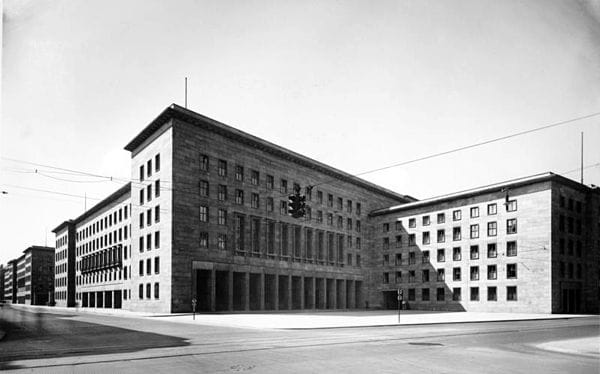 The Ministry of Aviation (German: Reichsluftfahrtministerium), abbreviated RLM, was a government department during the period of Nazi Germany (1933–45). It is also the original name of the Detlev-Rohwedder-Haus building on the Wilhelmstrasse in central Berlin, Germany, which today houses the German Finance Ministry (Bundesministerium der Finanzen).
The Ministry of Aviation (German: Reichsluftfahrtministerium), abbreviated RLM, was a government department during the period of Nazi Germany (1933–45). It is also the original name of the Detlev-Rohwedder-Haus building on the Wilhelmstrasse in central Berlin, Germany, which today houses the German Finance Ministry (Bundesministerium der Finanzen).
The Ministry was in charge of development and production of all aircraft developed, designed and built in Germany during the existence of the Third Reich, overseeing all matters concerning both military and civilian designs — it handled military aviation matters as its top priority, particularly for the Luftwaffe. As was characteristic of government departments in the Nazi era, the Ministry was personality-driven and formal procedures were often ignored in favour of the whims of the Minister, Reichsmarschall Hermann Göring. As a result, early successes in aircraft development progressed only slowly and erratically during World War II..
No further actions were taken against Messerschmitt or the BFW, most likely due to the close relationship of Hermann Göring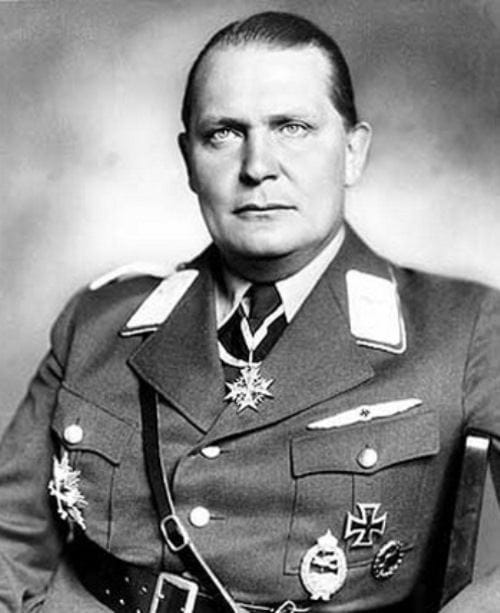 Hermann Wilhelm Göring (12 January 1893 – 15 October 1946) was a German political and military leader as well as one of the most powerful figures in the Nazi Party (NSDAP) that ruled Germany from 1933 to 1945. A veteran World War I fighter pilot ace, he was a recipient of the Pour le Mérite ("The Blue Max"). He was the last commander of Jagdgeschwader 1 (Jasta 1), the fighter wing once led by Manfred von Richthofen., Minister of Aviation, and Theo Croneiss
Hermann Wilhelm Göring (12 January 1893 – 15 October 1946) was a German political and military leader as well as one of the most powerful figures in the Nazi Party (NSDAP) that ruled Germany from 1933 to 1945. A veteran World War I fighter pilot ace, he was a recipient of the Pour le Mérite ("The Blue Max"). He was the last commander of Jagdgeschwader 1 (Jasta 1), the fighter wing once led by Manfred von Richthofen., Minister of Aviation, and Theo Croneiss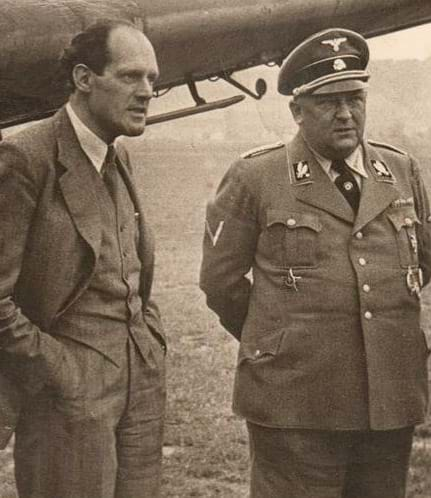 Oberleutnant Theodor Croneiss (18 December 1894 – 7 November 1942) was a World War I fighter pilot credited with five aerial victories.
Oberleutnant Theodor Croneiss (18 December 1894 – 7 November 1942) was a World War I fighter pilot credited with five aerial victories.
Having survived the war as an oberleutnant, Croneiss became a sporting aviator. He became director of a flying club that sponsored Willy Messerschmitt. Croneiss piloted one of Messerschmidt's early designs, the M-21, to win the designer a 60,000 Reichsmark prize. In 1928-1929, Croneiss won the East Prussia Flying Trophy with the M-23 model. He later evolved into a test pilot for the Messerschmitt Company., whom Goering had personally asked to join Messerchmitt in 1933 to assist in reorganizing and rebuilding the reformed BFW.

A fortunate turn of events for the BFW finally occurred in late 1933 when the Luftwaffe decided that the 4th Challenge de Tourisme Internationale, taking place in 1934, would provide the new German government with an opportunity to display its advanced aviation technology. The Bayerische Flugzeugwerke was, along with other German aircraft producers, requested to design and develop a competition sports plane for the races. BFW had, in fact, developed an aircraft for the 1932 Challenge de Tourisme Internationale under the designation M-29. However, the first of the four to be built crashed on 8 August. The following day, a second plane lost power in flight and although the pilot was able to bail out, the flight mechanic was killed in the ensuing crash, and the M-29 was grounded and prohibited from participating in the races.

Due to the limited time available and the advanced state of design progress made on the Rumanian-ordered M-37 trainer, Messerschmitt decided to base the new sports plane on the M-37 airframe. By October, 1933, the BFW was machining metal for the redesignated Bf 108. The aircraft was a two-seater with side-by-side controls, and incorporated a highly advanced monoplane construction with a flush-riveted stressed outer skin. Powered by a 250 hp Hirth MH-8U in-line V*8 or a 218 hp Argus AS-17, the Bf 108A attained airspeeds in excess of 320 km/h (200 mph) and was extremely maneuverable. The small wing of the Bf 108 was fitted with both leading and trailing edge slots for maximum lift and was constructed around a single-spar concept patented by Messerschmitt.
The initial Bf 108A was flown in February, 1934, at the BFW airfield near Augsburg , and the results of the trials exceeded even the most optimistic performance projections of the BFW staff. The next five aircraft rolled off the assembly lines at Augsburg between February and June and were accepted by the Luftwaffe for competition flying by a team of expert military pilots headed by Theo Osterkamp
, and the results of the trials exceeded even the most optimistic performance projections of the BFW staff. The next five aircraft rolled off the assembly lines at Augsburg between February and June and were accepted by the Luftwaffe for competition flying by a team of expert military pilots headed by Theo Osterkamp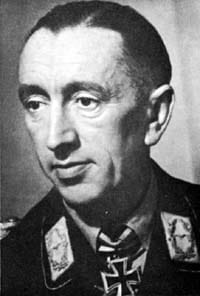 Theodor "Theo" Osterkamp (15 April 1892 – 2 January 1975) was a German fighter pilot during World War I and World War II. A flying ace, he achieved 32 victories in World War I. In World War II, he led Jagdgeschwader 51 through the Battle of Britain and claimed a further 6 victories, in the process becoming one of only a few men to score victories in both world wars.
Theodor "Theo" Osterkamp (15 April 1892 – 2 January 1975) was a German fighter pilot during World War I and World War II. A flying ace, he achieved 32 victories in World War I. In World War II, he led Jagdgeschwader 51 through the Battle of Britain and claimed a further 6 victories, in the process becoming one of only a few men to score victories in both world wars.
On 19 September 1939, Oberst Osterkamp was appointed Geschwaderkommodore of Jagdgeschwader 51 (JG 51—51st Fighter Wing).[Note 1][7] During the Battle of France, he claimed four victories. During the Kanalkampf period of the Battle of Britain in July 1940, he claimed a further two victories, (a Bristol Blenheim on 1 June and a Spitfire on 13 July 1940) bringing his total to six. He was replaced as commander of JG 51 by Werner Mölders on 23 July with the latter formally taking command on the 27th of July. Promoted to Generalmajor, Osterkamp was awarded his Knight's Cross of the Iron Cross on 22 August 1940. Following his replacement in JG 51, Osterkamp was appointed Jagdfliegerführer 2, the commander of fighter aircraft in Luftflotte 2.
On 1 August 1942, he was transferred to Luftgaustab z.b.V. Afrika. On 5 April 1943, he was appointed Jagdfliegerführer Sizilien and served until replaced on 15 July by Adolf Galland. He then served in a number of staff positions until being appointed Inspekteur der Luftwaffen-Bodenorganisation (Inspector of Luftwaffe ground organisation) in 1944. After criticism from High Command, he was dismissed from the service on 21 December 1944.. Although minor problems with the aircraft appeared between May and June, no major setbacks were incurred and the flight testing proceeded without any substantial delays.
Then, on 27 July 1937, the bad luck which had been a constant nemesis to Messerschmitt, appeared again. The first prototype, coded D-I.BUM, crashed and killed the pilot, a member of the Ministry of Aviation. In an effort to ensure that the Bf 108 would not be grounded as had the 1932 M-20, Messerschmitt and the design staff at the BFW worked feverishly to incorporate modifications in to the remaining five aircraft to preclude reoccurrence of the mishap. The plane was finally certified before the end of July and cleared to race.
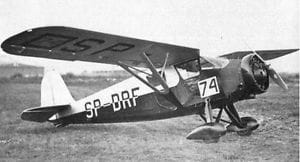

The Bf 108 performed admirably, but finished behind a pair of Polish RWD-9s (RWD-6s had won the rally in 1932) and a German Fieseler Fi 97. Proving itself the fastest of the aircraft entered, however, the Bf 108 had laid the groundwork for the entry of the BFW into the Luftwaffe’s pending new fighter competition and had justified the firm’s belief in the new construction techniques and advanced technological concepts employed in its design.
The initial specifications for a new Luftwaffe fighter were formulated and issued in early 1934 to Focke-Wulf, Arado and Heinkel. However, due to the influence of Erhard Milch, no request was forwarded to the BFW. The new fighter was the result of studies conducted by the C-Amt (Technical Office) of the German Air Ministry and required a low-wing monoplane configuration with a minimum armament of a pair of 7.9-mm MG 17 machineguns and performance characteristics that emphasized structural integrity during a powered dive, spin recovery controls, and provisions for being fitted with a high performance liquid-cooled inverted V-12 cylinder powerplant. (Two companies, Junkers and Daimler-Benz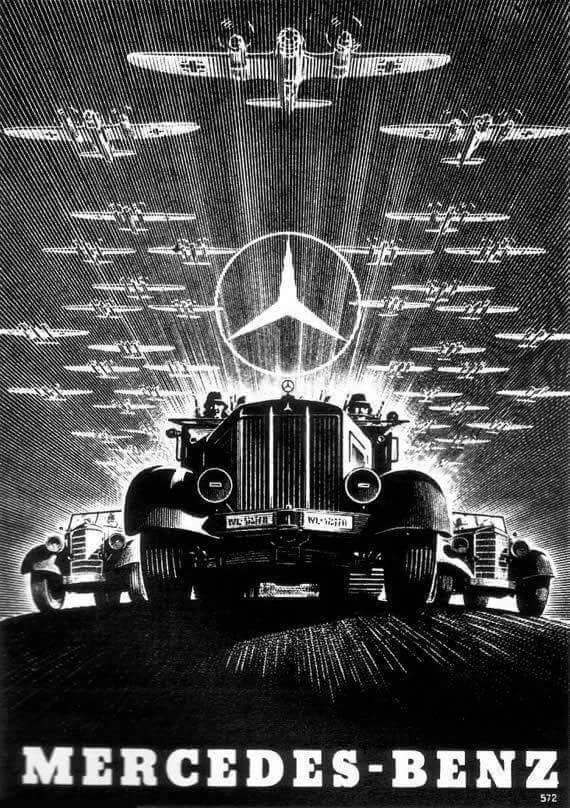 Daimler-Benz AG was a German manufacturer of motor vehicles and internal combustion engines, which was founded in 1926. An Agreement of Mutual Interest – which was valid until 2000 – was signed on 1 May 1924 between Karl Benz's Benz & Cie. and Daimler-Motoren-Gesellschaft, which had been founded by Gottlieb Daimler and Wilhelm Maybach. Daimler had died in 1900, and Maybach had left in 1907.
Daimler-Benz AG was a German manufacturer of motor vehicles and internal combustion engines, which was founded in 1926. An Agreement of Mutual Interest – which was valid until 2000 – was signed on 1 May 1924 between Karl Benz's Benz & Cie. and Daimler-Motoren-Gesellschaft, which had been founded by Gottlieb Daimler and Wilhelm Maybach. Daimler had died in 1900, and Maybach had left in 1907.
Both companies continued to manufacture their separate automobile and internal combustion engine marques until 28 June 1926, when Benz & Cie. and Daimler-Motoren-Gesellschaft formally merged - becoming Daimler-Benz AG (Aktiengesellschaft) - and agreed that thereafter, all of the factories would use the brand name of "Mercedes-Benz" on their automobiles. The inclusion of the name Mercedes in the new brand name honored the most important model series of DMG automobiles, the Mercedes series, which were designed and built by Wilhelm Maybach. They derived their name from a 1900 engine named after the daughter of Emil Jellinek. Jellinek became one of DMG's directors in 1900, ordered a small number of motor racing cars built to his specifications by Maybach, stipulated that the engine must be named Daimler-Mercedes, and made the new automobile famous through motorsports. That race car later became known as the Mercedes 35 hp. The first of the series of production models bearing the name Mercedes had been produced by DMG in 1902. Jellinek left the DMG board of directors in 1909.
Although Daimler-Benz is best known for its Mercedes-Benz automobile brand, during World War II, it also created a notable series of aircraft, tank, and submarine engines. Daimler also produced parts for German arms, most notably barrels for the Mauser rifle. During World War II, Daimler-Benz employed slave labour., were actively engaged in the development of this powerplant at the time of the specification release by C-Amt).

A combination of events including the friendship of Goering and Croneiss, the respect of several Luftwaffe officers familiar with the Bf 108A and uninvolved in the Messerschmitt/Milch feud, and the workloads of the other aircraft firms, finally resulted in the issuance of a development contract to BFW in 1935 for a competitive fighter aircraft. Informed by Milch, that it was solely a development contract and that no production contract would be let to BFW, Messerschmitt was faced with a decision to accept the award and try to overcome Milch’s bias with a superior aircraft, or to decline the contract, which at the time promised no long term security, and instead accept an offer for full professorship at Danzig Technical University. Fortunately for Germany, Messerschmitt opted for the former and pushed forward with his innovative and unique fighter design, the Bf 109.
Had Milch, even in his most far reaching fantasies, anticipated that the proposed Bf 109 would have even been an equal concepts submitted by the other firms, let alone far superior, he would surely never have approved the prototype development contract for the BFW.
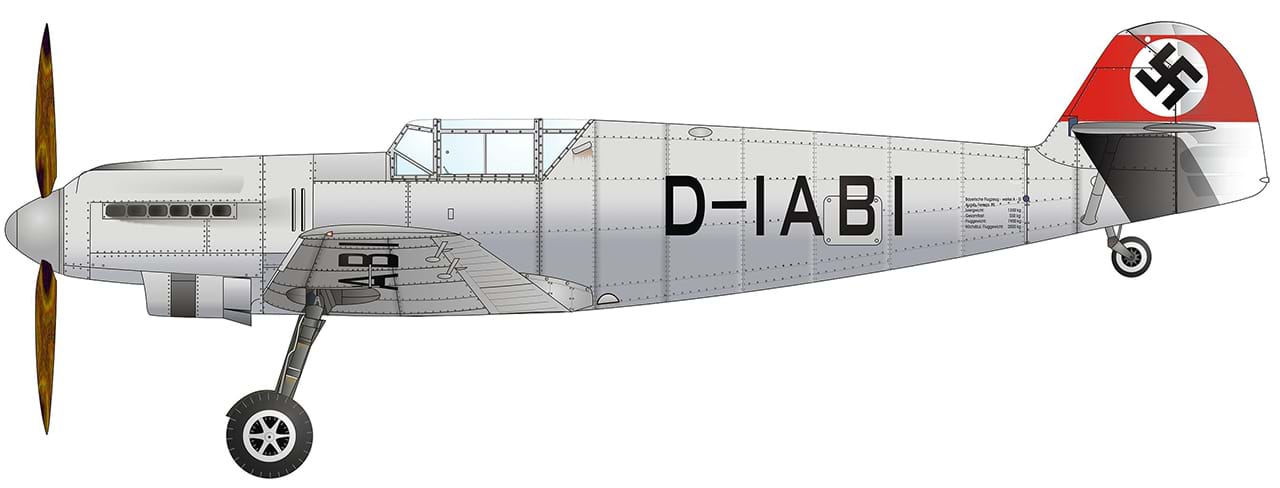
The Bf 109 proposed by BFM had actually been on the drawing boards of Messerschmitt’s staff since the initial flight of the Bf 108 in February, 1934, and was designed around the basic Bf 108A airframe. Like the Bf 108, the Bf 109A incorporated the cantilever low-wing monoplane configuration and retracting landing gear, and the single place cockpit was fitted a fully hinged canopy.
He prototypes for the design were initiated in late 1934 and by August, 1935, the first f these was ready for ground trials at Augsburg. The aircraft was fitted with a Rolls-Royce Kestrel V-12 upright-vee liquid-cooled powerplant with a 695 hp rating at take-off. The Kestrel engine was used in early prototype Heinkel He 112. Arado AR 80 and the Bf 109 due to the lack of availability of the new Junkers Jumo 210 and Daimler-Benz Daimler-Benz AG was a German manufacturer of motor vehicles and internal combustion engines, which was founded in 1926. An Agreement of Mutual Interest – which was valid until 2000 – was signed on 1 May 1924 between Karl Benz's Benz & Cie. and Daimler-Motoren-Gesellschaft, which had been founded by Gottlieb Daimler and Wilhelm Maybach. Daimler had died in 1900, and Maybach had left in 1907.
Daimler-Benz AG was a German manufacturer of motor vehicles and internal combustion engines, which was founded in 1926. An Agreement of Mutual Interest – which was valid until 2000 – was signed on 1 May 1924 between Karl Benz's Benz & Cie. and Daimler-Motoren-Gesellschaft, which had been founded by Gottlieb Daimler and Wilhelm Maybach. Daimler had died in 1900, and Maybach had left in 1907.
Both companies continued to manufacture their separate automobile and internal combustion engine marques until 28 June 1926, when Benz & Cie. and Daimler-Motoren-Gesellschaft formally merged - becoming Daimler-Benz AG (Aktiengesellschaft) - and agreed that thereafter, all of the factories would use the brand name of "Mercedes-Benz" on their automobiles. The inclusion of the name Mercedes in the new brand name honored the most important model series of DMG automobiles, the Mercedes series, which were designed and built by Wilhelm Maybach. They derived their name from a 1900 engine named after the daughter of Emil Jellinek. Jellinek became one of DMG's directors in 1900, ordered a small number of motor racing cars built to his specifications by Maybach, stipulated that the engine must be named Daimler-Mercedes, and made the new automobile famous through motorsports. That race car later became known as the Mercedes 35 hp. The first of the series of production models bearing the name Mercedes had been produced by DMG in 1902. Jellinek left the DMG board of directors in 1909.
Although Daimler-Benz is best known for its Mercedes-Benz automobile brand, during World War II, it also created a notable series of aircraft, tank, and submarine engines. Daimler also produced parts for German arms, most notably barrels for the Mauser rifle. During World War II, Daimler-Benz employed slave labour. DB 600 engines which were still undergoing development testing.
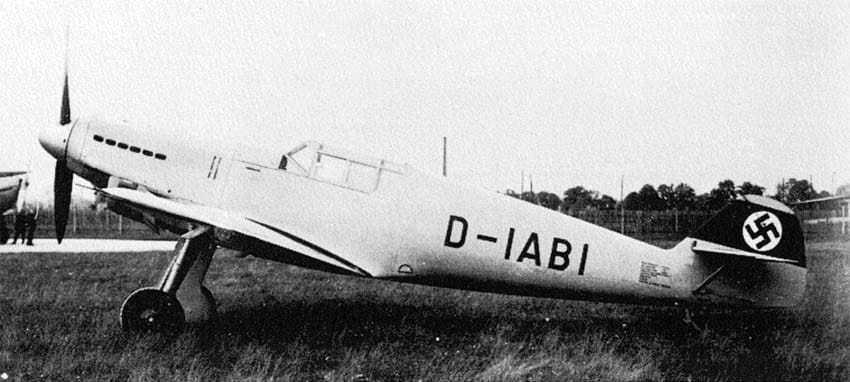
The trials at Augsburg , including extensive undercarriage testing on the struts and retraction, and extension mechanisms, were completed without problems. After undergoing minor modifications, the Bf 109A V1, (V designation for experimental) coded D-IABI, was flight-tested for the first time in September. Successful completion of these initial flight trials, which verified the handling characteristics and performances of the basic design, led to acceptance of the aircraft for flight testing at Rechlin (Luftwaffe Test Center). The Bf 109A V1 was flown to Rechlin and was immediately the object of suspicion by the assembled Luftwaffe test pilots. Used to the open cockpit, low wing loadings, and sturdy construction of the earlier biplanes, the test pilots could not accept the fully enclosed cockpit, innovative automatic wing slots, and the high ground angle of the new fighter which restricted the forward view during taxiing.
, including extensive undercarriage testing on the struts and retraction, and extension mechanisms, were completed without problems. After undergoing minor modifications, the Bf 109A V1, (V designation for experimental) coded D-IABI, was flight-tested for the first time in September. Successful completion of these initial flight trials, which verified the handling characteristics and performances of the basic design, led to acceptance of the aircraft for flight testing at Rechlin (Luftwaffe Test Center). The Bf 109A V1 was flown to Rechlin and was immediately the object of suspicion by the assembled Luftwaffe test pilots. Used to the open cockpit, low wing loadings, and sturdy construction of the earlier biplanes, the test pilots could not accept the fully enclosed cockpit, innovative automatic wing slots, and the high ground angle of the new fighter which restricted the forward view during taxiing.
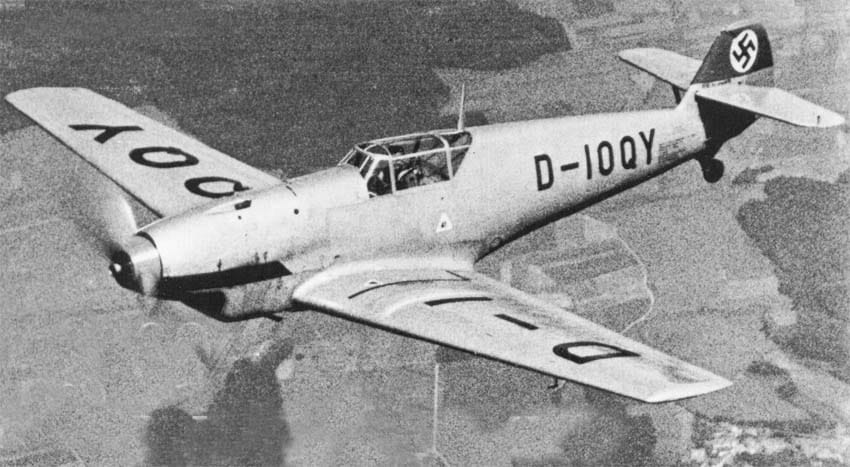

The exhibitions of the Bf 109As flight characteristics, including a 467 km/h (290 mph) airspeed which was 5% faster than the He 112 V1 (also at Rechlin for evaluation), did little no overcome the test pilots’ bias for the wide track lover wing loading He 112. In the meantime, unconcerned than the He 112 was considered to be the forerunner in the fighter competition by knowledgeable Luftwaffe personnel, the BFW continued construction of the second and third prototypes. With the availability of the Junkers Jumo 210A powerplant installation, a few minor structural modifications to the undercarriage, and in the addition of an air intake for cooling of the proposed MG 17 machine-guns which would be installed in the aircraft’s cowling. The fitting of the machine-guns occurred for the first time on the Bf 109A V3 and was the only change from the V2 aircraft. (The V3, however, did not roll off the Augsburg assembly line until May, 1936, due to delays in the delivery of the required Jumo 210A engine).

With the elimination of the Arado and Focke-Wulf prototypes from serious competition due to mechanical failures and low performance, the unwanted and unpopular design from the Bayerische Flugzeugwerke suddenly found itself in a position to become the next generation Luftwaffe fighter. Adding to the Bf 109s favor was the fact that German Intelligence had, in mid-1936, reported the production order of the new Royal Air Force Supermarine Spitfire, an aircraft much like the Messerschmitt in so far as it incorporated many similar technological advances.
In addition, continued superior performance demonstrated by the Bf 109 in comparison to the heavier and slower He 112 was beginning to the influence even the most determined detractors of the BFW fighter at the RLM. As the flight evaluation trials continued through the fall of 1936 at Travemuende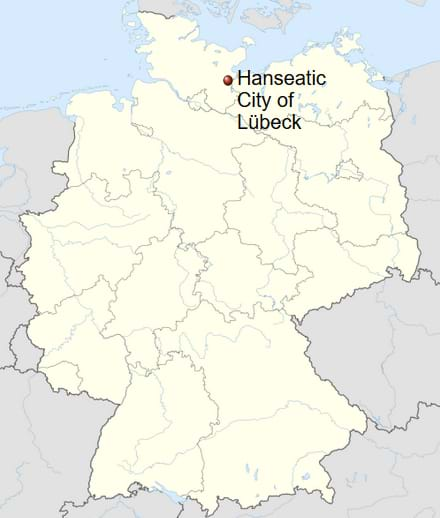 , the Bf 109 became an odds-on favorite. Demonstration of the Bf 109s ability to roll and recover at will, to maintain structural integrity under steep power dives from high altitudes, to turn inside and to outclimb the He 112, far outweighed the rumors and poor press that the new aircraft had been exposed to. Although not unanimous in its decision, the RLM recommended the selection of the Bf 109, and an order for 10 pre-production aircraft was placed with BFW.
, the Bf 109 became an odds-on favorite. Demonstration of the Bf 109s ability to roll and recover at will, to maintain structural integrity under steep power dives from high altitudes, to turn inside and to outclimb the He 112, far outweighed the rumors and poor press that the new aircraft had been exposed to. Although not unanimous in its decision, the RLM recommended the selection of the Bf 109, and an order for 10 pre-production aircraft was placed with BFW.

Substantiation of this decision was to occur only weeks later when the Luftwaffe staged an aviation display at Rechlin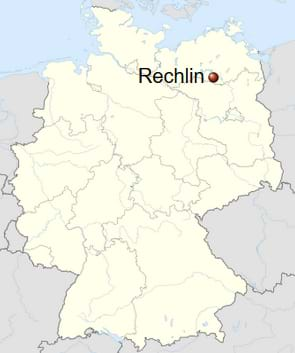 for Generalfeldmarschall Goering and other high ranking officials of the RLM. The aerial displayed finished with a mock air battle in which a force of bombers were to be intercepted by a flight of four He 51s. After this interception, Oberst Ernst Udet
for Generalfeldmarschall Goering and other high ranking officials of the RLM. The aerial displayed finished with a mock air battle in which a force of bombers were to be intercepted by a flight of four He 51s. After this interception, Oberst Ernst Udet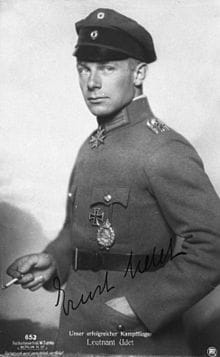 Ernst Udet (26 April 1896 – 17 November 1941) was a German pilot and air force general during both World War I and World War II.
Ernst Udet (26 April 1896 – 17 November 1941) was a German pilot and air force general during both World War I and World War II.
Udet joined the Imperial German Air Service at age 19, eventually becoming a notable flying ace of World War I, scoring 62 confirmed victories by the end of his life. The highest scoring German fighter pilot to survive that war, and the second-highest scoring after Manfred von Richthofen, his commander in the Flying Circus, Udet rose to become a squadron commander under Richthofen, and later under Hermann Göring.[1] Udet spent the 1920s and early 1930s as a stunt pilot, international barnstormer, light aircraft manufacturer, and playboy.
In 1933, Udet joined the Nazi Party and became involved in the early development of the Luftwaffe, where he was appointed director of research and development. Influential in the adoption of dive bombing techniques as well as the Stuka dive bomber, by 1939 Udet had risen to the post of Director-General of Equipment for the Luftwaffe. The stress of the position and his distaste for administrative duties led to Udet developing alcoholism.
The launch of Operation Barbarossa, combined with issues with the Luftwaffe's needs for equipment outstripping Germany's production capacity and increasingly poor relations with the Nazi Party, caused Udet to commit suicide on 17 November 1941 by shooting himself in the head. (famous fighter ace of World War I) was to take off in the Bf 109A V3 and intercept the four He 51s. Udet took off and destroyed the four He 51s in simulated combat, and then, on his own initiative, attacked the bombers and was credited with destroying the entire formation in his new single-place fighter.

Bf 109B series (pre-production)
The Bf 109B-0 designation was allocated to pre-production aircraft to be utilized in optimizing the basic Bf 109 airframe, powerplant and armament. They were therefore assigned the standardized series of experimental, or ‘V’ codes that identified developmental aircraft. The initial Bf 109B, coded V4, closely resembled its Bf 109A predecessors in that it was fitted with the Junker Jumo 210A. However, it incorporated an additional MG 17 machine-gun located between the cylinders of the engine and firing through the propeller hub. This added armament was installed in response to the Luftwaffe Operations Staff’s final evaluation review of the prototype tests which noted that the original requirement for only a pair of the 7.9-mm weapons provided insufficient firepower.
The Bf 109 V4, flown for the first time in November, 1936, was followed during the next two months by the V5 and V6. These aircraft were fitted with the improved performance Jumo 210B powerplant and included other minor refinements consisting of the replacement of the gun cooling intake with a trio of flush cooling slots, a change in the wing support structure to allow for removal of the wing panel stiffeners added to the second prototype aircraft during undercarriage load testing.

Not only did these three aircraft successfully complete their pre-flight trials, but they were actually evaluated under combat conditions, when in December, 1936, and January, 1937, the three planes were shipped to Jadggruppe 88 in Spain to assist the Nationalist cause in the Spanish Civil War. Germany had, in mid-1936, committed itself to support of the Nationalists and assinged Jagdgruppe 88, equipped with He 51s, to Seville. However, during the initial engagements between the He 51s of Jadggruppe 88 and the Soviet-built Polikarpov I-15 fighters used by the Republican Forces, The German fighter had continuously been out performed. It was decided by the Luftwaffe Command to send the new experimental fighters into the conflict to evaluate their strong points and shortcoming.
As would be expected, the new aircraft suffered from the vast array of minor mechanical problems which normally plague the early development of new fighters. However, it did prove its superior performance in service operations and verified the decision of the Luftwaffenfuehrungsstab in selecting the Bf 109 over the He 112. The three fighters were subsequently returned to Augsburg to be reinstated into the planned development program.
to be reinstated into the planned development program.
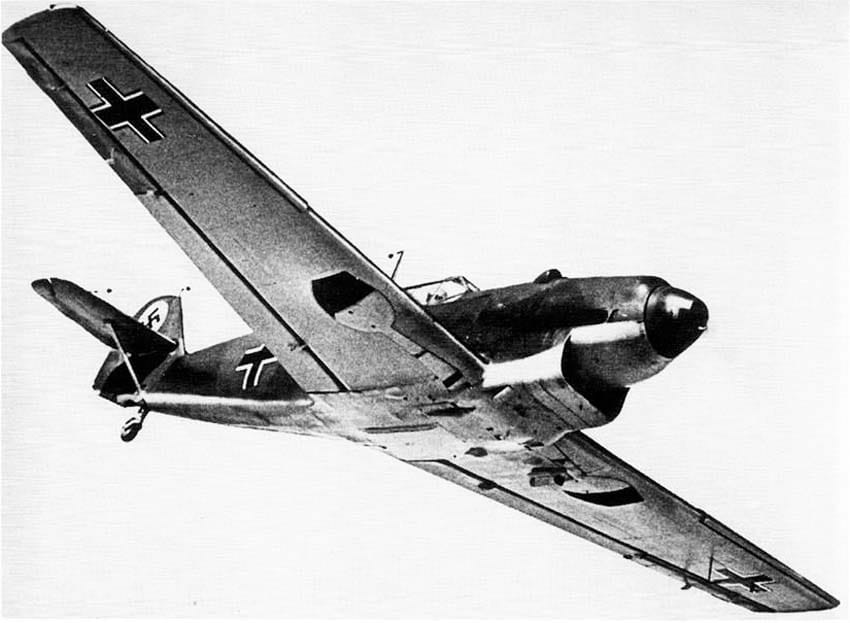
Bf 109 V7 started its flight testing in March, 1937, and was fitted with a Jumo 210G powerplant with fuel injection and a two-stage supercharger that provided over 700 hp for take-off compared to the 610 hp rating of the earlier Jumo 210A. This aircraft was to serve as the prototype for the Bf 109B-2.
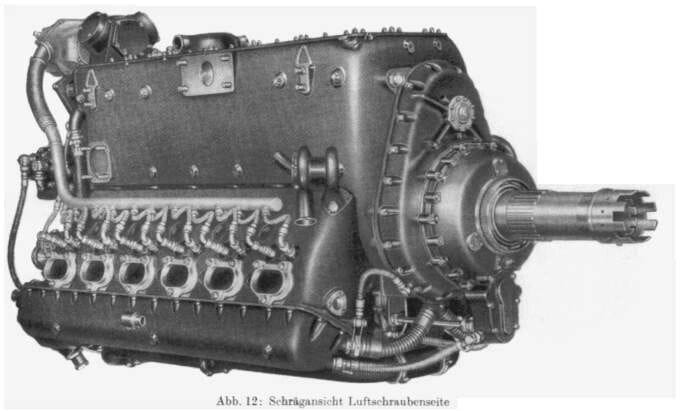

The V8, V9 and V10 aircraft were identified as prototypes for the Bf 109C. The V8 and V9 models were powered by the Jumo 210Ga powerplant, was re-engined with a high-performance DB 600Aa which delivered over 900 hp for take-off. The V8 incorporated a pair of wing-mounted MG 17 machine-guns just outside of the undercarriage strut which required a few simple modifications to the wing’s leading edge, and firing trials proved so successful that the new four machine-gun armament was adopted as standard for the later Bf 109C.
The V9 was similar to the V8 except that it was fitted with a pair of 20-mm MG FF cannon in the wings in place of the 7.9-mm machine guns. However, minor problems with the higher caliber weapon restricted its incorporation into the production of aircraft until the evolution of the E-version.

The V10 model, with its DB 600 powerplant, crashlanded during an attempt by Ernst Udet (was had become one of the Bf 109’s most ardent supporters) to set speed records at the Zurich-Duebendorf International Flying Meeting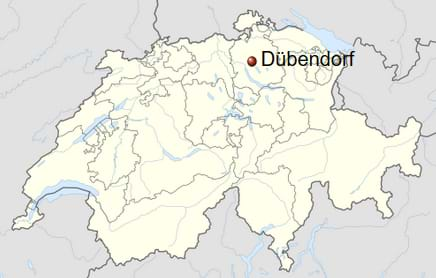 in July, 1937, and was replaced by the V11 for powerplant testing of the new Daimler-Benz
in July, 1937, and was replaced by the V11 for powerplant testing of the new Daimler-Benz Daimler-Benz AG was a German manufacturer of motor vehicles and internal combustion engines, which was founded in 1926. An Agreement of Mutual Interest – which was valid until 2000 – was signed on 1 May 1924 between Karl Benz's Benz & Cie. and Daimler-Motoren-Gesellschaft, which had been founded by Gottlieb Daimler and Wilhelm Maybach. Daimler had died in 1900, and Maybach had left in 1907.
Daimler-Benz AG was a German manufacturer of motor vehicles and internal combustion engines, which was founded in 1926. An Agreement of Mutual Interest – which was valid until 2000 – was signed on 1 May 1924 between Karl Benz's Benz & Cie. and Daimler-Motoren-Gesellschaft, which had been founded by Gottlieb Daimler and Wilhelm Maybach. Daimler had died in 1900, and Maybach had left in 1907.
Both companies continued to manufacture their separate automobile and internal combustion engine marques until 28 June 1926, when Benz & Cie. and Daimler-Motoren-Gesellschaft formally merged - becoming Daimler-Benz AG (Aktiengesellschaft) - and agreed that thereafter, all of the factories would use the brand name of "Mercedes-Benz" on their automobiles. The inclusion of the name Mercedes in the new brand name honored the most important model series of DMG automobiles, the Mercedes series, which were designed and built by Wilhelm Maybach. They derived their name from a 1900 engine named after the daughter of Emil Jellinek. Jellinek became one of DMG's directors in 1900, ordered a small number of motor racing cars built to his specifications by Maybach, stipulated that the engine must be named Daimler-Mercedes, and made the new automobile famous through motorsports. That race car later became known as the Mercedes 35 hp. The first of the series of production models bearing the name Mercedes had been produced by DMG in 1902. Jellinek left the DMG board of directors in 1909.
Although Daimler-Benz is best known for its Mercedes-Benz automobile brand, during World War II, it also created a notable series of aircraft, tank, and submarine engines. Daimler also produced parts for German arms, most notably barrels for the Mauser rifle. During World War II, Daimler-Benz employed slave labour. engine. The Bf 109 V12 and V13 (the last of the original pre-production prototypes) were also originally fitted with the DB 600A. The V13 aircraft was later re-engined with the new and more powerful DB 601 and was the aircraft which set the world airspeed record for land-based aircraft in November, 1937, Covering a 3-km (1.86-mile) straight course twice in both directions, the Bf 109 V13 was clocked at an average airspeed of 610.5 km/h (379.38 mph).
Bf 109B series (production)
With the impressive success of the early prototype Bf 109Bs, production of the variant was ordered, and the initial Bf 109B-1 rolled off the assembly lines in February, 1937, The B-1 was essentially based on the V4, V5 and V6 models of the pre-production run and were powered by the supercharged Jumo 210Da engine driving a Schwarz twin-blade fixed-pitch wooden propeller which provided 680 hp at take-off. The armament was limited to a pair of cowling-mounted MG 17 machine-guns, with the through-propeller hub machine-gun being omitted due to cooling problems uncovered during the testing of the V4, V5 and V6 aircraft.
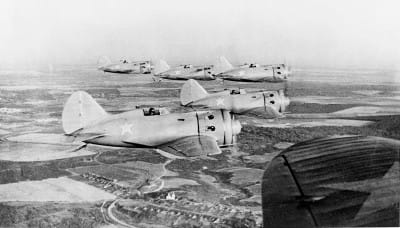
Originally scheduled to go into service with Jagdgeschwader 132 “Richthofen” the initial B-1s were delivered to 11 Gruppe for combat training; however, the assignment of these aircraft to Jadggrupper 88 in Spain was given top priority because of the proven advantages of the I-15 and I-16 over the Luftwaffe’s He 51s. The pilots and aircraft of JG 132 therefore, were immediately transferred to Jagdgruppe 88 after training.
Only 30 of the B-1 models were produced before the Luftwaffenfuehrungsstab switched the Augsburg assembly line over the Bf 109B-2, which differed from the B-1 only in the replacement of the wooden Schwarz airscrew with a variable-pitch VDM metal license-built (Hamilton-Standard) propeller. By July, 1937, the Bf 109B-2s were being delivered to 1 Staffel of Jagdgruppe 88.
Because Bayerische Flugzeugwerke was producing the new fighter at maximum capacity, and still not meeting the Luftwaffe’s need (although additional facilities were being constructed at Augsburg), a license agreement was signed with the Fieseler plant at Kassel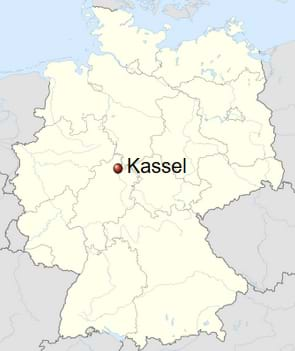 for additional production. By December, aircraft from Fieseler
for additional production. By December, aircraft from Fieseler The Gerhard Fieseler Werke (GFW) in Kassel was a German aircraft manufacturer of the 1930s and 1940s. The company is remembered mostly for its military aircraft built for the Luftwaffe during the Second World War.
The Gerhard Fieseler Werke (GFW) in Kassel was a German aircraft manufacturer of the 1930s and 1940s. The company is remembered mostly for its military aircraft built for the Luftwaffe during the Second World War.
Fieseler's other wartime production would largely consist of building other firms' aircraft under licence, including the Messerschmitt Bf 109 and Focke-Wulf Fw 190. In 1941 however, a Fieseler project for an unpiloted flying bomb (Fi 103) attracted the attention of the RLM (Reichsluftfahrtministerium - "Reich Aviation Ministry"). This went into production as the Fieseler FZG-76 (flakzielgerät, antiaircraft targeting device), better known as the V-1.
The Fieseler factory was the target of many Allied air raids, but continued production throughout the war. Following the War, part of the factory continued in business for a few years, producing automotive components. Its most famous products, the Storch and the V1, continued to be produced by foreign companies. began to supplement the deliveries from Augsburg.
Bf 109B-2 Specifications
Take-off 720 hp
Max cont. 610 hp
418 km/h at 1000 m (260 mph at 3280 ft)
444 km/h at 2500 m (276 mph at 8200 ft)
465 km/h at 4000 m (298 mph at 13,120 ft)
350 kmh/h at 2500 m (217 mph at 8200 ft)
Length: 8.55 m (28 ft 5/8 inch)
Height (ground to canopy): 2.45 m (8 ft 0.5 inch)

Bf 109C series
The Bf 109C-1 was based on the V8, V9 and V10 prototype models and incorporated the improved Junkers Jumo 210Ga engine which developed 700 hp at take-off. (A few of the final batches of the Bf 109 B-2 had been fitted with the Jumo 210Ga powerplant which was planned for initial incorporation into the Bf 109C.)

The C-1 also increased the basic Bf 109 armament through the additional of a pair of wing-mounted 7.9mm Rheinmetall MG 17 machine-guns and incorporated a revision of the powerplant exhaust exists and an increased radiator intake size which resulted in identifiable external differences from the B-1. In addition, the C-1 was fitted with an FuG 7 radio, providing direct communication between fighter-control ground forces and the plane, something that had not existed in the earlier models.
The Bf 109C-1s began leaving the assembly lines at Augsburg in March, 1938, and like its predecessors were immediately shipped to Spain to allow transition of the remaining He 51s and some of the initial Bf 109B-1s.
Three additional variants of the Bf 109C were produced at Augsburg, these being the C-2, C-3 and C-4 models. The Bf 109C-2 was an experimental development model and was identical to the C-1 except that it incorporated the engine-mounted MG 17 machine-gun that had been eliminated from earlier variants due to cooling problems. The cooling of the gun mechanism had been increased through a number of material changes and increases in insulation and ducting. The Bf 109C-3 was used as a test bed for the incorporation of using wing-mounted 20-mm MG FF cannons.
The Bf 109C-4, in turn, replaced the engine mounted MG 17 with an MG FF cannon. The C-4s, however, were also utilized as developmental aircraft and were ever delivered to operational units.

During the production of the C-version of the Bf 109, one other significant occurrence took place. That was the change of name of the Bayerische Flugzeugwerke to Messerschmitt A.G. This change was essentially the result of not only the great success of the aircraft, but also because of the national hero status Messerschmitt had achieved during the previous two years with his innovative and successful new aircraft concepts. Wishing to capitalize on this growing fame, the German Air Ministry had suggested to the Bayerische Flugzeugwerke management (which included Messerschmitt) that it could provide the company with a more international image through the name change.
Bf 109C-1 Specifications
Take-off 700 hp
Max 675 hp at 3800 m (12,470 ft)
575 km/h at 3500 m (357 mph at 11,480 ft)
344 kmh/h at 3100 m (214 mph at 10,170 ft)
Length: 8.55 m (28 ft 5/8 inch)
Height (ground to canopy): 2.45 m (8 ft 0.5 inch)

Bf 109D series
The Bf 109D version was produced only as an interim fighter (approximately 200 being built) filing the gap between the Jumo 210 powered Bf 109C and the planned DB 601 powered Bf 109E. The DB engines, both the basic 600 and the improved 601 models, provided increased performance to the Messerschmitt fighter. The availability of both, however, was limited during 1937-38. These limitations on availability were the influencing factors, not only on the decision to produce the D-variant, but also on the quantity built. Having been designed from the outset to accept the new Daimler-Benz 600 series powerplants, the incorporation of this engine into the Bf 109 was delayed until 1937 because the DB 600 was utilized in the He 111 bomber and the production of bombers had received the highest priorities during the mid-thirties. In addition, the service acceptance of the improved DB 601 engine was delayed due to difficulties with the new automatically-monitored supercharger system, which provided the engine with added power and eliminated cut-outs even under high G loadings.

Realizing that the DB 600 would not be available in sufficient quantities for a large production run of the Bf 109D, and that the DB 601 would not be ready for some months, the German Air Ministry opted to produce the interim D-version with the limited supply of Jumo 210D and Jumo 210G powerplants, and to forestall the installation of the newer DB 601 until the Bf 109E series evolved.
The Bf 109D program was initiated in mid-1937 with a pair of pre-production aircraft assigned the designation V14 and V15. However, these two planes were diverted to developmental efforts being started on the E-series aircraft, and the D-version was restricted to the utilization of the V11, V12 and V13 (Bf 109B-0 prototypes) for design and structural testing. The Bf 109D was to be the first model to feature the familiar lines that were to become the identification criteria for future variants. The aircraft would have been essentially identical to the earlier models from the cockpit aft, but he forward cowling would undergo a major change. The wide radiator intake would be replaced by a small, aerodynamically smooth, oil cooler intake and a pair of small glycol radiators would be added to the under-surface of each wing. A long supercharger air intake would also be added to the port side of the cowling just over the exhaust stubs. Structural strengthening was evident in the landing gear struts, undercarriage attach points and it the powerplant interface locations. However, all these modifications except for the structural changes, were delayed until the introduction of the E-version due to the reversion back to the Jumo powerplants.
Armament for the Bf 109D consisted of the then standardized pair of cowl-mounted MG 17 machine-guns and a single 20-mm MG FF cannon between the cylinders of the inverted-Vee Jumo powerplant. The latter weapons was later removed for some of the aircrafts, as operational use still resulted in numerous occurrences of jamming, and flight characteristics were adversely influenced when the cannon was fired.
In an effort to increase armament and overcome the still unresolved engine-mounted weapon problems, the Bf 109D-2 was ordered. The D-2 was identical to the D-1 except that the center-mounted weapons was omitted and the aircraft was fitted with a pair of wing-mounted MG 17 machine-guns. In addition, a small number of Bf 109D-3s were produced that differed from the D-2 only in that they incorporated a pair of 20-mm MG FF cannon in the wings in place of the MG 17 machine guns.
Bf 109D-1 Specifications
Take-off 986 hp
Max 910 hp at 4000 m (13,120 ft)
775 hp max continuous
575 km/h at 3500 m (357 mph at 11,480 ft)
370 kmh/h at 3600 m (230 mph at 11,810 ft)
Length: 8.55 m (28 ft 5/8 inch)
Height (ground to canopy): 2.45 m (8 ft 0.5 inch)

Bf 109E series
The first large scale production version of the Bf 109 series was the Bf 109E. Powered by the DB 601A-1 engine, which had been fitted to the first pair of pre-production bf 109D-0 aircraft (V14 and V15), ten pre-production Bf 109E-0s were ordered for service evaluation, basically for acceptance testing of the new powerplant. The testing of the DB 601 was necessitated by the RLM's decision to cancel further production of the DB 600 in early 1938 based on promises from Daimler-Benz that production quantities of the DB 601 would be available for the E-series by mid-1938. Problems with the early DB 601s, however, had delayed its service acceptance, and thus, production of the Bf 109E.
Assigning the first three pre-production codes (Bf 109E-01, -02, and -03) to the Bf 109 V13, V14 and V15, the remaining seven pre-production aircraft received designations of V16 through V22. These were utilized to test various armament and engine modifications.
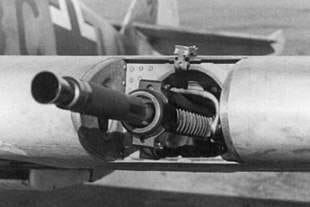
Production deliveries of the Bf 109E-1 began early in 1939 with several of the initial aircraft being assigned to Spain with the Condor Legion, which began receiving the Bf 109E during February and March. Although these aircraft arrived too late to influence the outcome of the Spanish Civil War, a few scattered encounters between the new variant and the aircraft of the Republican Forced did take place, with the Bf 109E proving its vast superiority in almost every category.
Armament of the early Bf 109E-1 included the standardized pair of cowl-mounted 7.9-mm MG 17 machine-guns and a pair of the same weapons installed in wings. However, based on the successful results of both testing with the V14, and the favoring of heavier armament by the RLM, later batches of the E-1 were produced with a pair of 20-mm MG FF cannon in place of the wing-mounted machine-guns. Due to the increased size of the cannons, a specially designed cover with a bulged shape was fitted to the lower wing to provide space for the larger weapon and its ammunition drum. In addition, a selector switch for control of both, or one, of the wing weapons was installed in the cockpit allowing the pilot a choice of firepower.

By the end of the hostilities in Spain in late March, 1939, only twenty of the planned 40 Bf 109E-1s had been delivered to Jagdgruppe 88. Although the Luftwaffe units in Germany were also re-equipping with the Bf 109E at this time, the twenty aircraft were transferred to the Spanish National Forces, along with the remaining Bf 109Bs and Bf 109Cs.

The next variant of the Bf 109E to reach production was the E-3, incorporating the improved DB 601Aa which delivered nearly 1,200 hp at take-off and had provision for the installation of an MG FF cannon between the powerplant's cylinders. Problems of jamming, overheating and vibration, however, still plagued this modification, and most of the installations were either removed in the field, or seldom used. The Bf 109E-3 also incorporated other modifications, including a revised canopy design with heavier frame, and the addition of armor plate behind the pilot's head and under the seat.
The Bf 109E-3 supplanted the Bf 109E-1 on the assembly lines in late 1939 and by the end of the year they had started arriving for operational service with frontline Luftwaffe units.

Because of the apparent failure of the nose-mounted MG FF cannon, and its subsequent removal after installation, it was decided to produce the Bf 109E-3 without the center-firing weapon. The result was the designation of Bf 109E-4, with production deliveries beginning during the summer of 1940.
It was also during this time that thoughts of employing the Bf 109 as a Jagdbomber (fighter-bomber) were being considered, based on the needs developed during fighting against the French. The concept was to attach a single bomb under the center fuselage and provide the pilot with an electrical release switch. To test the theory, an evaluation unit, Erprobungsgruppe 210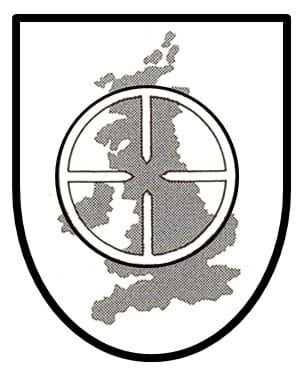 Schnellkampfgeschwader 210 (SKG 210) was a Luftwaffe fast-bomber wing during the Second World War. The unit was created in April 1941 and absorbed by the Zerstörergeschwader 1 on 4 January 1942.
Schnellkampfgeschwader 210 (SKG 210) was a Luftwaffe fast-bomber wing during the Second World War. The unit was created in April 1941 and absorbed by the Zerstörergeschwader 1 on 4 January 1942.
SKG 210 had its origins in Erprobungsgruppe 210 (Test Wing 210), formed at Köln-Ostheim airfield under the command of Hptm. Walter Rubensdörffer in July 1940 as the official service test unit for the then-new Messerschmitt Me 210, the intended successor to the earlier Messerschmitt Bf 110. However, such were the delays in that aircraft’s development that the unit was utilised to develop tactical and strategic practices required to operate the in-service Bf 110s in newer, fighter-bomber and ground-attack roles they were being adapted to. By the time the unit was re-designated I. Gruppe, Schnellkampfgeschwader 210 in April 1941 the unit was based at Abbeville, bombing Allied shipping and land-based targets. The unit then moved east to prepare for the attack on Soviet Russia as part of 2nd Air Corps and originally based at Radzyn.
Some 50 serviceable Bf 110s took part in Operation Barbarossa from two units; Zerstörergeschwader 26 and Schnellkampfgeschwader 210. The Bf 110 provided support to the German Army, carrying out strike missions in the face of heavy AA and ground defences. In the opening air strikes, on 22 June, SKG 210 claimed 344 Soviet aircraft destroyed, more than any other unit, for the loss of 7 Bf 110s destroyed and damaged. SKG 210 flew over the Central part of the front supporting the German army's encirclement and overrunning of Russian land forces in the Białystok and Minsk areas in the early phase of the campaign, and flew in support of the advancing Army Group Centre advance to Moscow in 1941. Between 22 June 1941 and 26 July 1941 the unit claimed to have destroyed 823 Soviet aircraft on the ground and 92 in the air, 2,136 vehicles and 165 tanks destroyed for 57 Bf 110s lost to enemy action. With the coming of winter SKG 210 continued to operate in support of the army, covering their retreat., was formed and a number of Bf 109E-1s and Bf 110Cs were assigned as test aircraft.

With only very minimal training in dive-bombing techniques, the unit began their operational testing against British shipping in the English Channel. The results of the limited endeavor proved so successful that all Luftwaffe Jagdgeschwader were ordered to form one Staffel for Jabo operations. Normally consisting of nine Staffeln, this usually meant the addition of a tenth unit. To equip these new units, Bf 109E-1s, which were being replaced by the later model Bf 109E-3s and E-4s, were retrofitted with an ETC 50 rack for the carrying of a 50 kg (110-lb.) SC 50 bomb and assigned the designation Bf 109E-1/B. In addition, several Bf 109-E4s still on the assembly lines were converted to Bf 109E-4/Bs through the incorporation of a central ETC 250 rack which was capable of handling a single 250 kg (550-lb.) bomb or four SC 50 bombs.
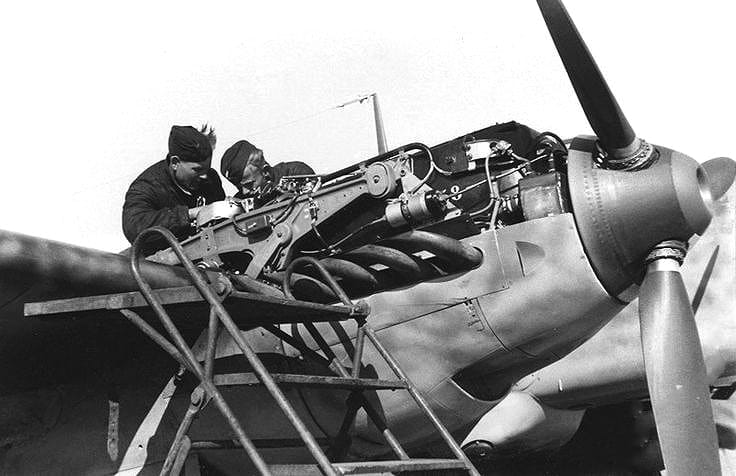
Continuing to strive for ever increasing performance, Daimler-Benz developed the DB 601N powerplant which not only delivered 1,200 hp at take-off, but also offered an emergency output of 1,250 hp for a duration of 1 minute at altitudes in the 4500 m (15,000 ft) range. The engine made use of flattened piston heads instead of the normal concave shape and increased the compression ratio by 15%. Due to this higher compression ratio the powerplant also required the use of higher octane fuel, necessitating a change from 87 to 96 octane. This powerplant was installed in to the Bf 109E-4 series in mid-1940 and the aircraft were given the designation of Bf 109E-4/N.

The Bf 109E-5 was identical to the standard Bf 109E-4 except that it included the installation of a Rb 21/18 camera in the aft fuselage and deleted the wing-mounted MG FF cannon. Produced side-by-side with the E-4, the E-5 was assigned the task of fighter-reconnaissance. With the elimination of the wing armament and ammunition the aircraft's overall weight was reduced to give it increased airspeed for escape from Allied fighter-interceptors. A further refinement of the basic fighter-reconnaissance concept was reflected of the basic fighter-reconnaissance concept was reflected in the Bf 109E-6, which was identical to the E-5 model, except that it incorporated the higher performance DB 601N which had first been installed on the Bf 109E-4/N.

The next Bf 109E variant to appear was the E-7 which was identical to the Bf 109E-4/N except that it included a factory-installed ventrally-mounted ETC 250 rack capable of interfacing with an expendable auxiliary fuel tank (for extended range operation), or with an SC 250 bomb for use as a long-range fighter-bomber. This variant was further modified during 1941 to include the Bf 109E-7/U-2, an early Umruest-Bausatz (factory conversion kit) which provided added armor plate protection for the underwing radiators, lower powerplant area and fuel tanks, and the Bf 109E-7/Z which incorporated a GM 1 injectant boost system to the engine. The injectant system tank, located behind the cockpit, contained nitrous oxide in liquid form which was fed to the powerplant by compressed air and injected into the supercharger where it provided added oxygen. This was, of course, advantageous at higher altitudes where the oxygen level is reduced, and the engine, dependent on oxygen for combustion, starts losing power. The injectant system, in effect, acted as an artificial altitude compensator.

The final two basic variants of the E-series were the Bf 109E-8 and the Bf 109E-9, which made their initial appearance in late 1940. The E-8 was almost identical to the basic E-1 variant, in that it was armed with a pair of fuselage-mounted weapons. Designated as an extended-range fighter, the E-8 was fitted with the underfuselage rack to carry an auxiliary drop tank. The E-9 model was a combination of several of the earlier innovations and modifications made on the E-series and was assigned the role of long-range photo-reconnaissance. The aircraft, powered by the DB 601N engine, was fitted with the auxiliary fuel tank rack, and incorporated an Rb 50/30 camera aft on the cockpit. Armament consisted of the MG 17 fuselage machine-guns, and a pair of wing-mounted MG FF cannon.
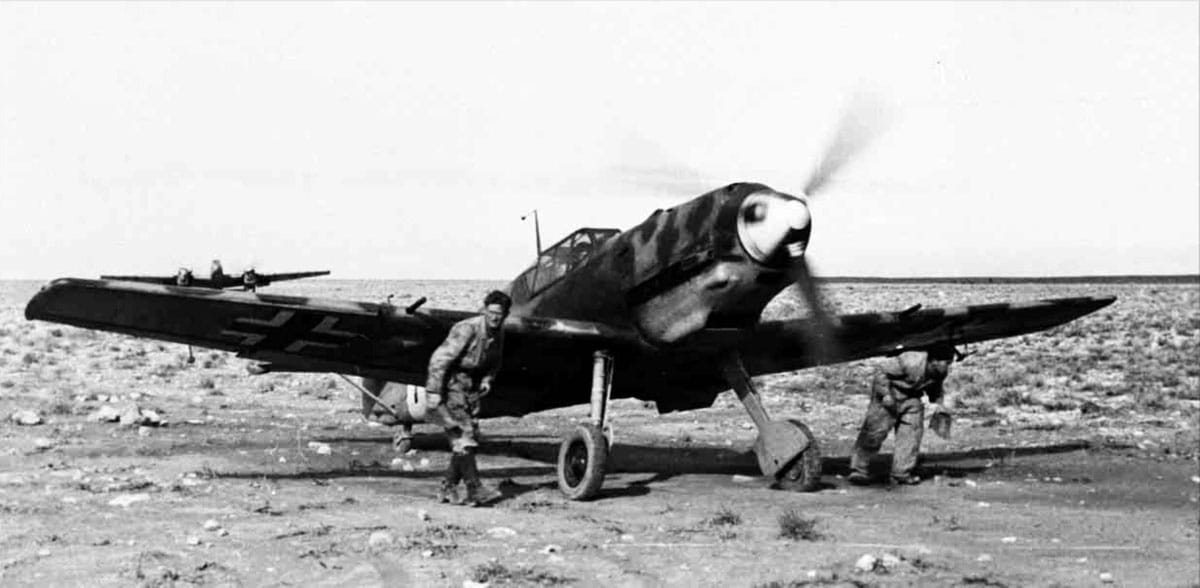
Many other supplemental modifications were made to the basic Bf 109 E-series during its production career - late 1939 through early 1942. These included tropicalized versions of the Bf 109E-4, -5 and -7. The tropicalized modifications, resulting from the dusty environment of the North African area, included the installation of a filter over and in front of the supercharger air intake on the port side of the engine cowling and the packaging of a desert survival kit (including a lightweight cabine, food and water supply, signal equipment, etc.) inside the aircraft. The tropicalized versions of the Bf 109 were given the designation Trop. This term appeared after the basic model designation, as in Bf 109E-5/Trop.

Several one-of-a-kind experimental projects were also conducted with the Bf 109E series including the use of skis and the incorporation of overwing or underwing fuel tanks. The idea behind the use of skis was to provide for operations from snow covered landing areas and, even possibly, deep sand. A Bf 109E-8 was fitted with a pair of faired skis in place of wheels (in actuality, the skies appeared to be more like hollow pontoons) and was flight tested both with the skis alone and using a jettisonable wheeled dolly for assist in take-offs. By the time the tests had been completed, experience by the Luftwaffe in actual winter environments had resulted in minimal difficulties, and as the skied version of the Bf 109E suffered in performance due to the increased drag of the skies and fairings, the project was dropped.
The use of jettisonable over the under wing fuel tanks to improve the range of the fighter was tested on a modified Bf 109E-4 in 1942. It was shown that the installation of these contoured tanks did not appreciably reduce overall airspeed, although they did, to a minor degree, decrease the aircraft's turning rate and overall handling characteristics. Because the need for this type of range was not critical (due in part to the installation of ventraly mounted drop tanks), the basic concept was cancelled. However, the possibility of utilizing the over-wing containers to carry personel and equipment on behind-the-lines espionage missions added new life to the program. In the summer of 1943, a Bf 109E-4 had been modified with re-contoured over-wing containers capable of carrying a man, his parachute and necessary survival equipment, and was test-flown at Stuttgart-Ruit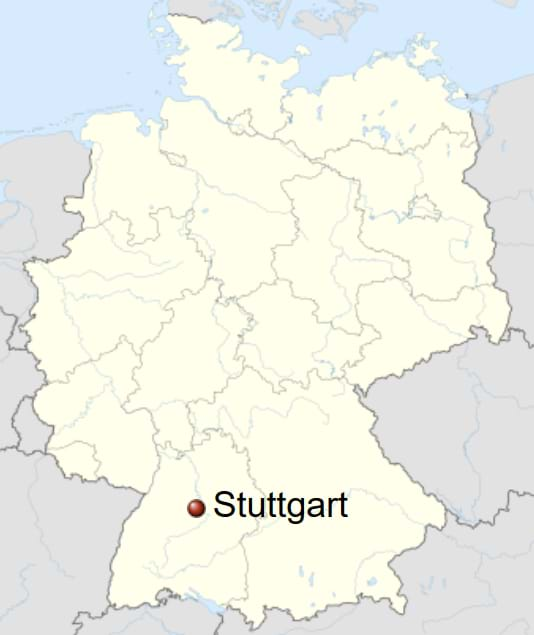 . Tests showed only a minimal loss in airspeed. By this time, however, interest in the project had subsided and no evidence exists that this concept was never put to actual practice.
. Tests showed only a minimal loss in airspeed. By this time, however, interest in the project had subsided and no evidence exists that this concept was never put to actual practice.
Bf 109E-3 Specifications
Take-off 1175 hp
Max 1000 hp at 3700 m (12,140 ft)
775 hp max continuous
494 km/h at 1000 m (307 mph at 3280 ft)
518 km/h at 2000 m (322 mph at 6560 ft)
560 km/h at 4400 m (348 mph at 14,560 ft)
542 km/h at 6000 m (336 mph at 19,685 ft)
6000 m (19,685 ft) 7 min 45 sec
Length: 8.8 m (28 ft 10.5 inch)
Height (ground to canopy): 2.5 m (8 ft 2.25 inch)
Bf 109E Illustrations




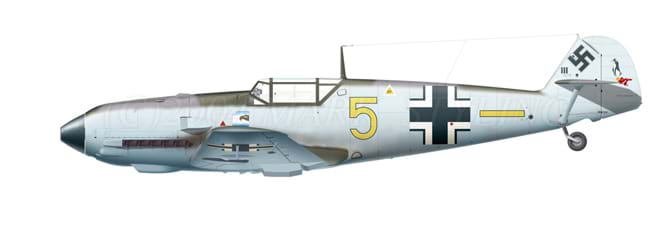


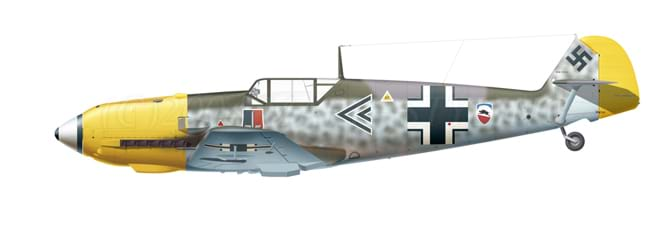
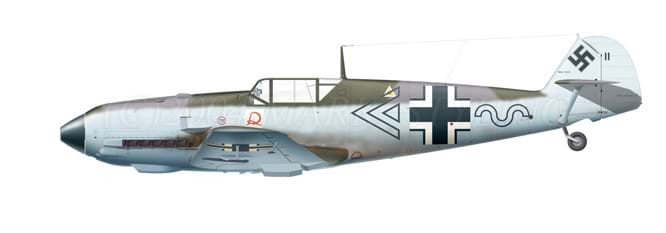



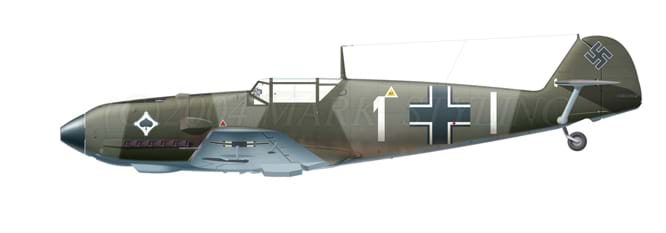




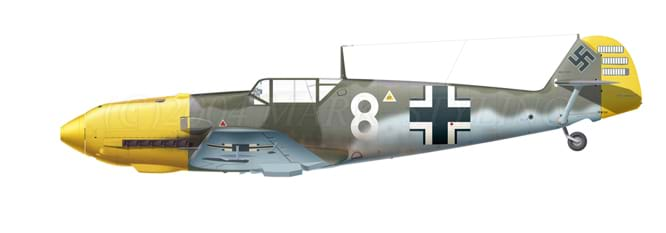

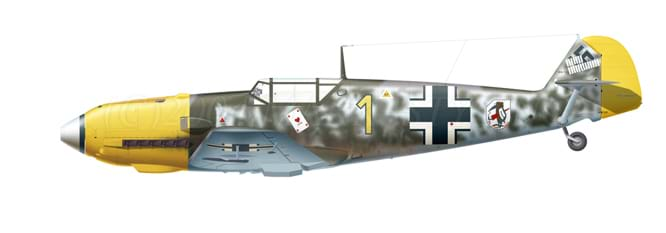





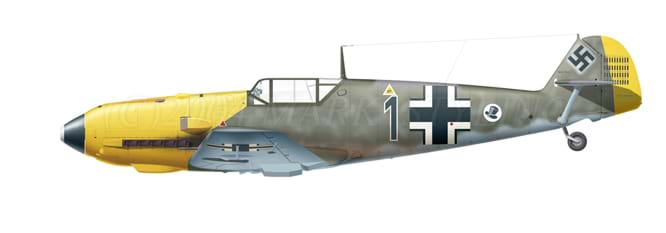






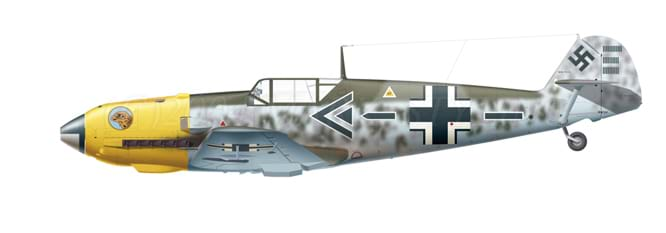

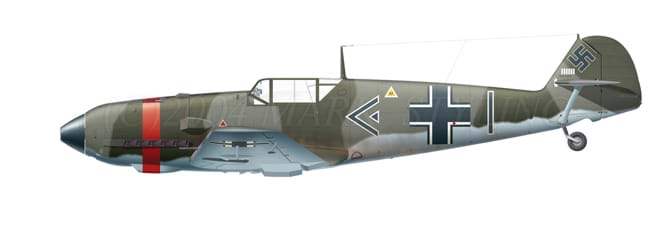





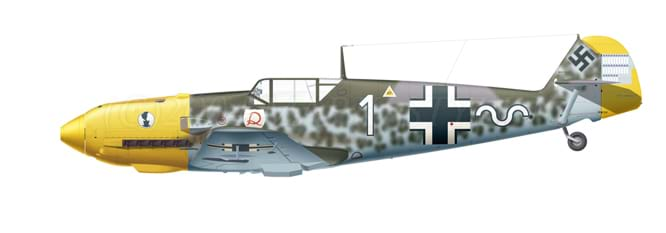



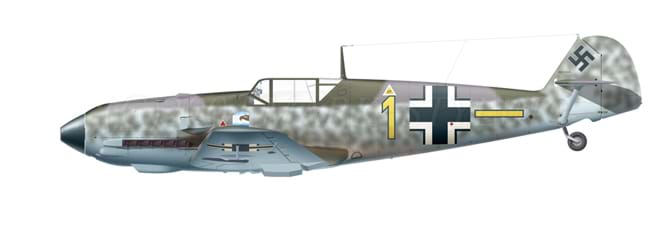

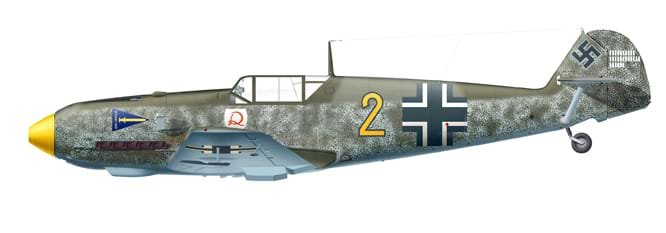

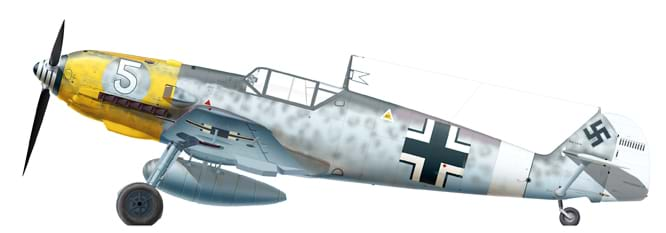

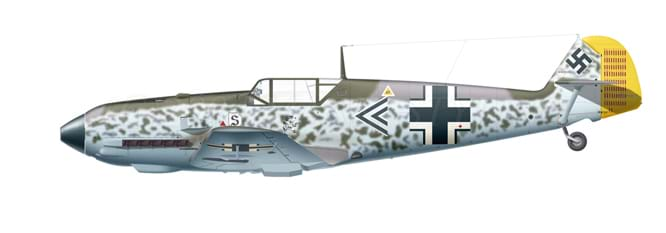

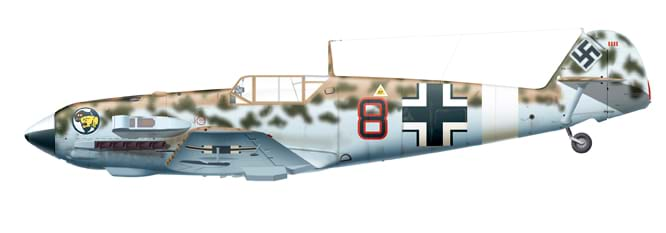
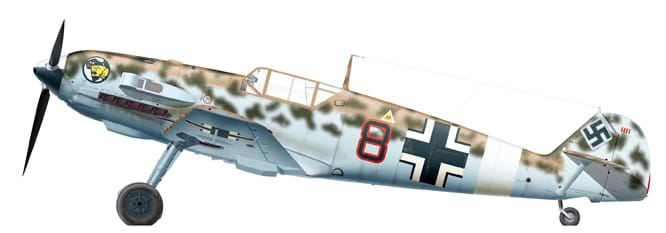


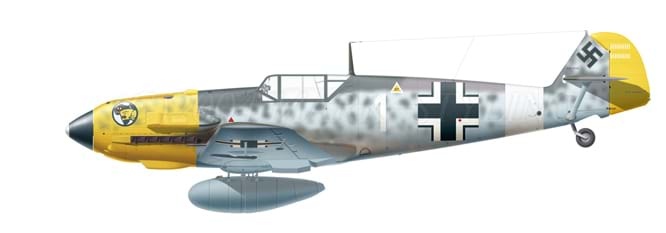
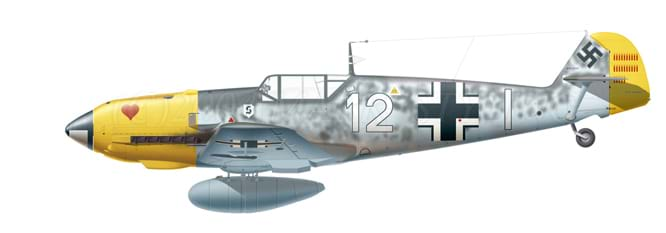
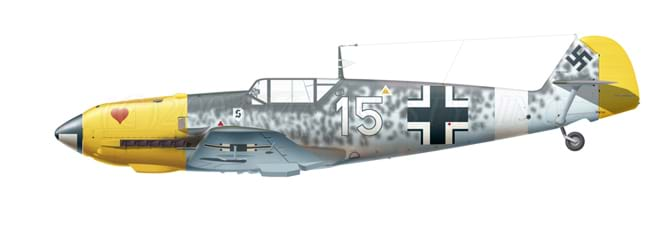

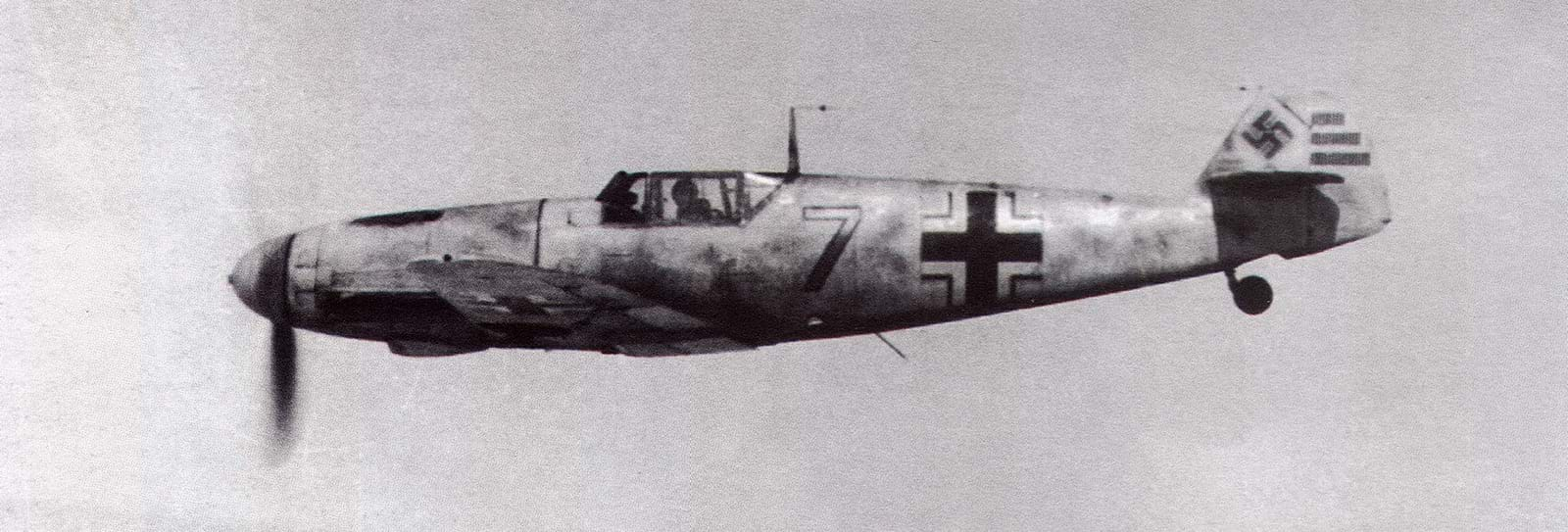
Bf 109F series
In early 1940, the Augsburg plant began a design improvement program with the intent of incorporating not only structural and aerodynamic modifications to the basic Bf 109 airframe, but also the installation of the higher performing powerplants that were then under development at Daimler-Benz
plant began a design improvement program with the intent of incorporating not only structural and aerodynamic modifications to the basic Bf 109 airframe, but also the installation of the higher performing powerplants that were then under development at Daimler-Benz Daimler-Benz AG was a German manufacturer of motor vehicles and internal combustion engines, which was founded in 1926. An Agreement of Mutual Interest – which was valid until 2000 – was signed on 1 May 1924 between Karl Benz's Benz & Cie. and Daimler-Motoren-Gesellschaft, which had been founded by Gottlieb Daimler and Wilhelm Maybach. Daimler had died in 1900, and Maybach had left in 1907.
Daimler-Benz AG was a German manufacturer of motor vehicles and internal combustion engines, which was founded in 1926. An Agreement of Mutual Interest – which was valid until 2000 – was signed on 1 May 1924 between Karl Benz's Benz & Cie. and Daimler-Motoren-Gesellschaft, which had been founded by Gottlieb Daimler and Wilhelm Maybach. Daimler had died in 1900, and Maybach had left in 1907.
Both companies continued to manufacture their separate automobile and internal combustion engine marques until 28 June 1926, when Benz & Cie. and Daimler-Motoren-Gesellschaft formally merged - becoming Daimler-Benz AG (Aktiengesellschaft) - and agreed that thereafter, all of the factories would use the brand name of "Mercedes-Benz" on their automobiles. The inclusion of the name Mercedes in the new brand name honored the most important model series of DMG automobiles, the Mercedes series, which were designed and built by Wilhelm Maybach. They derived their name from a 1900 engine named after the daughter of Emil Jellinek. Jellinek became one of DMG's directors in 1900, ordered a small number of motor racing cars built to his specifications by Maybach, stipulated that the engine must be named Daimler-Mercedes, and made the new automobile famous through motorsports. That race car later became known as the Mercedes 35 hp. The first of the series of production models bearing the name Mercedes had been produced by DMG in 1902. Jellinek left the DMG board of directors in 1909.
Although Daimler-Benz is best known for its Mercedes-Benz automobile brand, during World War II, it also created a notable series of aircraft, tank, and submarine engines. Daimler also produced parts for German arms, most notably barrels for the Mauser rifle. During World War II, Daimler-Benz employed slave labour.. The result of this program was the Bf 109F.
The airframe changes were numerous and resulted in an external configuration that was to remain essentially unchanged through the remainder of the Bf 109 variants. The wing, which had remained the same since the inİtial prototypes of the basic Bf 109, maintained the primary contours and spar structure, but incorporated a pair of significant modifications to reduce drag and improve lifting characteristics. First, the underwing radiators, which were a large contributor to the aircraft's drag, were decreased in height and recessed deeper into the wing through the use of a unique system of flaps and ducts which reduced the turbulence normally associated with the radiator protrusion into the airstream. The installation of this system also resulted in a change in the length and span of both the leading and trailing edge control flaps and the elimination of interconnecting linkage between the flaps and ailerons fitted previously.
A deeper, more streamlined cowling was also designed which tapered directly from the forward windscreen to the propeller hub and the air intake for the supercharger was moved farther into the airstream to increase the ram-effect of the scooped in air. The propeller hub, or spinner, was enlarged and lengthened to fit the new symmetrical cowling and contoured to reduce turbulent drag factors. In addition, the overall airscrew diameter was reduced by 10 cm (4 inch) through the use of wider blades.
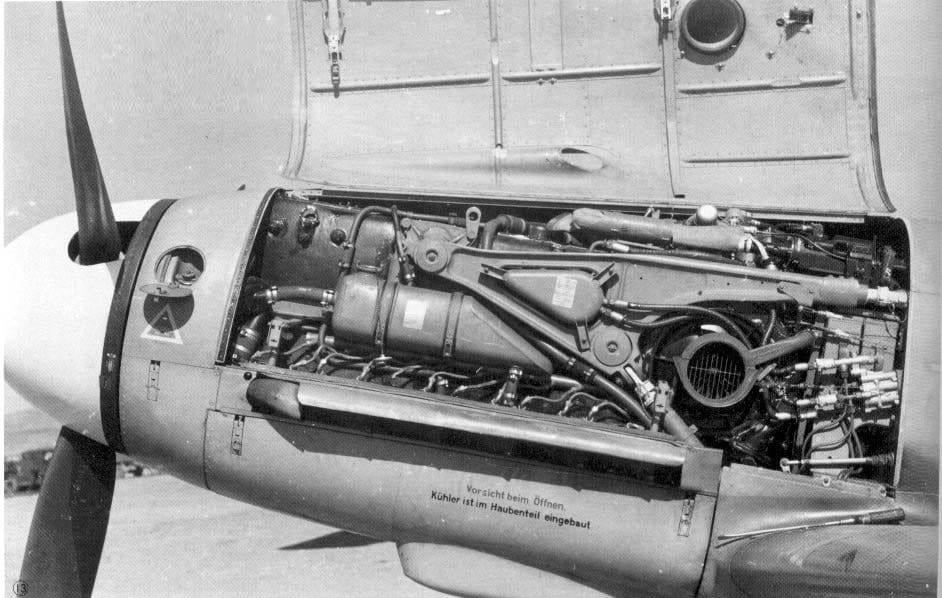
Major modifications also were incorporated into the tail assembly section where the rudder area was slightly reduced and the tail-plane bracing struts, which had become an identifying feature of earlier Bf 109s, were removed. With the removal of the struts, the new cantilevered tail-plane was moved slightly forward and below the original positioning and the chord thickness increased for structural rigidity.
Planned for installation of the DB 601E engine which provided 1,350 hp for take-off, the four Bf 109F prototypes and ten pre-production aircraft were initiated in May, 1940. However, service testing and acceptance of the DB 601E had not yet been completed and, as a consequence, powerplant substitutions had to be made.

The first prototype, Bf 109 V21 utilized the DB 601Aa which had powered the later E-series while the last three prototypes all had early development DB 601E's installed. The Bf 109 V22 was to be utilized primarily for testing of the powerplant while the V23 and V24 aircraft were scheduled to be used for minor modifications to the new design in the area of structural and flight handling characteristics. The most significant change from the initial Bf 109F configuration was incorporated into V23, when elliptically shaped detachable wingtips were added to increase the wing surface area (reducing wing loading) and to restore overall wingspan dimensions that had been reduced with the incorporation of the improved underwing radiator system. Armament for the Bf 109F was standardized with the retention of the cowling-mounted 7.9-mm MG 17 machine-guns and the addition of a 20-mm MG 151 cannon firing through the hollow propeller shaft. The reduction in armament from the Bf 109E, which had either a pair of MG 17 machine-guns or MG FF cannon mounted in the wings, was the result of several operational pilots' reports which maintained that the concentrated firepower of the center located weapons was more effective than the converging fire of the wing mounted weapons and that, in addition, the elimination of the wing armament added to the aircraft's handling characteristics.

Due to the continued delay in delivery of the planned DB 601E, the ten pre-production of Bf 109F-0s, which began rolling off the assembly lines in October 1940, were powered by the DB 601N engine with its flattened piston heads. The F-0s also were fitted with the older MG FF cannon in the nose as deliveries of the proposed electronically armed MG 151 and MG 151/20 (15-mm and 20-mm) were delayed.

Deliveries of the initial Bf 109F-1 variant, very similar to its predecessor, the Bf 109F-0, began in November. The only real discernible difference in appearance was in the installation of the new extended supercharger air intake. This replaced the rectangular flush-mounted air in-take from the E-series that had been used on the early pre-production aircraft until tests of the optimum contour and inlet size were completed on the improved design.
Within a few weeks of the initial deliveries of the Bf 109F-1s to Luftwaffe service evaluation units a number of them were lost, with the only clue as to the cause being a few pilot's messages reporting violent vibrations just prior to complete loss of control and crash. The Bf 109Fs were grounded and the cause of the vibration problem was investigated, with concentration in the powerplant attach interfaces and structural supports. Finding no irregularities, the investigation centered on the tail assembly, and it was discovered that the removal of the bracing sluts had resulted in a high frequency vibration being set up in the fuselage at certain engine rpm levels. The aircraft were retrofitted with reinforcing plates in the tail-plane to fuselage attachment area and production was resumed.
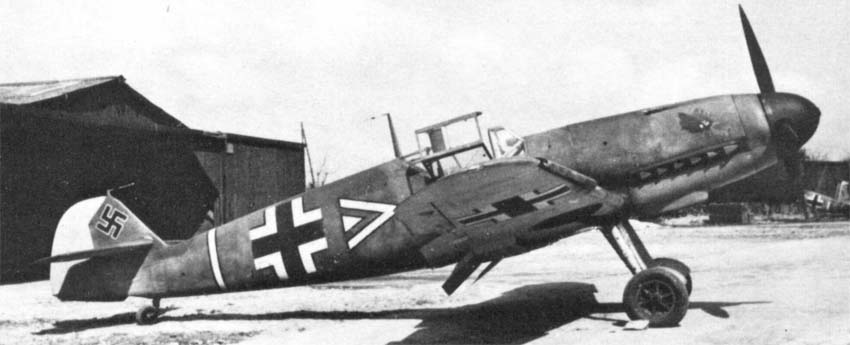
In February and March, 1941, deliveries of the Bf 109F-1 gave way to the production of the Bf 109F-2 which varied from the F-1 only in that it replaced the nose-mounted MG FF cannon with the long awaited MG 151. The F-2 variant also was modified through the incorporation of a fuselage-mounted ETC 250 bomb rack or the addition of the GM 1 Nitrous Oxide Power Boost SystemGM-1 (Göring Mischung 1) was a system for injecting nitrous oxide (laughing gas) into aircraft engines that was used by the Luftwaffe in World War II. This increased the amount of oxygen in the fuel mixture, and thereby improved high-altitude performance. GM-1 was used on a number of modifications of existing fighter designs in order to counter the increasing performance of Allied fighters at higher altitudes.
A different system for low-altitude boost known as MW 50 was also used, although GM-1 and MW 50 were rarely used on the same engine. MW-50 was a methanol-water injection system, which injected a mixture of methanol and water into the cylinders to cool the mix. Cooling causes the air to become denser, therefore allowing more air into each cylinder for a given volume. This is the same principle that intercoolers use.
GM-1 was developed in 1940 by Otto Lutz to improve high-altitude performance. It could be used by fighters, destroyers, bombers and reconnaissance aircraft, though its first use was in the Bf 109E/Z fighter. Originally, it was liquified under high pressure and stored in several high-pressure vessels until it was found that low-temperature liquefied nitrous oxide gave better performance due to improved charge cooling. It could also be stored and handled more conveniently and was less vulnerable to enemy fire.
GM-1 was typically sprayed in liquid form directly into the supercharger intake from two jets of different bore while at the same time, the fuel flow was increased to take advantage of the additional oxygen from the nitrous oxide. The jets could be operated individually or in combination, yielding three steps of power increase, for example 120/240/360 HP at different GM-1 flow rates (60, 100 and 150 grams/sec). The development of a continuously variable injection system was considered, but apparently it never saw operational use.
Initially intended as standard equipment for the Luftwaffe, in operational service it was found that GM-1 had some drawbacks. The additional weight of the equipment reduced performance on all missions, while the system was only used in the cases where the aircraft went to very high altitudes. GM-1 also became less attractive than originally imagined when in 1943, the previous trend towards ever increasing combat altitudes ended.
While GM-1 saw little use in the second half of the war, the Focke-Wulf Ta 152H, which had been developed as a dedicated high-altitude interceptor, also received a GM-1 system to provide it with superior performance at high altitude. The Ta 152H was one of the few designs to support both GM-1 and MW 50. on a number of aircraft. As the Luftwaffe had not standardized either the Umruest-Bausatze (factory installed modifications which intended to increase performance or to utilize non-strategic materials) or the Ruestsaetze (bolt-on modifications that were added to the Bf 109 airframe for specific mission capabilities such as extended range and increased armament, and which could be incorporated either at the assembly line or in the field), the above noted modifications to the F-2 variant resulted in the designations of Bf 109F-2/Z (addition of GM 1 boost system) and the Bf 109F-2/B (addition of the ETC 250 ventral bomb rack) fighter-bomber. One further designation was allocated to the F-2 series, the Bf 109F-2/Trop, which was the tropicalized version. Like the previous Bf 109E-4/Trop, this sub-type was fitted with a dust filter over the supercharger air intake for use in the North African theater of operations.
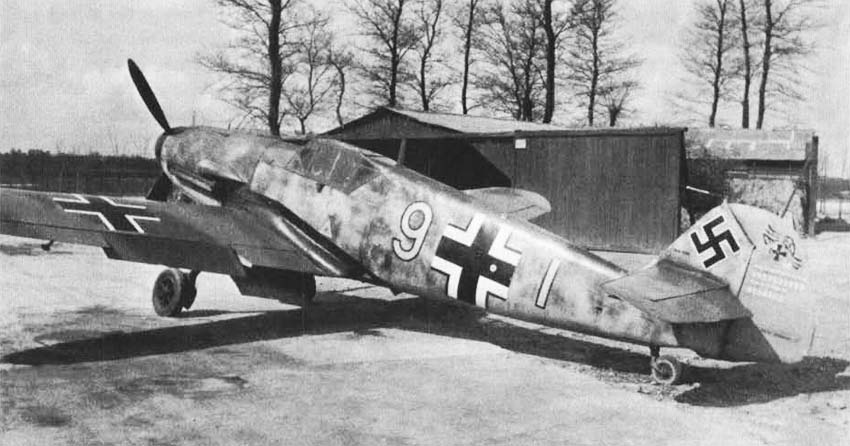
The Bf 109F-3 and Bf 109F-4, which were produced simultaneously, replaced the F-2 variant on the assembly lines in early 1942 and differed from the F-2 in that they incorporated the long awaited DB 601E as the basic powerplant. The powerplant change was the only difference between the F-2 and F-3; however, the F-4 incorporated a number of additional modifications that were not externally discernible. These included an increase in the calibre of the MG 151 from 15-mm to 20-mm, the use of new self sealing fuel tanks, and an increase in the armor protection for the pilot. This protection included a thick steel plate behind the pilot's neck and upper back, and a similar plate mounted over his head under the bullet-resistant canopy glass. Both the F-3 and F-4 utilized the FuG 7a radio transmitter/receiver and Revi C/12D reflector gunsight that were standard on the earlier F-series.

A number of Bf 109F-4s were also modified like the F-2 variant with the incorporation of the GM 1 nitrous oxide boost system (Bf 109F-4/Z). In addition, two further sub-type conversions were produced under the Bf 109F-4 designation. The first of these was the Bf 109F-4/R6 which was fitted with an extra pair of 20-mm MG 151 cannon in underwing gondolas. The increase in firepower was made at the request of General Adolf Galland and other top Luftwaffe fighter aces. The additional armament of the F-4/R6 was well received. The increased weight and added drag had a detrimental effect on the aircraft's handling qualities, however, reducing its capability as a "dogfighter", and the aircraft were used strictly as bomber-interceptors.

The second conversion was similar to that of the earlier fighter-bomber modifications to the Bf 109E-4/B and included attachment of the ventrally-mounted ETC 250 bomb rack capable of carrying a 250 kg (550 lb) bomb, a 300 lt (66 Imp gal) jettisonable fuel tank, or with an ER 4 adapter, four 50 kg (110 lb) SC 50 bombs.

The final two variants of the Bf 109F series were reconnaissance derivatives of the Bf 109F-4. The Bf 109F-5 eliminated the nose mounted cannon (for reduced weight and, thus, higher speed) and had a Rb 50/30 camera mounted in the aft fuselage. The Bf 109F-6 eliminated all armament and was fitted with a special camera bay in the underside of the fuselage just aft of the cockpit which was capable of utilizing Rb 20/30, Rb 50/30 or Rb 75/30 cameras. Both the F-5 and F-6 were fitted with a fuselage rack (R3 modification) for the 300 lt (66 Imp gal) auxiliary fuel tank.
Bf 109F-4 Specifications
Take-off 1350 hp
Max 1300 hp at 5500 m (18,045 ft)
557 km/h at 3000 m (346 mph at 9840 ft)
624 km/h at 6500 m (388 mph at 21,325 ft)
Length: 9.048 m (29 ft 8 inch)
Height (ground to canopy): 2.6 m (8 ft 6.25 inch)
Bf 109F Illustrations
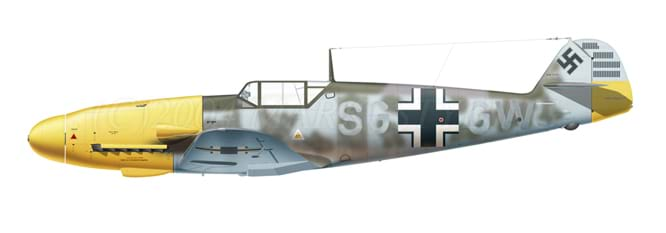




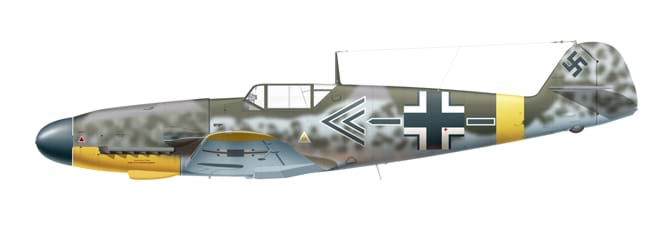










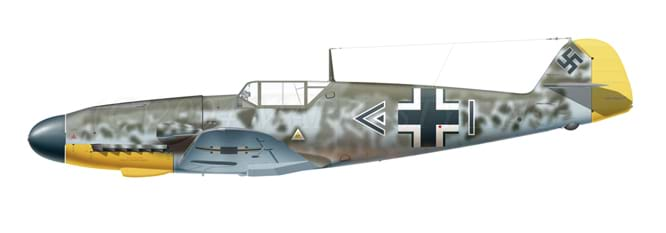

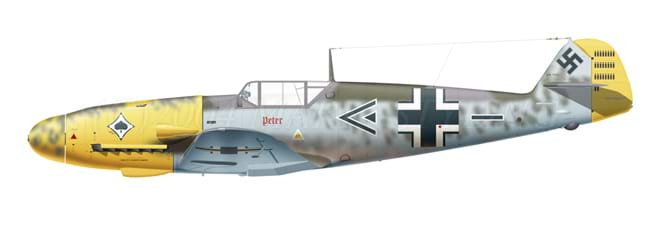

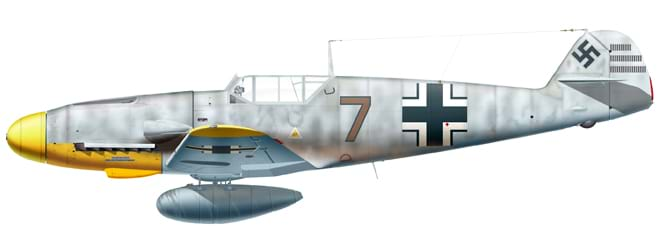
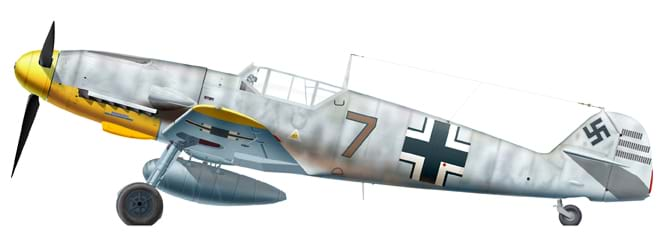


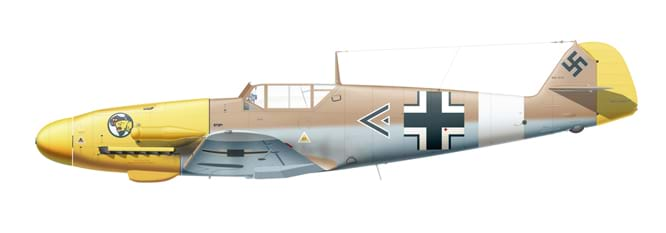
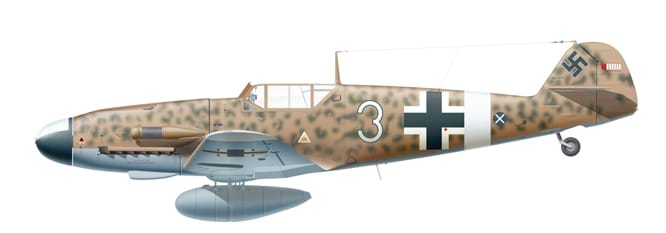







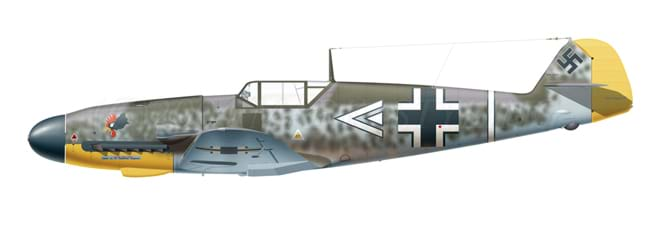





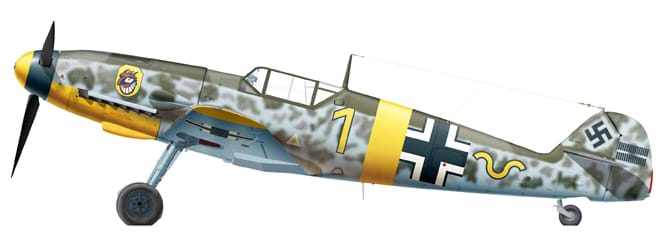
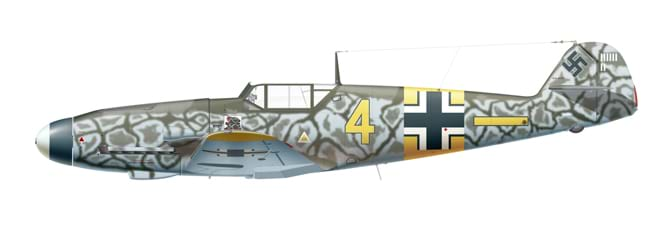
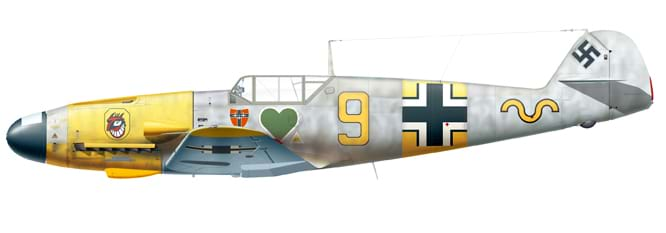
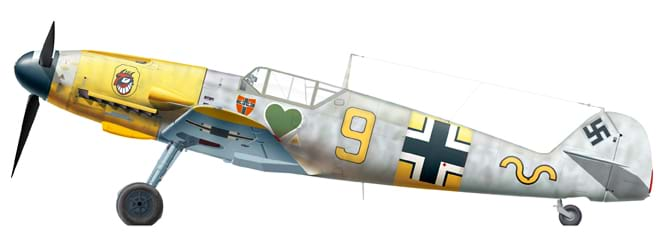

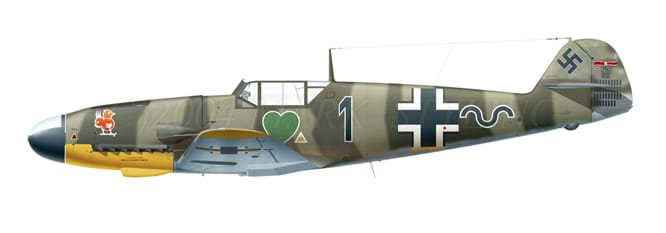


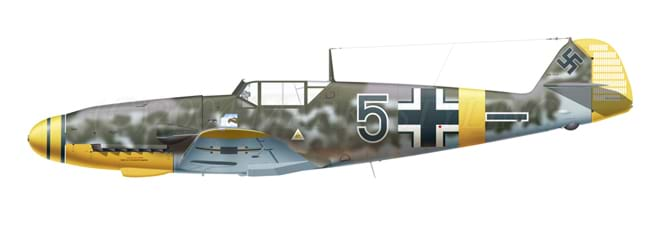



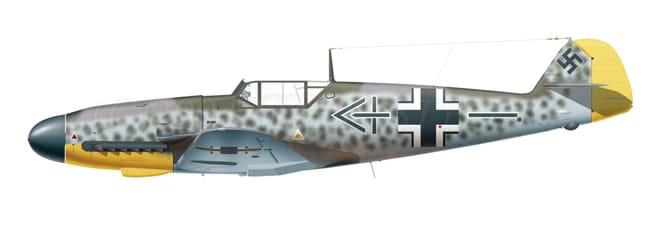

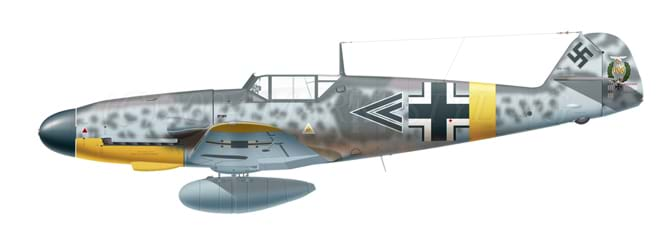
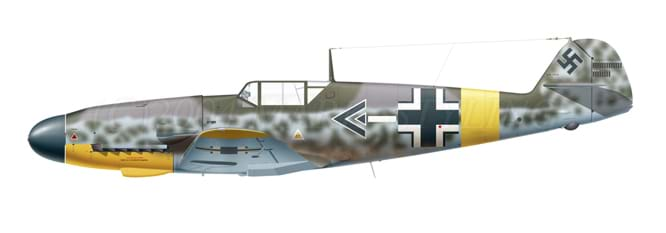





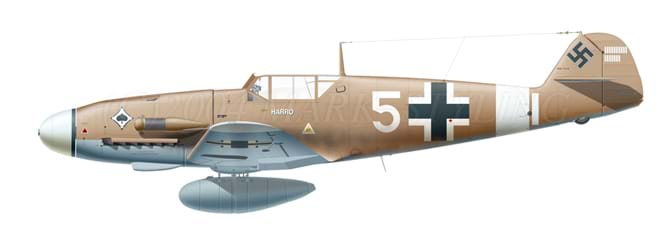
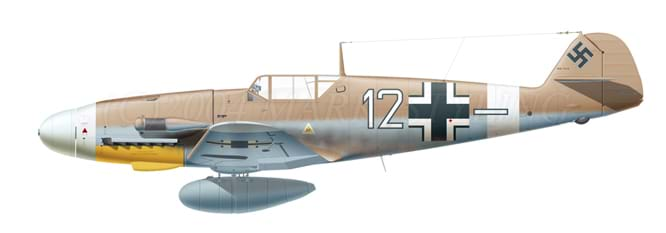


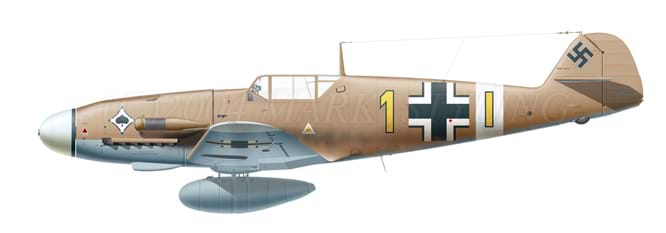


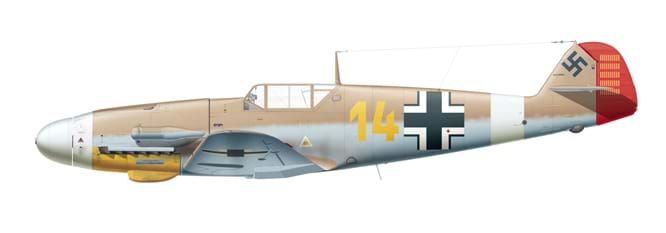
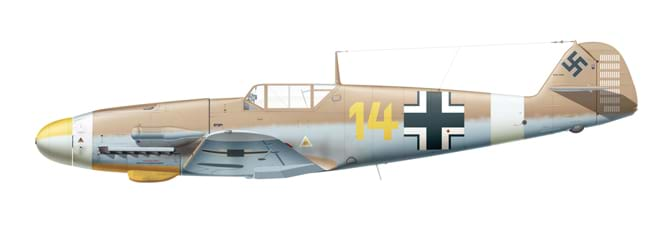


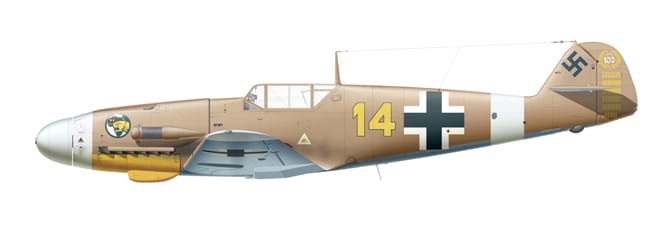
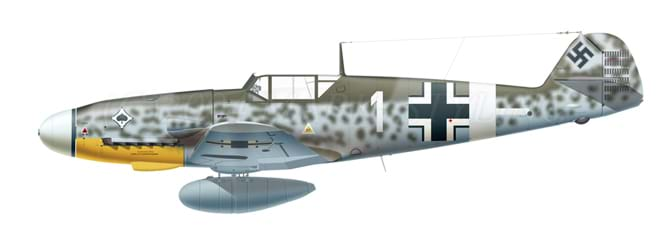


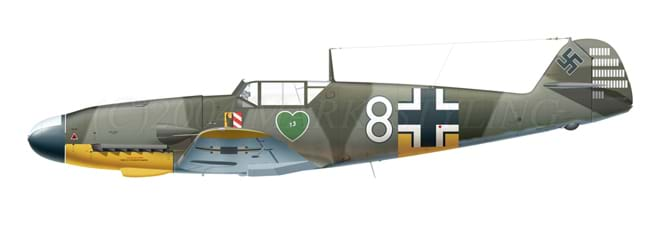

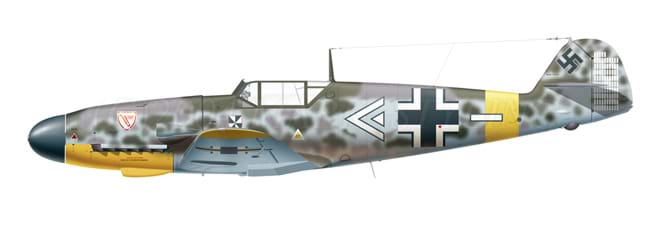

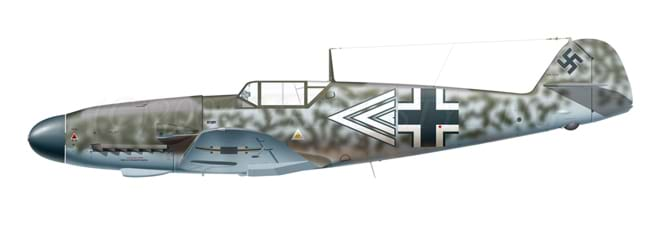



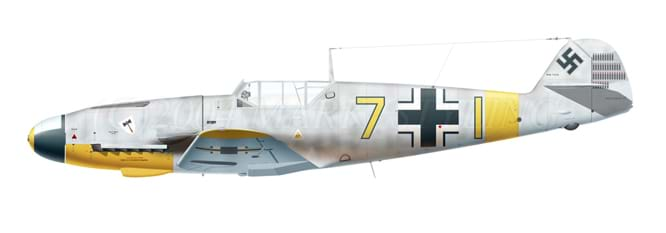

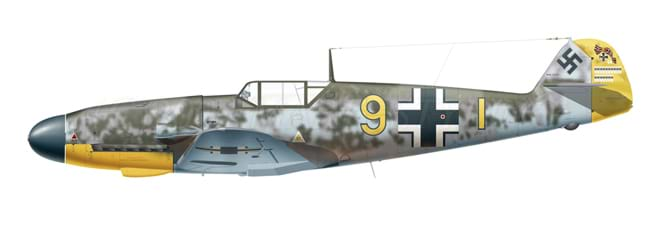



Bf 109G series
During late 1941 and early 1942, the RLM became increasingly concerned with higher aircraft speeds and was willing to accept higher wing and power loading risks. The necessity for a pressurized canopy was also among the requirements for higher altitude capability. The Bf 109G was to be their answer.

The G-version was planned to utilize the improved performance DB 605A powerplant with a take-off output of 1,450 hp and 1,250 hp at 20,000 feet. The only difference in the DB 605A and the then-popular DB 601E was that the new powerplant had a redesigned block which allowed oversized cylinders while maintaining the same centers. The increased volume raised the compression ratio while the basic dimensions of the overall engine remained the same. The installation of the DB 605A into the Bf 109G airframe, however, resulted in numerous structural changes as the new powerplant was not only more powerful (in torque), but was also heavier. As a consequence the weight spiral of the overall Bf 109 design continued upward, reducing handling and maneuvering characteristics.
To provide the necessary cockpit pressurization, Messerschmitt simply sealed the bulkheads, floorplate and sidewalls, incorporated a plate behind the pilot which seated with the fuselage wall on closure, and added seals to the hinged and open rails at the canopy to fuselage interfaces.

Construction of twelve pre-production Bf 109G-0s was started during the late summer of 1941, but the unavailability of the proposed DB 605A powerplant forced Messerschmitt to again substitute, this time with the DB 601E. The pre-production block was completed by October, 1941, and immediately, Messerschmitt set about initiation of the first production aircraft under the designation Bf 109G-1. The G-1, deliveries of which began in March, 1942, was fitted with a pressurized cockpit, incorporated the radio equipment of the Bf 109F-4 (FuG 7a) and was armed with an engine-mounted 20-mm Mauser MG 151 cannon with 200 rounds of ammunition and a pair of cowling mounted 7.9-mm MG 17 machine-guns with 500 rounds per gun. The G-1 was powered by the DB 605A-1 OR DB 605B-1 and included provisions for mounting the GM 1 nitrous oxide power boost system, with the main tank and liquid oxygen bottles being located behind the cockpit.

One additional modification to the G-1 that was not present on the G-0 models included the fitting of a pair of small air scoops just aft of the propeller hub on both sides on the fuselage. These air scoops were to provide direct airstream cooling of the powerful DB 605A engine, which during prolonged ground operation (such as extended taxiing) had a tendency to overheat causing the nose-mounted oil tank to seep over the hot engine. Fires could occur immediately, in which case shut-down solved the problem. In the air, where shut-down was not possible, the only solution was bailing out. In addition to the air scoops, the G-1 included an oil tank that was redesigned to allow for cooler operation and better sealing.
Sub-types of the G-1 variant during production included several Ruestsaetze and Umruest-Bausatze conversion kits.
- G-1/U-1: Evaluation aircraft incorporating a reversible-pitch Messerschmitt P-6 propeller. The propeller was to act like a thrust reverser on short field landings by redirecting airflow. Only a few of this model was delivered.
- G-1/R3: Long range fighter with the addition of an under-fuselage rack for the fitting of a 300 lt (66 Imp gal) auxiliary fuel drop tank.
- G-1/R6: Fighter/interceptor with a pair of 20-mm MG 151 cannon in underwing gondolas assigned to the bomber attack role.
- G-1/Trop: A specialized tropicalized version of the G-1 variant for use in North Africa. Because of continual overheating problems with the engine-mounted cannon in the desert heat, this model also replaced the cowl-mounted 7.9-mm MG 17 machine-guns with a pair of 13-mm MG 131 machine-guns to provide greater firepower if malfunctioning of the nose cannon occurred. The aircraft also was fitted with the appropriate dust filters for the supercharger intake and radiator areas.
It should be noted here that the possibility of more than one conversion kit being added to an aircraft existed, and often became the rule as the war progressed. In most instances, however, the specified aircraft only carried a single designation. For example, a Bf 109G-1/R6 could have not only been fitted with the underwing MG 151 cannon, but could also have had an underfuselage bomb rack (fighter bomber) or auxiliary fuel drop tank shackle (extended range fighter/interceptor) added.

Produced in parallel with the Bf 109G-1, and in greater quantities, the Bf 109G-2 was identical except that it did not contain a pressurized cockpit or GM 1 power boost system. Sub-types of the basic Bf 109G-2 were also identical to those of the Bf 109G-1.

One unique experimental evaluation conducted on the Bf 109G-2 was a design for the development of an extended range fighter-bomber. A Bf 109G-0 (pre-production aircraft) was refitted with a DB 605A and redesignated Bf 109G-2/R-1 for this test. The basic problem was in the size of the SC 500 bomb that was planned to be carried, in that it did not provide adequate clearance for takeoff when attached. To solve the problem, Fieseler designed an auxiliary single-wheel undercarriage component that could be attached to the underside of the fuselage just aft of the bomb, raising the aircraft off the ground. The undercarriage could be released after take-off through a series of explosive bolts and returned to the ground by parachute. To increase range, the plane was also fitted two racks of shackles for attachment of a pair of 300 lt (66 Imp gal) drop tanks. After successful initial flight testing, however, the project was discontinued.

In April, 1942, the Bf 109G-4 was introduced into the assembly lines. The only major changes between it and the previous models were that it was not pressurized and had replaced the FuG 7a radio equipment with the newer and longer range FuG 16ZY equipment.
Although designated as a photo-reconnaissance fighter to be fitted with a camera installation in the aft fuselage, the Bf 109G-4 was delivered in several variants, and functioned in a number of additional roles for the Luftwaffe. In addition to the modified variants produced under the G-1 and G-2 designation, the G-4 also was ordered and/or delivered in the R1, R2, R4 and R7 models.
- G-4/R1: Limited production fighter-bomber fitted with ventral bomb rack for carrying a SC 250 bomb.
- G-4/R2: Authorized fighter-bomber version incorporating the ETC/VIIId bomb rack capable of carrying four SC 50 bombs; however, this model was never delivered.
- G-4/R4: Reconnaissance fighter incorporating an Rb 50/30 camera and a pair of wing mounted 300 lt (66 Imp gal) drop tanks. This model, like the R2, never reached production.
- G-4/R7: Standard fighter fitted with directional finding equipment installed inside the aft fuselage behind the cockpit, including a D/F loop antenna, to facilitate the locating of the aircraft in poor weather, poor visibility or after a crash landing.

With the introduction of the G-4 into service in August, 1943, the next version of the G-series to reach production status was the Bf 109G-3. This aircraft was nearly identical to the Bf 109G-4 in basic equipment, except that it incorporated the pressurized cockpit and GM 1 power boost system of the G-1 version and was designated for high altitude operation. Although relatively few Bf 109G-3s were delivered to Luftwaffe units, it was produced in a number of models including R1, R2, R3, R6 and U2. The Bf 109G-3/U2 represented the first model of the Bf 109 series to use a non-strategic material in a major component. In this case, the tailplane was made of wood and a larger trim tab was included that was controllable from the cockpit. This aircraft was utilized for test and evaluation, with the wooden tailplane later being installed on several future G-series variants, except for the G-14 which utilized an entirely redesigned tailplane shape.


In addition, the Bf 109G-3 was the first G-series aircraft to exhibit wing surface bulges resulting from the use of larger tires necessitated by the increased weight of the G-series aircraft. The larger mainwheels, in addition to offering higher safety factors, required an increased area in the innerwing when retracted, and as the initial volume had been allocated to the smaller standard wheels of earlier variants, Messerschmitt either had to redesign the wing chord (which would mean complicated and extended testing), or add a slight drag-increasing bulge to the wing surface. The Bf 109G-5 entered production during the late June and early July of 1943, but did not appear with Luftwaffe units until January, 1944. The G-5 was powered by the DB 605A-1 engine, but in an effort to provide more efficient high altitude performance, was also delivered with an optional DB 605AS powerplant which was fitted with a larger supercharger. (Aircraft receiving the DB 605AS were designated with the alters AS after the variant, or Ruestsaetze (R), identification.) Armament of the Bf 109G-5 consisted of the engine mounted 20-mm MG 151 cannon and a pair of cowl-mounted 13-mm MG 131 machine-guns, which had been standardized for all future G-series variants. The increase in the size of the cowling weaponry resulted in still another set of external bulges, this time over the MG 131 breech blocks and ammunition feed chutes which were larger than those of the MG 17s.
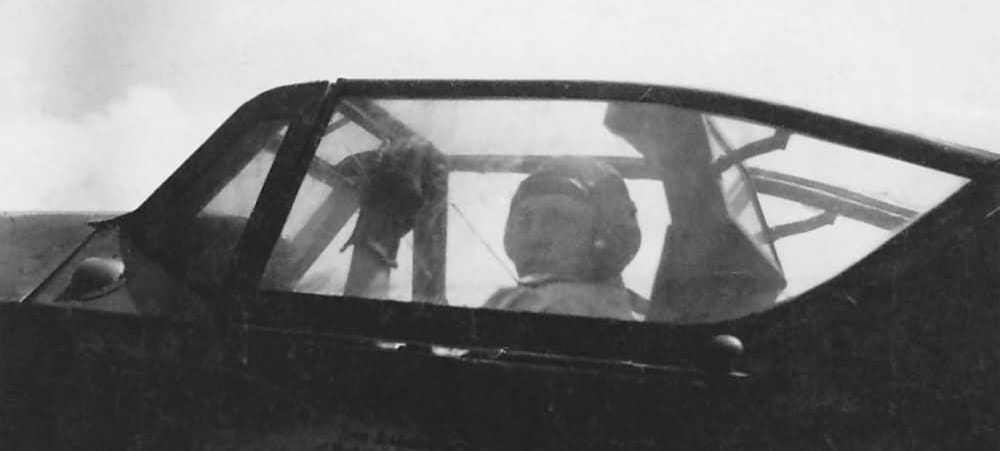
The Bf 109G-5 was also fitted with a shorter radio mast and a directional finding loop antenna on later models, which incorporated the R7 directional transmitter inside the aft fuselage. One additional modification that was installed in the Bf 109G-5 was the improved vision “Galland” canopy which restructured the canopy braces and added bullet-resistant glass and thicker armor plate in key areas. This canopy was installed on a few late model G-5s, but did not become standard until the introduction of the G-14 variant.
Sub-types designations of the Bf 109G-5 to see service included the U2, R3, R6, R7 and the Trop., while authorization and plans for production of R1 and R2 models were received, but never started.
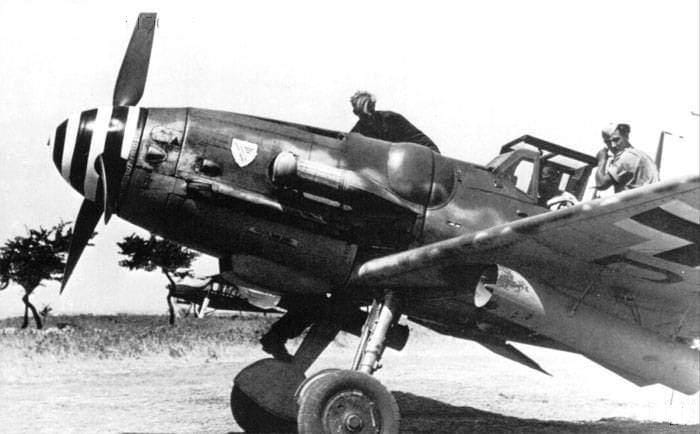
One unique modification into G-5 was the addition of a pair of underwing Wfr. Gr. 210-mm mortar tubes for operations against Allied bomber streams. Designated as the Bf 109G-5/BR 21, the mortar tube concept was actually developed and flown initially on the Bf 109G-6 which preceded the G-5 variant in delivery to service units.
As noted above, the Bf 109G-6, although put into production at the same time as the Bf 109G-5, actually entered service first. It was identical to the G-5 variant except that it did not have provisions for cockpit pressurization. Produced in essentially the same models as previous G-series variants, the G-6 modifications also included the U2, U3, U4 and N designations. The Bf 109G-6/U3 identified the aircraft as being fitted with the MW 50 water-methanol supercharger boost system. Utilizing the tanks located behind the cockpit (used for the GM 1 system), the MW injectant, composed of 50% water and 50% methanol, was fed into the supercharger below the rated altitude of the powerplant to increase power through higher boost pressures. This system could increase take-off performance by over 300 hp, and provide similar power boosts up to altitudes of 6000 m (20,000 ft).


The Bf 109G-6/U4 was the result of continuing efforts by the RLM and Messerschmitt to increase the firepower of the Bf 109. The U4 modification incorporated an engine-mounted 30-mm MK 108 short barrel cannon in place of the 20-mm MG 151. Manufactured by Rheinmetall, the MK 108 had a rate of fire of 450 rounds per minute, was electrically actuated and automatically operated through a compressed air system separate from the weapon. Although a large number of G-6s were scheduled to receive the U4 modification, the limited supply of MK 108s restricted its application and forced the retention of the MG 151 in most models.

The Bf 109G-6/N was a modification derived specifically for the night-fighting role. (As opposed to use of the “N” designation in the E-series to identify use of the DB 601N.) The aircraft featured exhaust shields and flame dampers (to reduce the emission of light during nigh flying), the Ruestsaetz 6 (R6) conversion kit (which incorporated a pair of MG 151 cannon in underwing gondolas), and was fitted with the FuG 350 Naxos Z electronic receiver. This receiver was capable of homing on the H2S radar used by the Royal Air Force pathfinder aircraft, allowing the Bf 109G-6/N not only to locate the Allied bomber stream without ground guidance, but also to vector other airborne Luftwaffe interceptor units to the target. For the installation of the FuG 350, a transparent hemispherical dome was fitted just aft of the cockpit and the D/F loop was relocated to the underside of the fuselage.

The Bf 109G-8, entering production in late 1943, was a photo-reconnaissance variant of the Bf 109G-6 and G-8 had given way to the Bf 109G-10, which was intended to standardize several of the Umruest-Bausatze modifications, including the wooden tailplane, MW 50 power boost system, and semi-retractable tailwheel assembly. Because of the numerous assembly plants engaged in producing the Bf 109G, however, and the limited availability of several of the components as a result of continuous Allied raids against the supplying plants, a formalized standard Bf 109G-10 was never achieved.


The Bf 109G-10 was powered by the DB 605D engine coupled with the MW 50 power boost system and delivered an impressive 1,850 hp at take-off. The new powerplant had been fitted with a larger diameter supercharger and the compression ratio was increased by 15% through redesign of the cylinders. The cowl-mounted MG 131 machine-guns were retained and either an engine-mounted MK 108 or MG 151 cannon incorporated, depending on supply. The G-10 also was fitted with the FuG 16ZY radio and FuG 25a IFF equipment, and a Revi 16B reflector gunsight replaced the previous Revi 12D.
Like other variants of the Bf 109G series, the Bf 109G-10 was delivered in various sub-types which incorporated a number of Umruest-Bausatz and Ruestsaetze conversions.
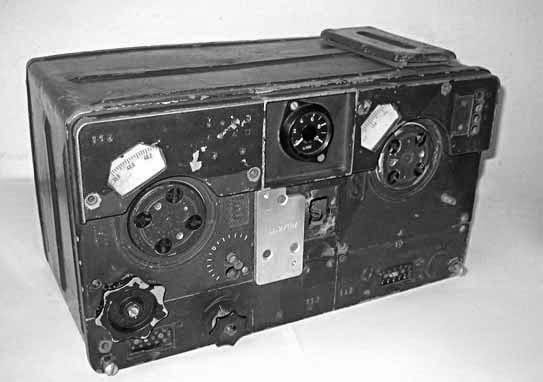
- G-10/U2: Adaptation of the non-strategic wooden tailplane.
- G-10/U4: Adaptation of U2 wooden tailplane and the addition of a redesigned and enlarged rudder, also fabricated as a wooden structure.
- G-10/R1: Fighter-bomber adaptation with a ventral rack for carrying a single 250 kg (550 lb) SC 250 bomb or four 50 kg (110 lb) SC 50 bombs.
- G-10/R3: Extended range fighter with adaptation of fuselage rack for attachment of 300 lt (66 Imp gal) drop tank.
- G-10/R5: Interceptor with addition of a pair of underwing gondolas carrying 30-mm MK 108 short barrel cannon.
- G-10/R7: Although not designated as R7 due to more than one Ruestsaetze modification being used, the installation of the R7 location signal device saw wide usage on the G-10 series.

One of the more unique of the G-series variant was the Bf 109G-12 which was a two-seat training conversion of the basic Bf 109G airframe. Studies for this sub-type had been started with the Bf 109E version in 1940 (under the designation Bf 109S), but the concept had not been authorized until late 1942 when pilot training in the Bf 109 had been accelerated. For the prototype of this variant, a Bf 109G-5 was modified through removal of the pressurization equipment, and the incorporation of an elongated canopy with a second set of controls and pilot instruments. The canopy housing was hinged in the student’s location, with the aft portion being curved outward to five the instructor a better view. A large number of G-6 and G-6 aircraft were converted to the G-12 straight from the assembly line never became a reality due to the pressing need for increased fighter strength and the limited availability of components. One Ruestsatz that was added to the G-12 variants was the R3, which provided the training flights with increased range and endurance through the installation of the 300 lt (66 Imp gal) auxiliary fuel drop tanks.

By July, 1944, still a further variant of the Bf 109G series was being delivered to the Luftwaffe, this being the Bf 109G-14. Utilizing the DB 605AS or DB 605AM powerplants, and standardized in the incorporation of the “Galland” type canopy first used on the G-5, the G-14 was armed with the pair of cowl-mounted MG 131 machine-guns and an engine-mounted 20-mm MG 151 cannon. Although only a limited number of this variant were produced due to the impending introduction of the Bf 109K, several modifications were adapted including theU4, U6, R1, R3 and R6. The U6 conversion was the installation of the longer barrel 30-mm MK 103 cannon as an engine-mounted weapon in place of the 20-mm MG 151.
The final production variant of the Bf 109G series was the G-16, which was essentially identical to the G-14 except that it reverted back to use the DB 605D powerplant and had standardized installation of the R1 (ventral bomb or drop tank rack) and R6 (underwing mounted 20-mm MG 151 cannon in gondolas) at the factory.
Bf 109G-6 Specifications
Take-off 1475 hp
Max 1355 hp at 5700 m (18,700 ft)
590 km/h at 2000 m (366 mph at 6560 ft)
600 km/h at 3000 m (372 mph at 9840 ft)
620 km/h at 6900 m (386 mph at 22,640 ft)
5700 m (18,700 ft) 6 min
Length: 9.048 m (29 ft 8 inch)
Ground Height: 2.5 m (8 ft 2.25 inch)
Elevated Height: 3.2 m (10 ft 5.875 inch)
Ground to Canopy: 2.6 m (8 ft 6.25 inch)
Stabilizer Span: 3.0 m (9 ft 10 inch)
Prop Diameter: 3.0 m (9 ft 10 inch)
Wheel Track: 2.065 m (6 ft 9.375 inch)
Bf 109G Illustrations


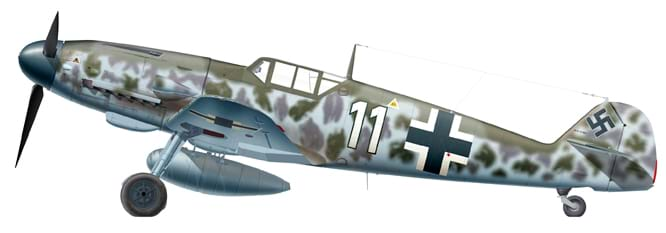





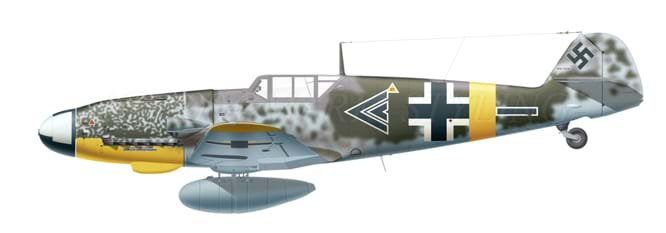

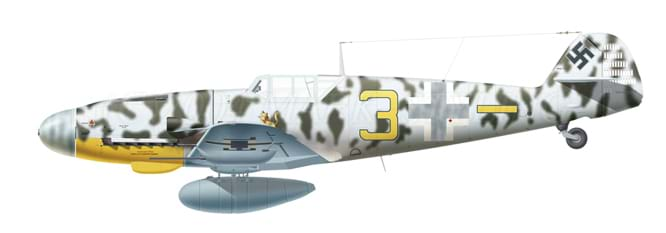




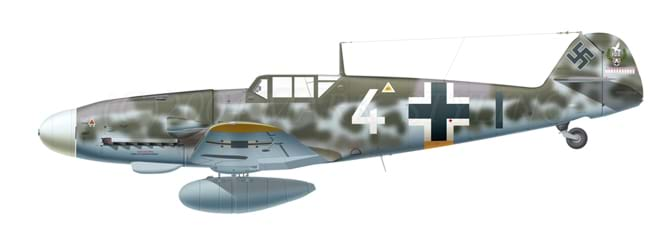

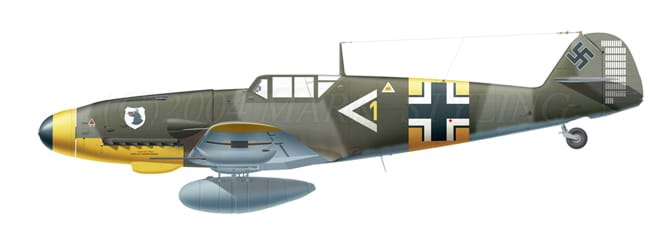
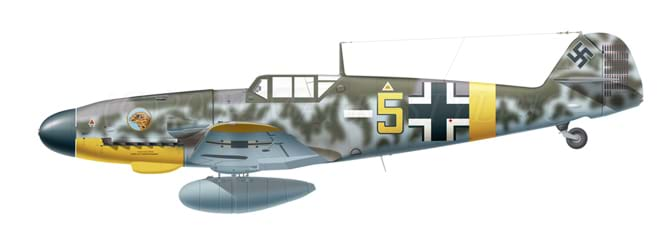



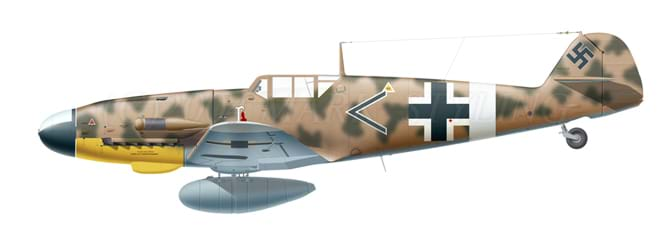

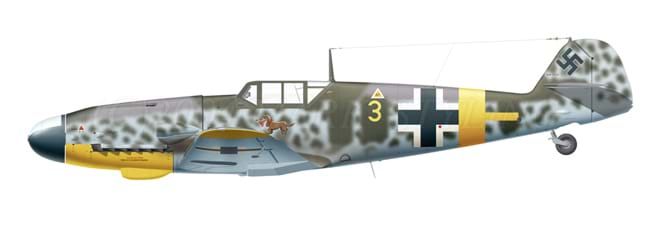



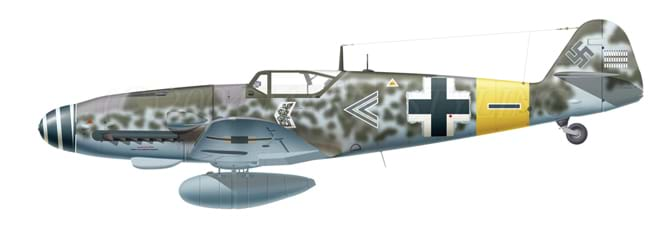








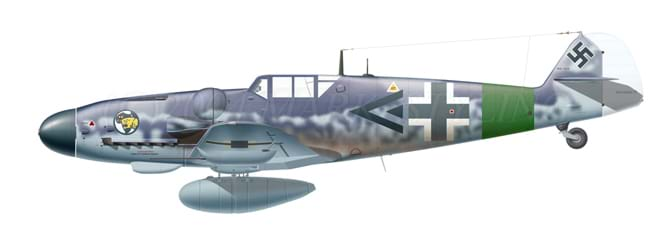

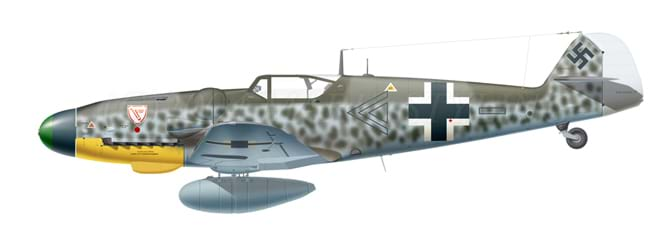
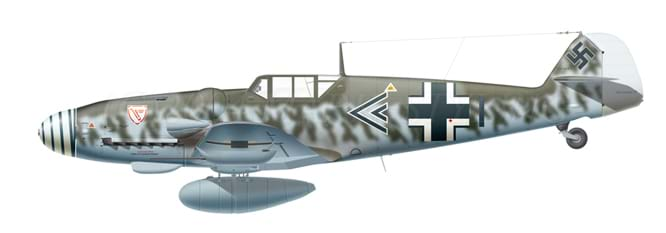

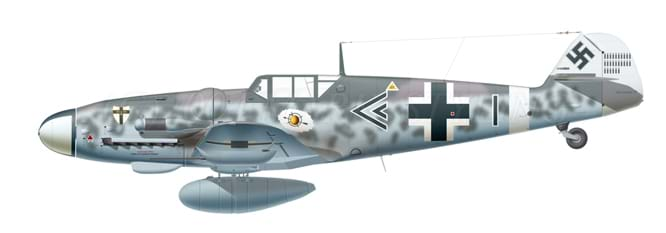

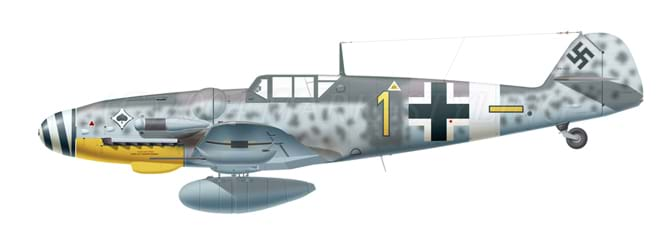



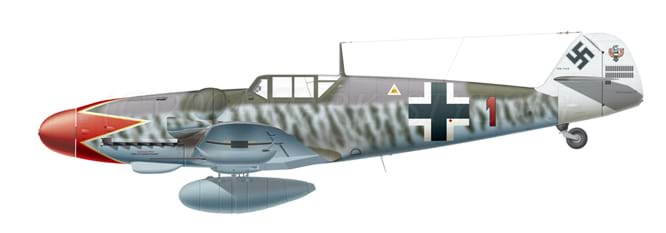

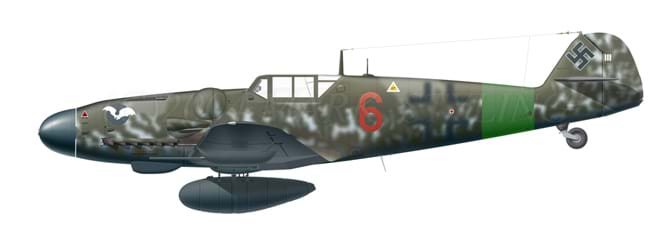
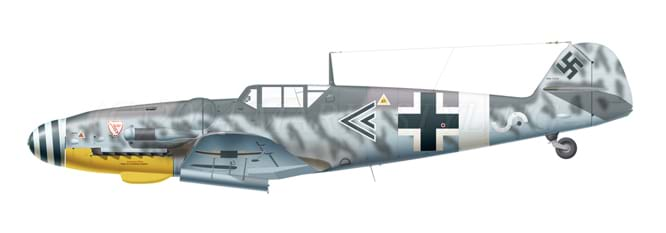
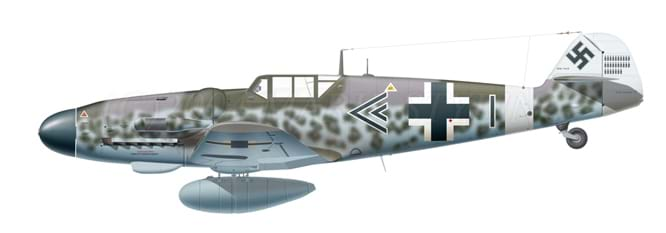




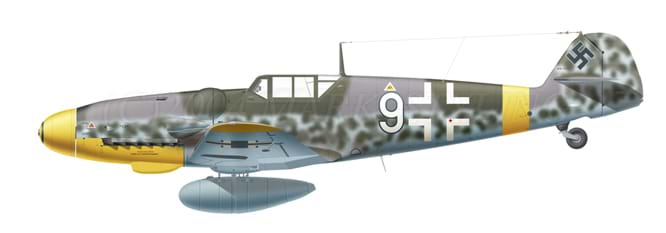


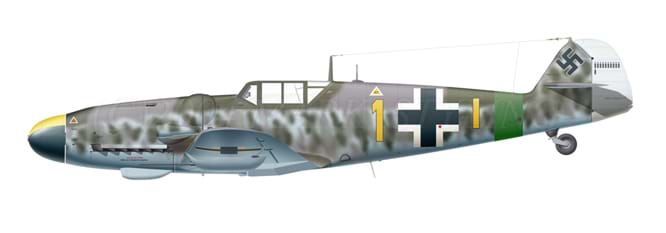

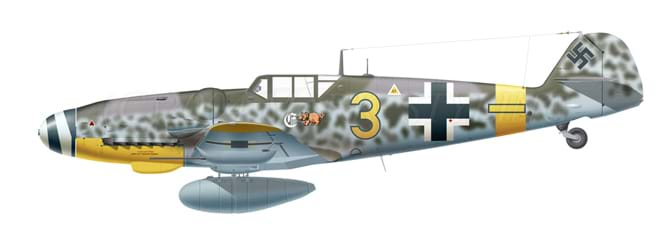

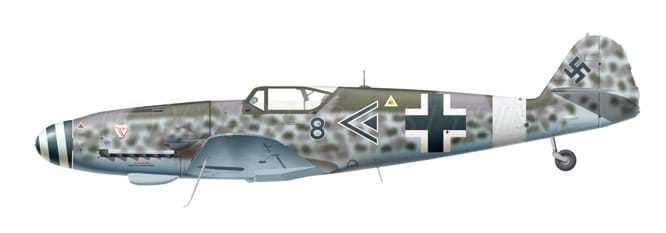


Bf 109H series
The Bf 109H was the result of a proposal by Messerschmitt A.G. to the RLM to provide a high-performance high altitude interceptor. The request from the German Air Ministry in early 1943 was based on the increasing need of the Luftwaffe for a fighter plane that could intercept and combat the Allied bombers at high altitudes, or use the advantage of altitude for escape or to surprise the enemy.
The Hochleistungsjaeger (High performance fighter) was proposed to be produced in two separate phases. First, an interim or temporary aircraft would be delivered to the Luftwaffe to provide capabilities during the design and development of the advanced, or second phase, fighter. The Bf 109H was proposed to serve as the interim aircraft.

The original Bf 109H was almost identical to the Bf 109F, utilizing the basic airframe, but had an extended center section of the wing which increased surface area for high altitude operation. However, changing RLM requirements during 1943, especially increases in operating altitudes, resulted in the abandonment of the original Bf 109H concept. Instead, an alternate Messerschmitt proposal was made to proceed on the Me 209-II programme which was to incorporate either a DB 628A or DB 603E powerplant. These engines were specifically developed with turbo-supercharger for high altitude operations.
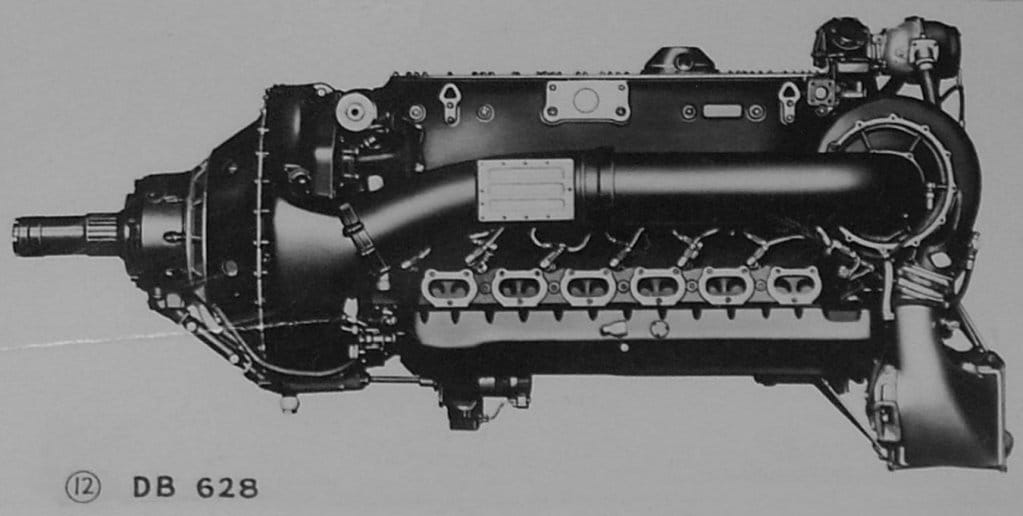
Realizing that Messerschmitt could not deliver the Me 209-II before 1944, and recognizing the importance of receiving a new interceptor as soon as possible, the RLM instructed Messerschmitt to proceed with the basic Bf 109H program, but to modify the configuration to utilize several of the Me 209-II components, including the DB 628A engine. Due to the fact that a Bf 109G airframe had already been modified to accept a mock-up of the DB 628A powerplant as a prototype (Bf 109 V49) and proved the concept’s feasibility for the Me 209-II project, a second Bf 109G airframe was diverted from the assembly line (designated Bf 109 V50) and installed with a development engine for flight testing.
Being nearly 180 kg (400 lbs) heavier and some 60 cm (2 ft) longer than the standard DB 605 powerplant used in the Bf 109G, installation of the DB 628A into the Bf 109H prototype required the use of balance weights in the aft fuselage to insure maintaining of the aircraft center-of-gravity. This was to be compensated for in later models through the forward movement of the main wing attach points and an increase in the tail and rudder surfaces.

After initial flight trials at Augsburg , the V50 was transferred to Daimler-Benz
, the V50 was transferred to Daimler-Benz Daimler-Benz AG was a German manufacturer of motor vehicles and internal combustion engines, which was founded in 1926. An Agreement of Mutual Interest – which was valid until 2000 – was signed on 1 May 1924 between Karl Benz's Benz & Cie. and Daimler-Motoren-Gesellschaft, which had been founded by Gottlieb Daimler and Wilhelm Maybach. Daimler had died in 1900, and Maybach had left in 1907.
Daimler-Benz AG was a German manufacturer of motor vehicles and internal combustion engines, which was founded in 1926. An Agreement of Mutual Interest – which was valid until 2000 – was signed on 1 May 1924 between Karl Benz's Benz & Cie. and Daimler-Motoren-Gesellschaft, which had been founded by Gottlieb Daimler and Wilhelm Maybach. Daimler had died in 1900, and Maybach had left in 1907.
Both companies continued to manufacture their separate automobile and internal combustion engine marques until 28 June 1926, when Benz & Cie. and Daimler-Motoren-Gesellschaft formally merged - becoming Daimler-Benz AG (Aktiengesellschaft) - and agreed that thereafter, all of the factories would use the brand name of "Mercedes-Benz" on their automobiles. The inclusion of the name Mercedes in the new brand name honored the most important model series of DMG automobiles, the Mercedes series, which were designed and built by Wilhelm Maybach. They derived their name from a 1900 engine named after the daughter of Emil Jellinek. Jellinek became one of DMG's directors in 1900, ordered a small number of motor racing cars built to his specifications by Maybach, stipulated that the engine must be named Daimler-Mercedes, and made the new automobile famous through motorsports. That race car later became known as the Mercedes 35 hp. The first of the series of production models bearing the name Mercedes had been produced by DMG in 1902. Jellinek left the DMG board of directors in 1909.
Although Daimler-Benz is best known for its Mercedes-Benz automobile brand, during World War II, it also created a notable series of aircraft, tank, and submarine engines. Daimler also produced parts for German arms, most notably barrels for the Mauser rifle. During World War II, Daimler-Benz employed slave labour. for extended duration and altitude testing of the engine. While the testing of the V50 aircraft continued near Stuttgart , the Augsburg facility modified still another Bf 109G, under the designation Bf 109 V54, installing a DB 628 powerplant and incorporating the increased center wing section and tail surfaces.
, the Augsburg facility modified still another Bf 109G, under the designation Bf 109 V54, installing a DB 628 powerplant and incorporating the increased center wing section and tail surfaces.
In the meantime, while the testing of the new engine was being conducted at both Stuttgart and Augsburg, Messerschmitt initiated assembly of a number of modified Bf 109Fs under the designation Bf 109H-0 to conduct limit load tests of the widened undercarriage and increased surface areas. A number of Bf 109H-1s also were initiated and earmarked for delivery to the Luftwaffe for service evaluation. These aircraft utilized the DB 605A engine with the GM 1 injectant boost system.

The Bf 109H-1s were delivered to a Luftwaffe evaluation unit near Paris in early 1944, and while general handling characteristics were acceptable, the aircraft did exhibit a serious wing flutter in diving attitudes at high speed. To try and determine the cause and correction for the wing flutter, a number of Bf 109H-1s were returned to Augsburg for company testing and evaluation. During one of these tests, in April, 1944, the test pilot encountered the problem during a steep dive and pulled up sharply. In the pull-up the aircraft’s wing was torn off. Limited testing continued on the aircraft; however, within the month, the Bf 109H program was cancelled and the RLM selected the Fucke-Wulf Ta 152H for the high-altitude interceptor role.
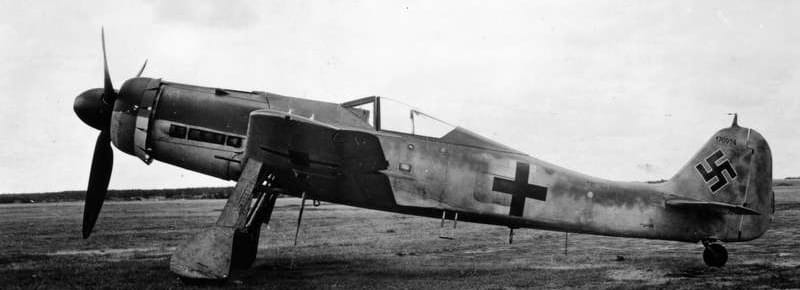
Several additional proposals were offered by Messerschmitt based on the Bf 109H, including the H-2 (fitted with a Junkers Jumo 213E powerplant with GM 1 injection, engine-mounted 30-mm MK 103 cannon and a pair of wing-mounted 20-mm 151 cannon), the H-3 (fitted with the Jumo 213E engine and armed with a centre firing 30-mm MK 108 cannon and a pair of wing-mounted 13-mm MG 131 machine-guns), and the H-4 (reconnaissance aircraft with a camera installation in the aft fuselage). However, none of these proposals were ever accepted by the RLM for prototyping or development due to the success being enjoyed by both the FW 190D and Ta 152H.
Bf 109H-1 Specifications
Length: 9.048 m (29 ft 8 inch)
Height (Ground to Canopy): 2.6 m (8 ft 6.25 inch)
Bf 109H-1 Illustration


Bf 109K series
The Bf 109K was the product of a standardization policy instituted by the RLM to reduce the number of variants and sub-types in the various basic airframes in use by the Luftwaffe. The plan was to select a basic variant, incorporating all the improvements that had evolved through the earlier sub-types, and establish a standard aircraft which would be manufactured by each of the aircraft plants involved in that particular design.

The Bf 109K was such an aircraft, and was based on the Bf 109G-10 variant, incorporating a number of the Umruest-Bausatz as well as several minor aerodynamic external features to improve streamlining. The pre-preduction aircraft, designated Bf 109K-0 for service evaluation and acceptance, were similar to the late G-series production aircraft, but differed in that they had a raised cowling line just forward of the cockpit, a lengthened spinner, installation of the “Galland” type canopy, an enlarged tail assembly, and a fully retractable tailwheel which utilized a longer strut to raise the tail higher during take-offs and allow the pilot increased visibility in a forward attitude, and a modified rudder. In addition to the testing of the standardized G-10 armament of the nose-mounted 20-mm MG 151 cannon and cowling-mounted 13-mm MG 131 machine-guns, the K-0 prototypes also were evaluated with the incorporation of either a 30-mm MK 103 or and MK 108 nose-mounted cannon (the primary difference in the MK 103 and MK 108 was in the length of the barrel) and a pair of cowling-mounted 15-mm MG 151 machine-guns. The powerplant for the Bf 109K-0 was the DB 605B and included the installation of the GM 1 injectant boost system.

The initial production batch of K-series aircraft to be delivered consisted of both the Bf 109K-2 and Bf 109K-4 models. Powered by either the DB 605 ASC or DB 605 DC engines rated at 2,000 hp for take-off and incorporating the GM 1 boost system, the K-2 and K-4 incorporated the modifications noted for the pre-production aircraft and standardized on the 30-mm nose cannon in combination with a pair of 15-mm MG 151 machine-guns. The only difference in the two models was in the installation of a pressurized cockpit into the K-4 model.
Ruestsaetze utilized on the Bf 109K-2 and K-4 models included the R1, R2 and R3 which provided the aircraft the capabilities of adapting to the fighter-bomber role with the use of the ETC racks (R1 and R2) or the long range interceptor role with the R3 addition of the 300 lt (66 Imp gal) ventraly-mounted drop tank.
With deliveries of the Bf 109K-2 and K-4 beginning in October, 1944, Messerschmitt undertook a further refinement of the basic K-series airframe to be used as a high-altitude bomber-interceptor. The designation assigned to this aircraft was Bf 109K-6. The aircraft was similar to the K-4, but reverted back to the 13-mm MG 131 fuselage mounted machine-guns and was fitted with a pair of 30-mm MK 108 cannons in the wings for added firepower, had a BSK 16 gun-camera installed inboard of the port wing cannon, and was equipped with a FuG 16ZY with underwing long range antenna on the port side.
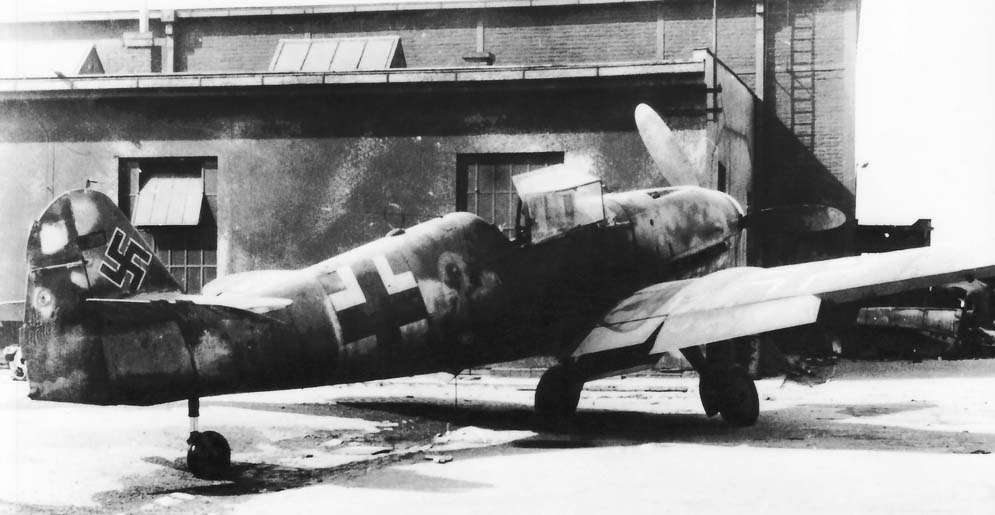
A pair of Ruestsaetze were also available and utilized on the Bf 109K-6. These included the R3 [300 lt (66 Imp gal) center mounted auxiliary fuel drop tank] and the R5 (30-mm MK 108 short barrel cannon in underwing gondolas). Both field conversions were rare and of an experimental nature dude to the limited number of Bf 109K-6s delivered prior to the cessation of hostilities.
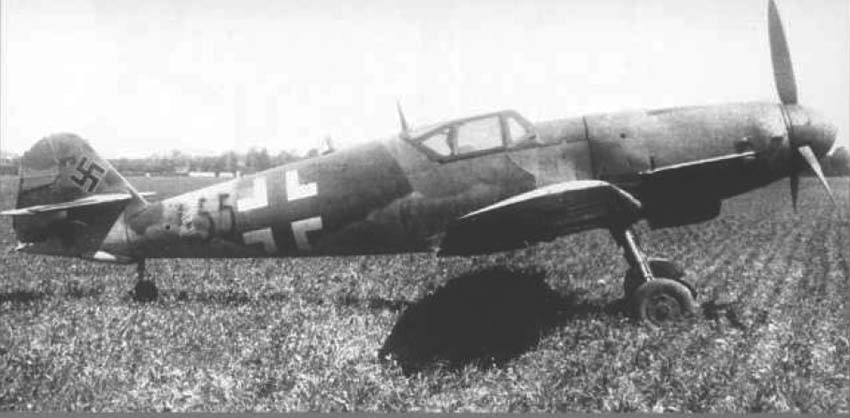
The Bf 109K-8 was produced as a photo-reconnaissance version of the K-6 variant, being fitted with a Rb 50/30 camera in the aft fuselage and fabricated without the fuselage mounted machine-guns, the cowling being faired over the gun throughs. These aircraft were scheduled to being production during the early spring of 1945, however, with the end of the war, only a few of this variant ever left the assembly line.
The Bf 109K-10 variant represented a simple change in armament from the K-4 and the addition of one or more field conversions. Powered by the DB 601D engine, the K-10 was fitted with a pair of fuselage-mounted MG 131 machine-guns and a nose-mounted MK 103 cannon, and like the K-6 was fitted with a BSK gun camera and the FuG 16ZY radio equipment. Conversion kits added to the few examples of this model to reach operational units included the auxiliary drop tank (R3), wing pylons for attachment of a pair of 300 lt (66 Imp gal) jettisonable fuel tank (R4), and a pair of underwing 30-mm MK 108 short barrel cannon in gondolas (R5).
The final variant of the K-series to be produced was the Bf 109K-14 which reached operational Luftwaffe units during the last two weeks of the war. It was fitted with a DB 601L powerplant with a two-stage supercharger, offering over 1,700 hp at take-off with the use of 96 octane fuel. The obvious advantages of the new powerplant, which also made use of the MW 50 boost system, was that it could attain airspeeds of over 720 km/h (450 mph) at altitudes in excess of 10,700 m (35,000 ft).
The only drawback of the Bf 109K-14 was in its armament which, like on the K-8, was limited to a pair of fuselage-mounted MG 131 machine-guns and a single nose-mounted MK 103 or MK 108 cannon. Like the earlier models of the K-series, the K-14 also incorporated the D/F loop and FuG 16ZY antenna to supplement the normal radio mast behind the cockpit, and was fitted with the Revi 16B reflector gunsight.
Bf 109K-4 Specifications
Take-off 2000 hp
Max 1800 hp at 5000 m (16,400 ft)
727 km/h at 6000 m (452 mph at 19,685 ft)
700 km/h at 7500 m (435 mph at 24,610 ft)
10,000 m (32,810 ft) 6 min 42 sec
12,000 m (39,370 ft) 10 min 12 sec
Length: 9.048 m (29 ft 8 inch)
Height (Ground to Canopy): 2.6 m (8 ft 6.25 inch)
Bf 109K Illustrations


Bf 109L series

Never intended as a Bf 109 variant, Bf 109L was the result of the cancellation of the Me 209 program at the Messerschmitt plant at Augsburg. The Me 209 program had been initiated in 1943 with the proposal for the mating of the new Jumo 213E-1 powerplant with a Bf 109F-1 airframe. By the spring of 1944 the prototype, designated Me 209 V6 was ready for flight testing. However, because of the success and progress of the Fw 109D and Ta 152H, the entire Me 209 program was halted.
Not willing to concede the production of the new high-performance high altitude fighter to Focke-Wulf, Messerschmitt decided to proceed with his project, changing the aircraft’s designation to the Bf 109L. However, due to pressing production needs of the Bf 109G, and the work being conducted with the Bf 109H, no further efforts were expended on the Bf 109L.
Bf 109S series
The Bf 109S was the designation that resulted from a Messerschmitt project to transform the Bf 109E into a two place trainer. No immediate need was forecast for its use by the RLM and proposal was rejected. However, in 1942 the program was resurrected utilizing the G-series and culminated in the delivery of several of this model to Luftwaffe Jagdgeschwader and fighter-training schools.

Bf 109T series

Not unlike other countries which would eventually be involved in World War II, Germany realized the importance that sea warfare would play in deciding the outcome of any future conflict. Therefore, in 1935 the Kriegsmarine The Kriegsmarine was the navy of Nazi Germany from 1935 to 1945. It superseded the Imperial German Navy of the German Empire (1871–1918) and the inter-war Reichsmarine (1919–1935) of the Weimar Republic. The Kriegsmarine was one of three official branches, along with the Heer (Army) and the Luftwaffe (Air Force) of the Wehrmacht, the German armed forces from 1933 to 1945.
The Kriegsmarine was the navy of Nazi Germany from 1935 to 1945. It superseded the Imperial German Navy of the German Empire (1871–1918) and the inter-war Reichsmarine (1919–1935) of the Weimar Republic. The Kriegsmarine was one of three official branches, along with the Heer (Army) and the Luftwaffe (Air Force) of the Wehrmacht, the German armed forces from 1933 to 1945.
In violation of the Treaty of Versailles, the Kriegsmarine grew rapidly during German naval rearmament in the 1930s. The 1919 treaty had limited the size of the German navy previously, and prohibited the building of submarines).
Kriegsmarine ships were deployed to the waters around Spain during the Spanish Civil War (1936–1939) under the guise of enforcing non-intervention, but in reality supported the Nationalist side against the Spanish Republicans.
In January 1939 Plan Z was ordered, calling for surface naval parity with the British Royal Navy by 1944. When World War II broke out in September 1939, Plan Z was shelved in favour of a crash building program for submarines (U-boats) instead of capital surface warships and land and air forces were given priority of strategic resources.
The Commander-in-Chief of the Kriegsmarine (as for all branches of armed forces during the period of absolute Nazi power) was the "Führer" Adolf Hitler, who exercised his authority through the Oberkommando der Marine.
The Kriegsmarine's most significant ships were the U-boats, most of which were constructed after Plan Z was abandoned at the beginning of World War II. Wolfpacks were rapidly assembled groups of submarines which attacked British convoys during the first half of the Battle of the Atlantic but this tactic was largely abandoned by May 1943 when U-boat losses mounted. Along with the U-boats, surface commerce raiders (including auxiliary cruisers) were used to disrupt Allied shipping in the early years of the war, the most famous of these being the heavy cruisers Admiral Graf Spee and Admiral Scheer and the battleship Bismarck. However, the adoption of convoy escorts, especially in the Atlantic, greatly reduced the effectiveness of surface commerce raiders against convoys.
After the Second World War in 1945, the Kriegsmarine's remaining ships were divided up among the Allied powers and were used for various purposes including minesweeping. initiated the procurement of a pair of aircraft carriers under the designations, Graf Zeppelin and Peter Strasser. To provide air units for the pair of carriers, to be part of the German Fleet by 1944, a special unit of Bf 109Bs and Ju 87s was assigned to Kiel-Holtenau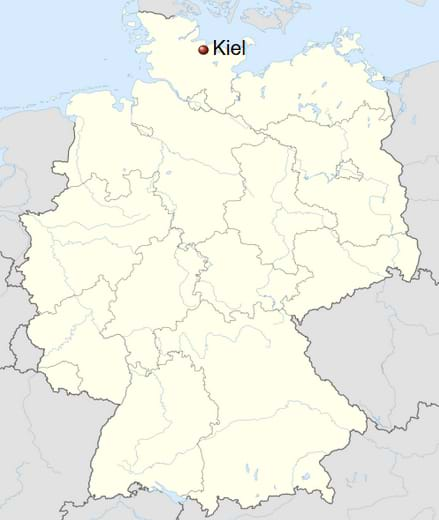 , a large harbor on the Baltic Sea, for training as part of the first Traegergruppe (Carrier Group). The initial training was conducted with specially modified He 50s at Travemuende
, a large harbor on the Baltic Sea, for training as part of the first Traegergruppe (Carrier Group). The initial training was conducted with specially modified He 50s at Travemuende where landings and take-offs where conducted at low speeds on an outlined landing surface to simulate the deck of the Graf Zeppelin.
where landings and take-offs where conducted at low speeds on an outlined landing surface to simulate the deck of the Graf Zeppelin.
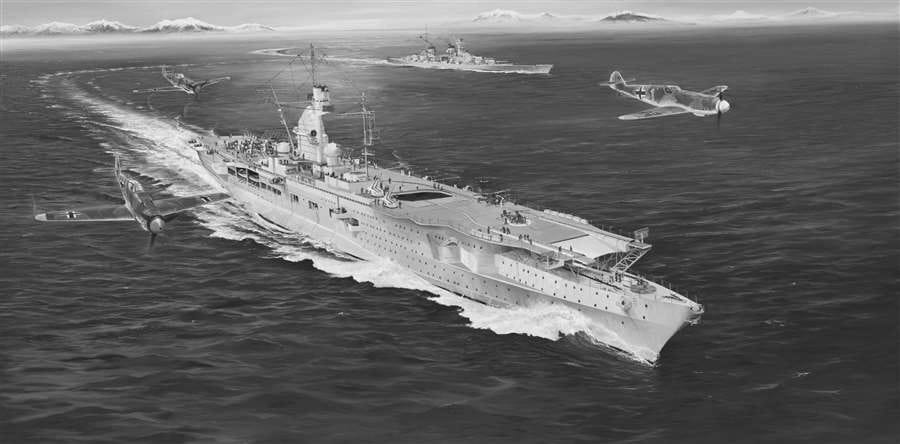
Based on the initial success of the training operations, Messerschmitt was instructed to provide the Kriegsmarine with a carrier version of the Bf 109E. The design, designated Bf 109T (Traeger), was a simple modification of the basic Bf 109E-1 with an increased wing area, accomplished through the addition of approximately 60 cm (2 ft) to the outer plane length, the incorporation of an arrester hook just forward of the tailwheel, and the installation of catapult attach points and associated strengthening. The lengthened wings were also designed with a hinge to allow folding for storage which reduced the wing span of the plane to just over 4 m (13 ft), some 7 m (23 ft) less than the standard Bf 109E fighter.
The design was accepted by the Kriegmarine; however, because of the demand on production being conducted at Augsburg, the program was transferred to Fieseler The Gerhard Fieseler Werke (GFW) in Kassel was a German aircraft manufacturer of the 1930s and 1940s. The company is remembered mostly for its military aircraft built for the Luftwaffe during the Second World War.
The Gerhard Fieseler Werke (GFW) in Kassel was a German aircraft manufacturer of the 1930s and 1940s. The company is remembered mostly for its military aircraft built for the Luftwaffe during the Second World War.
Fieseler's other wartime production would largely consist of building other firms' aircraft under licence, including the Messerschmitt Bf 109 and Focke-Wulf Fw 190. In 1941 however, a Fieseler project for an unpiloted flying bomb (Fi 103) attracted the attention of the RLM (Reichsluftfahrtministerium - "Reich Aviation Ministry"). This went into production as the Fieseler FZG-76 (flakzielgerät, antiaircraft targeting device), better known as the V-1.
The Fieseler factory was the target of many Allied air raids, but continued production throughout the war. Following the War, part of the factory continued in business for a few years, producing automotive components. Its most famous products, the Storch and the V1, continued to be produced by foreign companies.. Ten Bf 109E-1s were diverted from the assembly line as pre-production aircraft for the project and were given the designation Bf 109T-0.
Sixty Bf 109T-1’sw were also ordered from Fieseler. However, in April, 1940, work on the carrier Graf Zeppelin was suspended and finally in early 1943, was cancelled entirely. Fieseler was ordered to complete the order of 60 Bf 109T-1s, but to ensure their usability, they were to omit the carrier equipment such as catapult hooks and arrester gear. Stripped of the carrier equipment, the variant was redesignated the Bf 109T-2 and fitted with a ventrally-mounted rack that would accept either an expendable auxiliary fuel tank or a variety of bomb loads, including four 50 kg (110 lb) SC 50s or a single 250 kg (550 lb) SC 250.
The Bf 109T-2’s deliveries started during March 1941 with the aircraft being assigned to units in Norway where operation from small airfields was a necessity. Being designed for carrier take-offs and incorporating the increased lift-producing wing surface made this variant especially suited to this mode of operation. This same short take-off and landing capability resulted in the few remaining Bf 109T-2s being transferred to the Heligoland fortress in 1943 as an island defense interceptor.
Bf 109T Illustration


Bf 109Z series

Without question the most unique variant of the Bf 109 series was the Bf 109Z (Zwilling, or Siamese Twin). The concept for the aircraft had its origin in 1940 with the proposal for the joining together of a pair of He 111 bomber fuselages to provide enough power to tow the large Me 321 and Ju 322 attack gliders. The acceptance of this concept led Messerschmitt to initiate design drawings for the adaptation of a pair of Bf 109 fuselages joined in the center with a main wing and tailplane structure. The design was intended to offer the Luftwaffe a high performance fighter-bomber without the normal interference of already tooled production lines that would result with the introduction of a totally new aircraft design.

The Messerschmitt proposal was received with interest by the RLM and approval to proceed with prototype assembly and testing was received in early 1942. To determine the feasibility of the concept and to verify flight characteristics, a pair of Bf 109F airframes were mated to the Zwilling configuration late in the year. The only modifications to the fuselage was the incorporation of the structural members necessary to interface with the center main wing and tailplane sections and the relocation of the undercarriage. Each outer wing was also fitted with a pylon capable of carrying an SC 250 bomb and a rack with a load capacity of over 500 kg (1,000 lb) was added to the center wing section. Because of the use of the two DB 601E powerplants, an extra pair of underwing glycol radiators were fitted to the center wing section.
During the assembly efforts related to the prototype, Messerschmitt also initiated design work on an improved Zwilling configuration that utilized a pair of Bf 109G airframes and incorporated either the DB 605A (standard powerplant of the Bf 109G) or the Jumo 213E engine. Planned armament included a pair of engine-mounted 30-mm MK 108 cannon, a 30-mm MK 103 cannon fitted in the center wing section and an additional pair of 30-mm MK 108s in weapon gondolas attached under the outer wings.
The improved Bf 109G configuration was also designated to fill the fighter-bomber role through installation of a pair ETC 250 bomb racks under the outer wings and the inclusion of a center section rack for carrying auxiliary fuel or bombs. In addition, the aircraft would remain a single-place design, with the starboard cockpit area being closed in and utilized for storage of fuel.
The initial prototype Bf 109Z was completed in mid-1943; however, during pre-flight trials, the aircraft was damaged in an Allied bombing raid on the airfield. Repair efforts were immediately instituted, but therefore they could be completed, the entire Zwilling concept was abandoned in favor of the new jet powered aircraft and the fighter-bomber variants of the Fucke-Wulf 190.
Bf 109Z Illustration


Foreign Production and Service
While the Bf 109 series saw active combat service with several of Germany’s allies during World War II, it was also purchased by neutral countries such as Switzerland, which utilized it as a peacekeeping during the conflict. The countries which fought alongside Germany and took delivery of the Bf 109 in variants from the E-series through the G-series included Bulgaria, Finland, Hungary, Italy, Rumania and Croatia. Not all of these aircraft were of German manufacture, however, as assembly plants in Hungary and Rumania were put into operation late in the war to bolster the declining production resulting from Allied bombing.

With the end of hostilities in Germany, the attributes of the Bf 109 were not to be forgotten, however, and two countries, recognizing the need for an interim fighter to fill the gap between their obsolete, or non-existent, fighters and the jet age, initiated their own production or modification program to the later model variants of the Bf 109. The first of these countries was Czechoslovakia, which in 1944 had been selected as a dispersal site for a Bf 109G assembly plant. The plant was fortunate in that at war’s end, a number of components and sub-assemblies had been left behind by the retreating German forces. Thus, in 1945, the Avia factory started production of re-engined version of the Bf 109G-12 and Bf 109G-14 under the designations CS 199 and S 199. The new powerplant was the Jumo 211F which available due to stockpiles of this bomber engine being stored in Czechoslovakia. These aircraft were produced until 1949 and served with Czechoslovakian units until the mid-1950s.

The S 199 was also purchased by the newly forming Israeli Air Force in 1948 as the Czechoslovakian government, in need of hard foreign currency, ignored the United Nations arms embargo in the Middle East. The S 199 served as a stopgap fighter until 1949 when agreements with the major powers were worked out, allowing Israel to purchase newly developed aircraft for its Self Defense Forces.
Spain, the country which had received several of the initial Bf 109s and had inherited several early models after the Spanish Civil War, also produced postwar Bf 109s. Actually, production of the Hispano AviaciónHispano Aviación was established when a Hispano-Suiza car and aircraft parts factory complex in southern Spain was taken over by Franco led "Nationalist" forces in 1939, during the Spanish Civil War.
Located in Tablada, in the Triana district of Seville, the Hispano factory produced several aircraft designs, including the HA-1109 also named Me-109J, Spanish licence built version of the famous Messerschmitt Bf-109G equipped with a 1,300 hp Hispano-Suiza 12Z engine, HA-1112 (HA-1109 re-engined with Rolls-Royce Merlin ), Hispano HA-100 Triana; the Hispano HA-200 Saeta jet trainer and light attack aircraft designed by Professor Willy Messerschmitt.
Hispano Aviación was taken over by Construcciones Aeronáuticas SA (CASA) in 1972, which is now part of Airbus. Bf 109 had been initiated in 1942 with the signing of an agreement between Germany and Spain for the license building of the Bf 109G-2. Under the agreement, Germany was to supply Spain with the components and sub-assemblies to be assembled in Seville . However, as the war progressed, the delivery of these components was delayed and arrival of the DB 605 powerplants never occurred. Unable to secure the engines, Hispano Aviación , still under obligation to supply the Spanish Air Force with the Bf 109G-2, substituted the Hispano-Suiza 12Z 89 12-cylinder engine rated at 1,300 hp.
. However, as the war progressed, the delivery of these components was delayed and arrival of the DB 605 powerplants never occurred. Unable to secure the engines, Hispano Aviación , still under obligation to supply the Spanish Air Force with the Bf 109G-2, substituted the Hispano-Suiza 12Z 89 12-cylinder engine rated at 1,300 hp.
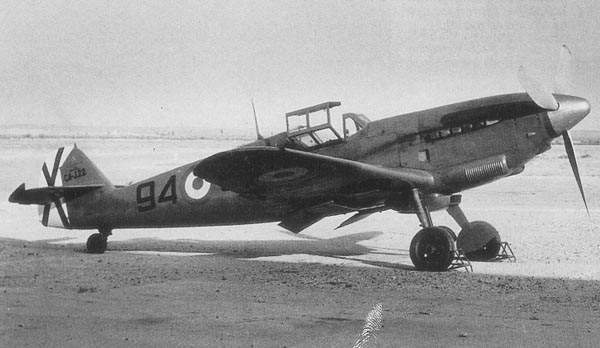
The first of these aircraft, designated HA-1109, flew in March, 1945, with disappointing results due in part to the opposite rotation of the Hispano powerplant in contrast to the Daimler-Benz. The opposite rotation resulted in forces that had to be accounted for through unconventional rudder and aileron control and drastically reduced handling characteristics of the aircraft.
During the next two years numerous design and component modifications were made to the HA-1109 with it finally being accepted for service in 1952. In 1953, cancellation of production of the Hispano-Suiza 12Z 17 powerplant resulted in a decision to re-engine with the British Rolls-Royce Merlin 500-45, with the initial Merlin powered Hispano-built Bf 109 lifting off from San Pablo Airfield in 1954. In just under 30 years, the Bf 109 had come full circle. It had started its career powered by a Rolls-Royce Kestrel and had received its operational baptism in Spain. It was now powered by the Rolls-Royce Merlin and would serve with the Spanish Air Force until 1967, when the last remaining unit was phased out of service.

Detailed Construction
Designed to be simple and inexpensive and yet provide a strong, but not heavy, overall construction, the basic Bf 109 design remained essentially unchanged throughout its career, even with the many modifications incorporated for performance, armament and structural improvements. The aircraft was comprised of several sub-assemblies which were designed to be fabricated by a number of factories, or dispersal plants, for assembly at a common point. In this manner no one plant was depended upon for the entire program, nor could delays of schedule by a single supplier impact other plants. The exception to this was the Daimler-Benz powerplant, but because of the number of engine variants, no serious problems were incurred.

Envisioned for assembly in a manner like the American automobile industry, Messerschmitt designed his aircraft to consist of sub-assemblies with near complete internal components already mated, including hydraulic, electrical and fuel lines. Simple interfacing couplings and fasteners locked the mating parts together. This also simplified maintenance and made repair and replacement of Bf 109 components a short and easy task.
The B09 wings were built around a single mainspar construction concept with flanges and reinforcement braces at all key structural or support interfaces. The mainspar was located in the center of the wing chord to provide undercarriage and wheel retraction clearance without interference. The wing had a flush-riveted stressed-skin of aluminum alloy, while the control surfaces were covered with fabric for light weight and responsiveness. The pair of wing panels, fabricated as individual units, but complete with all necessary control and feed lines, were joined at the fuselage centerline and attached to the lifting body at three points. The forward interface was comprised of a large steel forging which also housed the undercarriage struts and the base for the aft engine mount. The wing’s trailing edge consisted of slotted flaps (inboard) and ailerons (outboard) which were hinged at the pivot points and attached to the wing through aft extending flanges. The leading edge slots had a maximum extension of 5 cm (2 inch) on the outboard side and 7.5 cm (3 inch) on the inboard side.

The tail assembly, which was mated to the fuselage just under the tailplane assembly and included the rudder, was built around a stringer and reinforcement structure similar to the main wing, with all non-moving surfaces covered with an aluminum alloy skin while the rudder and elevators were covered in fabric.
The fuselage was an elliptically shaped configuration with an all-metal support structure which consisted of longerons and radial, or vertical, reinforcing frames. The fuselage was fabricated in two halves and joined at the top and bottom with a flanged longitudinal joint which formed a Z-frame.

On the upper forward fuselage section, just over the Daimler-Benz powerplant, a flat structure for the mounting of the cowl machine-guns was provided. The guns were synchronized to fire through the propeller’s arch.
The upper and lower cowling were both hinged and locked in place by a pair of toggle switches which were easily accessible for the ground crew, but sturdy enough to sustain high flight loads without failure. The opening of these toggles allowed both cowling to be removed in a matter of seconds and provided direct access to the armament and powerplant.
The Bf 109 cockpit was also simple and uncluttered, making use of only essential instruments, but locating them in easily readable locations, with the Revi reflector gunsight situated off-center to the right on top of the forward panel dash and the ignition switch located on the far left corner.
The right, or starboard, side of the cockpit wall contained the primary electrical panel and warning lights mounted in the forward upper quadrant, while the oxygen hose and mask were located just under the panel and secured in place with a pair of metal clips. The port side of the cockpit wall contained both the throttle and mixture control levers.
The flap and tailplane control was maintained through a pair of wheels just to the left of the pilot’s seat with the vertical adjustment of the seat itself next to the wheels. The hinged canopy release was also located on the port side was a simple mechanical lock which was pulled up and back to release the canopy seal.

Combat Operations
The Bf 109 was truly the backbone of the Luftwaffe during the war years. It performed in an operational status from 1936, when three developmental evaluation aircraft were sent to Spain to fight as part of Jagdgruppe 88, until the armistice of 8 May, 1945. It served in nearly every Luftwaffe Jagdgeswader as well as being the primary fighter for the air arms of Germany’s axis allies. The only units it did not appear with were those specifically formed for a singular aircraft such as the famous JG 7 Nowotny which trained in, and entered combat with, the Me 262 twin-jet interceptor.

The Bf 109 achieved its first aerial victory of World War II on 4 September, 1939, only one day after war was declared between Germany and England. On this day, RAF Wellington bombers of No. 9 squadron attacked the German warships Scharnhorst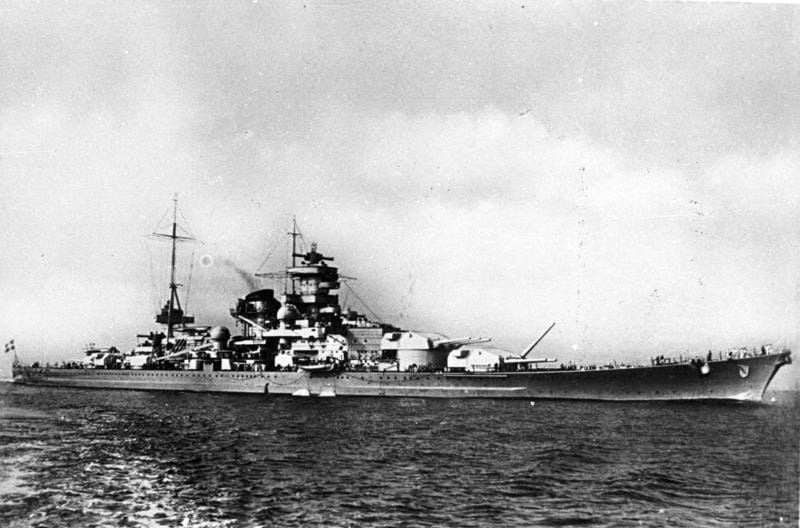 Scharnhorst was a German capital ship, alternatively described as a battleship or battlecruiser, of Nazi Germany's Kriegsmarine. She was the lead ship of her class, which included one other ship, Gneisenau. The ship was built at the Kriegsmarinewerft dockyard in Wilhelmshaven; she was laid down on 15 June 1935 and launched a year and four months later on 3 October 1936. Completed in January 1939, the ship was armed with a main battery of nine 28 cm (11 in) C/34 guns in three triple turrets. Plans to replace these weapons with six 38 cm (15 in) SK C/34 guns in twin turrets were never carried out.
Scharnhorst was a German capital ship, alternatively described as a battleship or battlecruiser, of Nazi Germany's Kriegsmarine. She was the lead ship of her class, which included one other ship, Gneisenau. The ship was built at the Kriegsmarinewerft dockyard in Wilhelmshaven; she was laid down on 15 June 1935 and launched a year and four months later on 3 October 1936. Completed in January 1939, the ship was armed with a main battery of nine 28 cm (11 in) C/34 guns in three triple turrets. Plans to replace these weapons with six 38 cm (15 in) SK C/34 guns in twin turrets were never carried out.
Scharnhorst and Gneisenau operated together for much of the early portion of World War II, including sorties into the Atlantic to raid British merchant shipping. During her first operation, Scharnhorst sank the auxiliary cruiser HMS Rawalpindi in a short engagement (November 1939). Scharnhorst and Gneisenau participated in Operation Weserübung (April–June 1940), the German invasion of Norway. During operations off Norway, the two ships engaged the battlecruiser HMS Renown and sank the aircraft carrier HMS Glorious as well as her escort destroyers Acasta and Ardent. In that engagement Scharnhorst achieved one of the longest-range naval gunfire hits in history.
In early 1942, after repeated British bombing raids, the two ships made a daylight dash up the English Channel from occupied France to Germany. In early 1943, Scharnhorst joined the Bismarck-class battleship Tirpitz in Norway to interdict Allied convoys to the Soviet Union. Scharnhorst and several destroyers sortied from Norway to attack a convoy, but British naval patrols intercepted the German force. During the Battle of the North Cape (26 December 1943), the Royal Navy battleship HMS Duke of York and her escorts sank Scharnhorst. Only 36 men were rescued, out of a crew of 1,968. and Gneisenau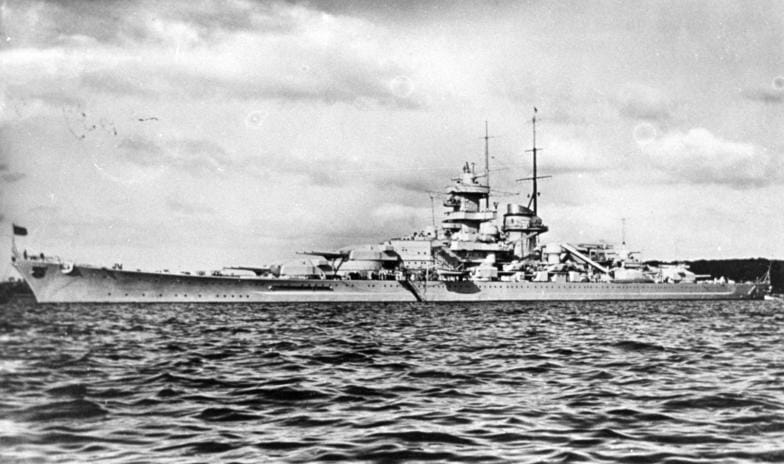 Gneisenau was a German capital ship, alternatively described as a battleship and battlecruiser, of Nazi Germany's Kriegsmarine. She was the second vessel of her class, which included one other ship, Scharnhorst. The ship was built at the Deutsche Werke dockyard in Kiel; she was laid down on 6 May 1935 and launched on 8 December 1936. Completed in May 1938, the ship was armed with a main battery of nine 28 cm (11 in) C/34 guns in three triple turrets, though there were plans to replace these weapons with six 38 cm (15 in) SK C/34 guns in twin turrets.
Gneisenau was a German capital ship, alternatively described as a battleship and battlecruiser, of Nazi Germany's Kriegsmarine. She was the second vessel of her class, which included one other ship, Scharnhorst. The ship was built at the Deutsche Werke dockyard in Kiel; she was laid down on 6 May 1935 and launched on 8 December 1936. Completed in May 1938, the ship was armed with a main battery of nine 28 cm (11 in) C/34 guns in three triple turrets, though there were plans to replace these weapons with six 38 cm (15 in) SK C/34 guns in twin turrets.
Gneisenau and Scharnhorst operated together for much of the early portion of World War II, including sorties into the Atlantic to raid British merchant shipping. During their first operation, the two ships sank the British auxiliary cruiser HMS Rawalpindi in a short battle. Gneisenau and Scharnhorst participated in Operation Weserübung, the German invasion of Norway. During operations off Norway, the two ships engaged the battlecruiser HMS Renown and sank the aircraft carrier HMS Glorious. Gneisenau was damaged in the action with Renown and later torpedoed by a British submarine, HMS Clyde, off Norway. After a successful raid in the Atlantic in 1941, Gneisenau and her sister put in at Brest, France. The two battleships were the subject of repeated bombing raids by the RAF; Gneisenau was hit several times during the raids, though she was ultimately repaired.
In early 1942, the two ships made a daylight dash up the English Channel from occupied France to Germany. After reaching Kiel in early February, the ship went into drydock. On the night of 26 February, the British launched an air attack on the ship; one bomb penetrated her armored deck and exploded in the forward ammunition magazine, causing serious damage and a large number of casualties. The repairs necessitated by the damage were so time-consuming that it was determined to rebuild the ship to accommodate the 38 cm guns as originally intended. The 28 cm guns were removed and used as shore batteries. In 1943, Hitler ordered the cessation of conversion work, and on 27 March 1945, she was sunk as a blockship in Gotenhafen (Gdynia) in German-occupied Poland. She was eventually broken up for scrap in 1951. near Brunsbüttel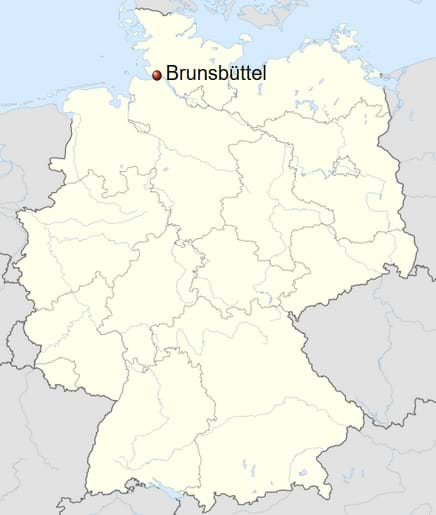 on the North Sea. Unfortunately for the RAF, the Luftwaffe was expecting and prepared for the raid based on earlier attacks of 3 September. Bf 109Bs, Bf 109Cs and Bf 109Es of units based near Wilhelmshaven
on the North Sea. Unfortunately for the RAF, the Luftwaffe was expecting and prepared for the raid based on earlier attacks of 3 September. Bf 109Bs, Bf 109Cs and Bf 109Es of units based near Wilhelmshaven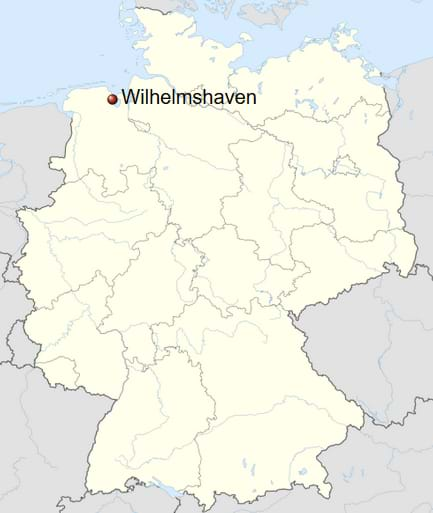 and Nordholz
and Nordholz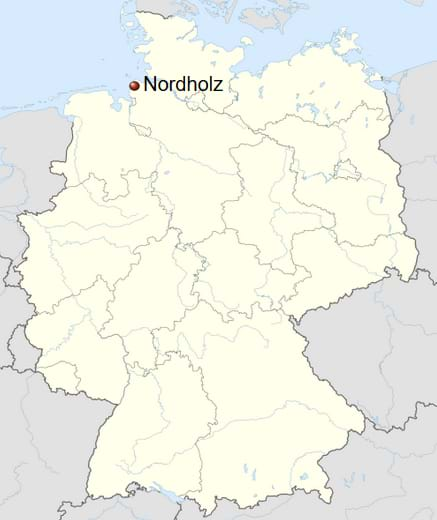 rose to meet the attack. In the encounter, two of the Wellingtons were destroyed by pilots of II Gruppe JG 77, the first losses of the war, and a further eight were destroyed by other fighter interceptor units and by fire from the German warships.
rose to meet the attack. In the encounter, two of the Wellingtons were destroyed by pilots of II Gruppe JG 77, the first losses of the war, and a further eight were destroyed by other fighter interceptor units and by fire from the German warships.

The initial recorded defeat for the Bf 109 occurred on 18 December when the RAF mounted still another heavy raid and reconnaissance mission over the German North Sea harbors in the Wilhelmshaven area. Again Luftwaffe units responded and destroyed a dozen of the intruding aircraft; however, a pair of Bf 109s were shot down. One of the Luftwaffe pilots who scored that day was Leutnant Johannes Steinhoff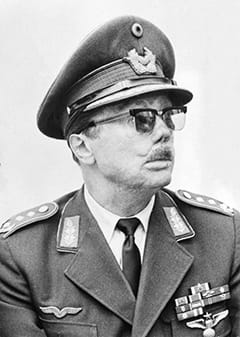 Johannes "Macky" Steinhoff (15 September 1913 – 21 February 1994) was a Luftwaffe fighter ace during World War II, German general, and NATO official. He was one of very few Luftwaffe pilots who survived to fly operationally through the whole of the war period 1939–45. He was also one of the highest-scoring pilots with 176 victories, and one of the first to fly the Messerschmitt Me 262 jet fighter in combat as a member of the Jagdverband 44 squadron led by Adolf Galland. Steinhoff was decorated with the Knight's Cross of the Iron Cross with Oak Leaves and Swords, and later received the Grand Cross of the Order of Merit of the Federal Republic of Germany and several foreign awards including the American Legion of Merit and the French Legion of Honour. He played a role in the so-called Fighter Pilots Conspiracy when several senior air force officers confronted Hermann Göring late in the war. of 10 Staffel JG 26 who would go on to score 176 victories during the war and be given command of JG 7 in December, 1944.
Johannes "Macky" Steinhoff (15 September 1913 – 21 February 1994) was a Luftwaffe fighter ace during World War II, German general, and NATO official. He was one of very few Luftwaffe pilots who survived to fly operationally through the whole of the war period 1939–45. He was also one of the highest-scoring pilots with 176 victories, and one of the first to fly the Messerschmitt Me 262 jet fighter in combat as a member of the Jagdverband 44 squadron led by Adolf Galland. Steinhoff was decorated with the Knight's Cross of the Iron Cross with Oak Leaves and Swords, and later received the Grand Cross of the Order of Merit of the Federal Republic of Germany and several foreign awards including the American Legion of Merit and the French Legion of Honour. He played a role in the so-called Fighter Pilots Conspiracy when several senior air force officers confronted Hermann Göring late in the war. of 10 Staffel JG 26 who would go on to score 176 victories during the war and be given command of JG 7 in December, 1944.
For a nearly a year, the Bf 109 ruled the skies over Europe, easily handling the RAF Hurricanes and early model Spitfires, the Curtiss Hawk 75s, Morane-Saulnier 406s and Dewoitine D.520s of the Armée de l’Air (French Air Force), and the various other obsolete fighters of the Belgium and Netherlands Air Forces. Its first real test came during the summer of 1940 when the Battle of Britain, on of the most important and decisive aerial confrontations of the conflict, at last vaulted the Bf 109 into worldwide attention and prominence.

For three months the Bf 109 found itself locked in a life and death struggle with its RAF counterparts for the right to air superiority over the English Channel and the British Isles themselves. The aircraft did everything asked of it and more. However, the distance from the bases in France, and the continual utilization of the Bf 109 in an escort role, took its toll. Unprepared to perform in the long-range fighter escort function, its losses mounted. The Bf 109, in addition, suffered the disadvantage of fighting over enemy territory and when shot down, the pilots were unable to return to their bases to be assigned another aircraft as were their RAF counterparts. Finally, in September 1940, with heavy losses on both sides, the impending invasion of England was postponed and the beleaguered Bf 109 units in France took advantage of the time to reform and re-equip.
The experiences of these engagements over the British Isles resulted in the initial incorporation of the “U” and “R” conversions to the aircraft in an effort to compensate for its long-range deficiencies and to increase its multi-mission capabilities.
During the next few months, the Bf 109E continued to engage the enemy over the English Channel, in North Africa and in the Mediterranean, before it began to be phased out of service in early 1941 when the Bf 109F started transitioning into the Luftwaffe Jagdgeschwader. One of the first units to receive the new Bf 109s was JG 26 under Oberst Adolf Galland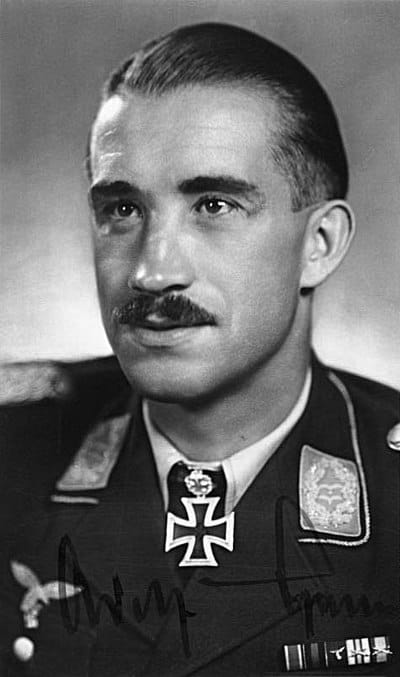 Adolf Josef Ferdinand Galland (19 March 1912 – 9 February 1996) was a German Luftwaffe general and flying ace who served throughout the Second World War in Europe. He flew 705 combat missions, and fought on the Western Front and in the Defence of the Reich. On four occasions, he survived being shot down, and he was credited with 104 aerial victories, all of them against the Western Allies.
Adolf Josef Ferdinand Galland (19 March 1912 – 9 February 1996) was a German Luftwaffe general and flying ace who served throughout the Second World War in Europe. He flew 705 combat missions, and fought on the Western Front and in the Defence of the Reich. On four occasions, he survived being shot down, and he was credited with 104 aerial victories, all of them against the Western Allies.
Galland, who was born in Westerholt, Westphalia became a glider pilot in 1929 before he joined Lufthansa. In 1932, he graduated as a pilot at the Deutsche Verkehrsfliegerschule (German Commercial Flyers' School) in Braunschweig before applying to join the Reichswehr of the Weimar Republic later in the year. Galland's application was accepted, but he never took up the offer. In February 1934, he was transferred to the Luftwaffe. In 1937, during the Spanish Civil War, he volunteered for the Condor Legion and flew ground attack missions in support of the Nationalists under Francisco Franco. After finishing his tour in 1938 Galland was employed in the Air Ministry writing doctrinal and technical manuals about his experiences as a ground-attack pilot. During this period Galland served as an instructor for ground-attack units. During the German invasion of Poland in September 1939, he again flew ground attack missions. In early 1940, Galland managed to persuade his superiors to allow him to become a fighter pilot.
Galland flew Messerschmitt Bf 109s during the Battle of France and the Battle of Britain. By the end of 1940, his tally of victories had reached 57. In 1941, Galland stayed in France and fought the Royal Air Force (RAF) over the English Channel and Northern France. By November 1941, his tally had increased to 96, by which time he had earned the Knight's Cross of the Iron Cross with Oak Leaves and Swords. In November 1941, Werner Mölders, who commanded the German Fighter Force as the General der Jagdflieger, was killed in a flying accident and Galland succeeded him, staying in the position until January 1945. As General der Jagdflieger, Galland was forbidden to fly combat missions.
In late January and early February 1942, Galland first planned and then commanded the Luftwaffe's air cover for the Kriegsmarine Operation Cerberus, which was a major success. It earned him the Knight's Cross of the Iron Cross with Oak Leaves, Swords and Diamonds. Over the ensuing years, Galland’s disagreements with Reichsmarschall Hermann Göring about how best to combat the Allied Air Forces bombing of Germany caused their relationship to deteriorate. The Luftwaffe fighter force was under severe pressure by 1944, and Galland was blamed by Göring for the failure to prevent the Allied strategic bombing of Germany in daylight. The relationship collapsed altogether in early January 1945, when Galland was relieved of his command because of his constant criticism of the Luftwaffe leadership. Galland was then put under house arrest following the so-called Fighter Pilots' Revolt, in which senior fighter pilots confronted Göring about the conduct of the air war.
In March 1945, Galland returned to operational flying and was permitted to form a jet fighter unit which he called Jagdverband 44. He flew missions over Germany until the end of the war in May. After the war, Galland was employed by Argentina's Government and acted as a consultant to the Argentine Air Force. Later, he returned to Germany and managed his own business. Galland also became friends with many former enemies, such as RAF aces Robert Stanford Tuck and Douglas Bader. Adolf Galland died on 9 February 1996. (later promoted to General and given command of the Luftwaffe Fighter Arm). It was Galland himself who scored one of the initial victories with the Bf 109F when on 1 April he was credited with a Supermarine Spitfire over the Southern English coast.
Two months later in June, 1941, Germany opened up a second front when it attacked the Soviet Union. The principal fighter during the early stages of “Operation Barbarossa” was the Bf 109F. The success of the first day alone can attest to the effectiveness, not only of the Bf 109, but of the Luftwaffe in general. Over 1,800 Soviet aircraft were destroyed on the ground and in the air for the loss of less than 50 German planes. Numerous Luftwaffe pilots were credited with fire or more enemy planes shot down, among them Heinz Baer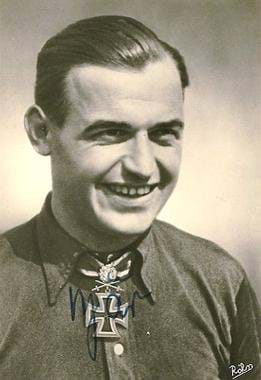 Heinrich "Pritzl" Bär (25 May 1913 – 28 April 1957) was a German Luftwaffe flying ace who served throughout World War II in Europe. Bär flew more than one thousand combat missions, and fought in the Western, Eastern and Mediterranean theatres. On 18 occasions he survived being shot down, and according to records in the German Federal Archives, he claimed to have shot down 228 enemy aircraft and was credited with 208 aerial victories, around 16 of which were in a Messerschmitt Me 262 jet fighter.
Heinrich "Pritzl" Bär (25 May 1913 – 28 April 1957) was a German Luftwaffe flying ace who served throughout World War II in Europe. Bär flew more than one thousand combat missions, and fought in the Western, Eastern and Mediterranean theatres. On 18 occasions he survived being shot down, and according to records in the German Federal Archives, he claimed to have shot down 228 enemy aircraft and was credited with 208 aerial victories, around 16 of which were in a Messerschmitt Me 262 jet fighter.
Bär, a Saxon with a strong accent, joined the Reichswehr in 1934 and transferred to the Luftwaffe in 1935. Serving first as a mechanic, then as a pilot on transport aircraft, he was informally trained as a fighter pilot. He claimed his first aerial victory in September 1939 on the French border. By the end of the Battle of Britain, his tally of victories had increased to 17. Transferred to the Eastern Front to participate in Operation Barbarossa, he quickly accumulated further kills, a feat that earned him the Knight's Cross of the Iron Cross with Oak Leaves and Swords for 90 aerial victories in February 1942.
During the remainder of World War II, Bär was credited with 130 other aerial victories, including 16 while flying one of the first jet fighters, the Me 262, an achievement which would normally have earned him the coveted Knight's Cross of the Iron Cross with Oak Leaves, Swords and Diamonds. Hermann Göring's personal dislike of Bär, coupled with Bär's insubordinate character and lack of military discipline, deprived him of this award. After World War II, Bär continued his career as an aviator. He was killed in a flying accident on 28 April 1957 near Braunschweig. (final war-ending total of 220) and Werner Moelders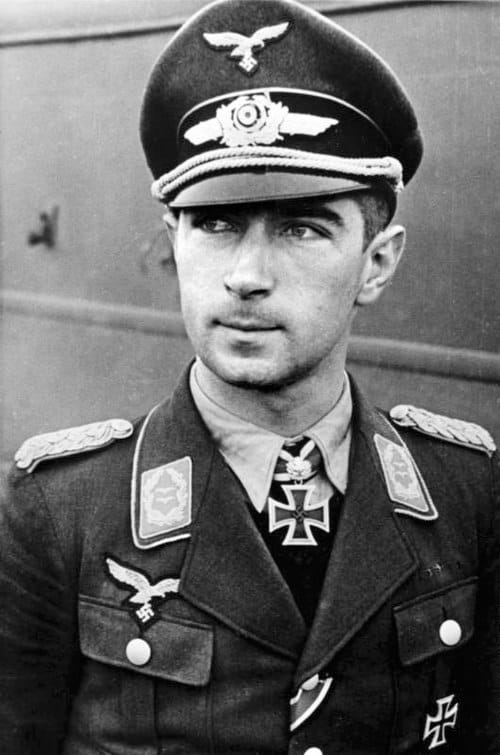 Werner Mölders (18 March 1913 – 22 November 1941) was a World War II German Luftwaffe pilot, wing commander, and the leading German fighter ace in the Spanish Civil War. He became the first pilot in aviation history to claim 100 aerial victories—that is, 100 aerial combat encounters resulting in the destruction of the enemy aircraft, and was highly decorated for his achievements. Mölders was instrumental in the development of new fighter tactics that led to the finger-four formation. He died in an air crash in which he was a passenger.
Werner Mölders (18 March 1913 – 22 November 1941) was a World War II German Luftwaffe pilot, wing commander, and the leading German fighter ace in the Spanish Civil War. He became the first pilot in aviation history to claim 100 aerial victories—that is, 100 aerial combat encounters resulting in the destruction of the enemy aircraft, and was highly decorated for his achievements. Mölders was instrumental in the development of new fighter tactics that led to the finger-four formation. He died in an air crash in which he was a passenger.
Mölders joined the Luftwaffe, the air force of Nazi Germany, in 1934. In 1938, he volunteered for service in the Condor Legion, which supported General Francisco Franco's Nationalist side in the Spanish Civil War, and shot down 14 aircraft.[1] With the start of World War II, he took part in the "Phoney War", Battle of France, and the Battle of Britain. With his tally standing at 68 victories, Mölders and his unit, the Jagdgeschwader 51 (JG 51), were transferred to the Eastern Front in June 1941 for the opening of Operation Barbarossa, achieving 101 victories by mid-July 1941.
Prevented from flying further combat missions for propaganda reasons, at the age of 28 Mölders was appointed Inspector of Fighters. He was inspecting the Luftwaffe units in the Crimea when he was ordered to Berlin to attend the state funeral of Ernst Udet, a Luftwaffe general and World War I flying ace. On the flight to Berlin, the aircraft in which he was traveling as a passenger attempted an emergency landing due to an engine failure. It crashed at Breslau, killing Mölders and two others.
The Wehrmacht and the West German Bundeswehr both honoured him by naming two fighter wings, a destroyer and barracks after him. In 1998, the German Parliament decided that members of the Condor Legion such as Mölders, should "no longer be honoured". In 2005, the German Ministry of Defence decided to remove the name "Mölders" from the fighter wing still bearing his name. (credited with 115 before his death in 1941 in a flying accident).

Another noteworthy Luftwaffe ace who piloted the Bf 109F was Hauptmann Hans-Joachim Marseille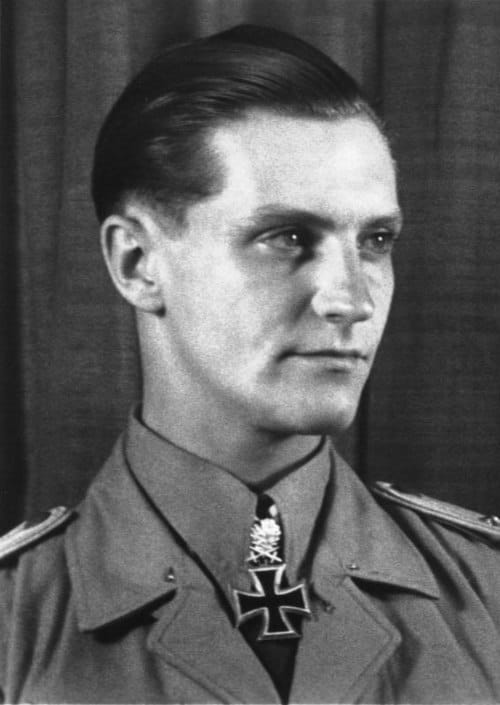 Hans-Joachim Walter Rudolf Siegfried Marseille (13 December 1919 – 30 September 1942) was a German fighter pilot during World War II. A flying ace, he is noted for his aerial battles during the North African Campaign. All but seven of his 158 claimed victories were against the British Desert Air Force over North Africa. No other pilot claimed as many Western Allied aircraft as Marseille.
Hans-Joachim Walter Rudolf Siegfried Marseille (13 December 1919 – 30 September 1942) was a German fighter pilot during World War II. A flying ace, he is noted for his aerial battles during the North African Campaign. All but seven of his 158 claimed victories were against the British Desert Air Force over North Africa. No other pilot claimed as many Western Allied aircraft as Marseille.
Marseille joined the Luftwaffe, in 1938. At the age of 20 he participated in the Battle of Britain, without notable success. As a result of poor discipline, he was transferred to another unit (JG 27), which relocated to North Africa in April 1941.
Under the guidance of his new commander, Marseille quickly developed his abilities as a fighter pilot. He reached the zenith of his career on 1 September 1942, when during the course of three combat sorties he claimed 17 Allied aircraft. For this he received the Knight's Cross of the Iron Cross with Oak Leaves, Swords and Diamonds. A month later, Marseille was killed in a flying accident after his aircraft suffered engine failure. Forced to abandon his fighter, Marseille struck its vertical stabiliser and was either killed instantly or incapacitated and unable to open his parachute., who before his death on 30 September, 1942, accounted for 158 Allied aircraft destroyed. Flying his now-famous Bf 109F-4/Trop., “Yellow 14” Marseille had several multi-victory days including 6 June, 1942, when he claimed the destruction of six South African Air Force Curtiss P-40s.
In May, 1942, the Bf 109G began making its appearance with operational units in North Africa, France and the Russian-Crimea areas. By the end of the year it had virtually replaced the Bf 109F as the Luftwaffe’s primary fighter aircraft. One of the first units to take delivery of the new variant was JG 52 based in Russia. The unit, which was credited with over 10,000 enemy aircraft during the war, had a pilot’s roll that read like a “Wing of Aces”. Among them were Major Gerhard Barkhorn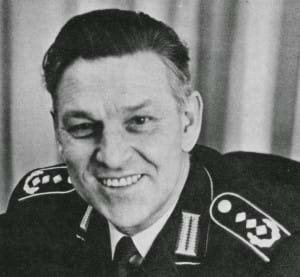 Gerhard "Gerd" Barkhorn (20 March 1919 – 8 January 1983) was the second most successful fighter ace of all time after fellow Luftwaffe pilot Erich Hartmann. Other than Hartmann, Barkhorn is the only fighter ace to ever exceed 300 confirmed victories. Barkhorn joined the Luftwaffe in 1937 and completed his training in 1939.
Gerhard "Gerd" Barkhorn (20 March 1919 – 8 January 1983) was the second most successful fighter ace of all time after fellow Luftwaffe pilot Erich Hartmann. Other than Hartmann, Barkhorn is the only fighter ace to ever exceed 300 confirmed victories. Barkhorn joined the Luftwaffe in 1937 and completed his training in 1939.
Barkhorn flew his first combat missions in May 1940, during the Battle of France and then the Battle of Britain without shooting down any aircraft. His first "victory" came in July 1941 and his total rose steadily against Soviet opposition. In March 1944 he was awarded the third-highest decoration in the Wehrmacht when he received the Knight's Cross of the Iron Cross with Oak Leaves and Swords for 250 aerial victories. Despite being the second-highest scoring pilot in aviation history, Barkhorn was not awarded the Diamonds to his Knight's Cross with Oak Leaves and Swords after achieving his 300th victory on 5 January 1945.
Barkhorn flew 1,104 combat sorties and was credited with 301 victories on the Eastern Front against the Soviet Red Air Force piloting the Messerschmitt Bf 109 and Focke-Wulf Fw 190D-9. He flew with the famed Jagdgeschwader 52 (JG 52—52nd Fighter Wing), alongside fellow aces Hartmann and Günther Rall, and Jagdgeschwader 2 (JG 2—2nd Fighter Wing). Less than two weeks later he left JG 52 on the Eastern Front and joined Jagdgeschwader 3 (JG 3—3rd Fighter Wing), defending Germany from Western Allied air attack.
Barkhorn surrendered to the Western Allies in May 1945 and was released later that year. After the war Barkhorn joined the German Air Force of the Bundeswehr, serving until 1976. On 6 January 1983, Barkhorn was involved in a car crash with his wife Christl. She died instantly and Gerhard died two days later on 8 January 1983. (301 victories), Major Guenther Rall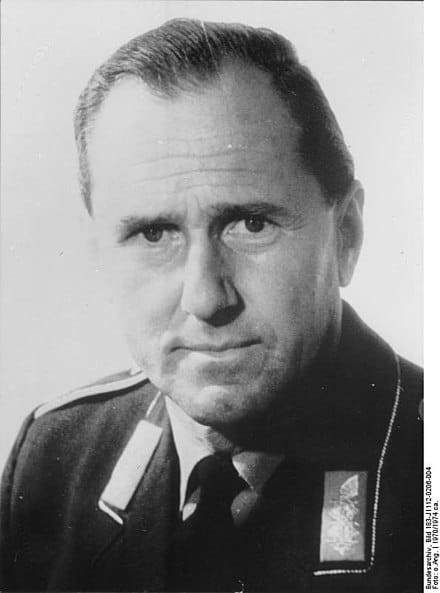 Günther Rall (10 March 1918 – 4 October 2009) was a German lieutenant-general, the third most successful fighter ace in history and later head of the West German Air Force during the Cold War.
Günther Rall (10 March 1918 – 4 October 2009) was a German lieutenant-general, the third most successful fighter ace in history and later head of the West German Air Force during the Cold War.
He achieved a total of 275 victories during World War II: 272 on the Eastern Front, of which 241 were against Soviet fighters. He flew a total of 621 combat missions, was shot down eight times[1] and was wounded three times. He fought 1940 in the Battle of France, the Battle of Britain, 1941 in the Balkan Campaign and over Crete. By the end of the war, he reached the rank of Major and was the commander of Jagdgeschwader 300 when the war ended. He claimed all of his victories in the Messerschmitt Bf 109.
In 1956 he again became a pilot in the West German Air Force, and from the 1960s he held increasingly prominent command posts. He served as Inspector of the Air Force 1971–1974 and as the German Military Representative to the NATO Military Committee 1974–1975. He attended the NATO Defense College in 1964. (275 victories), Major Wilhelm Batz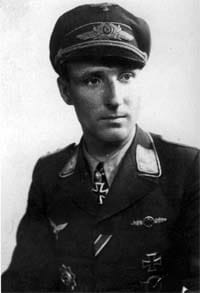 Wilhelm Batz (21 May 1916 – 11 September 1988) was a German Luftwaffe fighter ace during World War II. A flying ace or fighter ace is a military aviator credited with shooting down five or more enemy aircraft during aerial combat. Batz flew 445 combat missions and claimed 237 enemy aircraft shot down. 234 of these victories were achieved over the Eastern Front, including at least 46 Il-2 Sturmoviks, but he did claim three victories, including one four-engine bomber against the United States Army Air Forces (USAAF) over the Ploieşti oil fields. Batz was a recipient of the Knight's Cross of the Iron Cross with Oak Leaves and Swords. (237 victories), Oberst Hermann Graf
Wilhelm Batz (21 May 1916 – 11 September 1988) was a German Luftwaffe fighter ace during World War II. A flying ace or fighter ace is a military aviator credited with shooting down five or more enemy aircraft during aerial combat. Batz flew 445 combat missions and claimed 237 enemy aircraft shot down. 234 of these victories were achieved over the Eastern Front, including at least 46 Il-2 Sturmoviks, but he did claim three victories, including one four-engine bomber against the United States Army Air Forces (USAAF) over the Ploieşti oil fields. Batz was a recipient of the Knight's Cross of the Iron Cross with Oak Leaves and Swords. (237 victories), Oberst Hermann Graf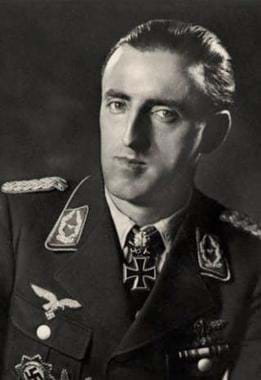 Hermann Graf (24 October 1912 – 4 November 1988) was a German Luftwaffe World War II fighter ace. He served on both the Eastern and Western Fronts. He became the first pilot in aviation history to claim 200 aerial victories—that is, 200 aerial combat encounters resulting in the destruction of the enemy aircraft. In about 830 combat missions, he claimed a total of 212 aerial victories, almost all of which were achieved on the Eastern Front.
Hermann Graf (24 October 1912 – 4 November 1988) was a German Luftwaffe World War II fighter ace. He served on both the Eastern and Western Fronts. He became the first pilot in aviation history to claim 200 aerial victories—that is, 200 aerial combat encounters resulting in the destruction of the enemy aircraft. In about 830 combat missions, he claimed a total of 212 aerial victories, almost all of which were achieved on the Eastern Front.
Graf, a pre-war football player and glider pilot, he joined the Luftwaffe and started flight training in 1936. He was initially selected for transport aviation but was subsequently posted to Jagdgeschwader 51 (JG 51—51st Fighter Wing) in May 1939. At the outbreak of war he was stationed on the Franco–German border flying uneventful patrols. He was then posted as a flight instructor stationed in Romania as part of a German military mission training Romanian pilots. Graf flew a few ground support missions in the closing days of the German invasion of Crete.
Following the start of Operation Barbarossa, the German invasion of the Soviet Union, Graf claimed his first aerial victory on 4 August 1941. He was awarded the Knight's Cross of the Iron Cross after 45 victories on 24 January 1942. It was during the second summer of the eastern campaign; however, that his success rate dramatically increased. By 16 September 1942 his number of victories had increased to 172 for which he was honored with the Knight's Cross of the Iron Cross with Oak Leaves, Swords and Diamonds. At the time of its presentation to Graf it was Germany's highest military decoration. On 26 September 1942 he shot down his 200th enemy aircraft.
By then a national hero, Graf was withdrawn from combat operations and posted to a fighter pilot training school in France before being tasked with the setting up of a new special unit: Jagdgeschwader 50 (JG 50—Fighter Wing 50). Its mission was as a high-altitude unit to intercept the de Havilland Mosquito intruders. In November 1943 Graf returned to combat operations. He was appointed Geschwaderkommodore (Wing Commander) of Jagdgeschwader 11 (JG 11—11th Fighter Wing) and claimed his last and 212th aerial victory on 29 March 1944. He was severely injured during that encounter and, after a period of convalescence, became Geschwaderkommodore of Jagdgeschwader 52 (JG 52—52nd Fighter Wing). He and the remainder of JG 52 surrendered to units of the United States Army on 8 May 1945, but were turned over to the Red Army. Graf was held in Soviet captivity until 1949. After the war he worked as an electronic sales manager and died after a long illness in his home town of Engen on 4 November 1988. (212 victories), Leutnant Walter Wolfrum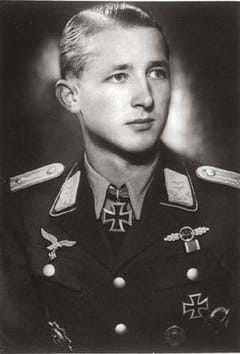 Walter Wolfrum (23 May 1923 – 26 August 2010) was a pilot in the Luftwaffe during World War II. He is credited with 137 aerial victories—that is, 137 aerial combat encounters resulting in the destruction of the enemy aircraft. He was also a recipient of the Knight's Cross of the Iron Cross of Nazi Germany.
Walter Wolfrum (23 May 1923 – 26 August 2010) was a pilot in the Luftwaffe during World War II. He is credited with 137 aerial victories—that is, 137 aerial combat encounters resulting in the destruction of the enemy aircraft. He was also a recipient of the Knight's Cross of the Iron Cross of Nazi Germany.
On 1 June 1944, Wolfrum was credited with his 100th aerial victory. He was the 74th Luftwaffe pilot to achieve the century mark. After the war he became a successful aerobatics pilot, winning the German Championship in 1962 and taking second place in 1961, 1963, 1964 and 1966. (137 victories) and Oberst Dietrich Hrabak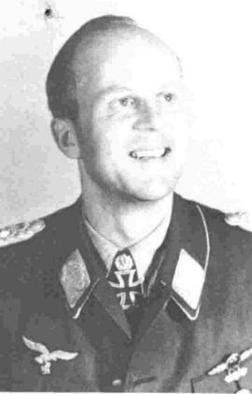 Dietrich "Dieter" Hrabak (19 December 1914 – 15 September 1995) was a German fighter pilot during World War II. Following the war, he served in the German Air Force of West Germany. A fighter ace, he claimed 125 enemy aircraft shot down in over 1000 combat missions. 109 of his victories were claimed over the Eastern Front, with 16 against the Western Allies. (125 victories).
Dietrich "Dieter" Hrabak (19 December 1914 – 15 September 1995) was a German fighter pilot during World War II. Following the war, he served in the German Air Force of West Germany. A fighter ace, he claimed 125 enemy aircraft shot down in over 1000 combat missions. 109 of his victories were claimed over the Eastern Front, with 16 against the Western Allies. (125 victories).

In August, 1942, a young replacement pilot was transferred to the unit. Assigned a Bf 109G as a member of the 7th Staffel of II Gruppe, this young pilot did not score until his 91st sortie. However, when he finally achieved his initial victory in early 1943, it was only the beginning. By the end of the war, Erich Hartmann Erich Alfred Hartmann (19 April 1922 – 20 September 1993), nicknamed "Bubi" ("The Kid") by his German comrades and the "Black Devil" by his Soviet adversaries, was a German fighter pilot during World War II and the most successful fighter ace in the history of aerial warfare. He flew 1,404 combat missions and participated in aerial combat on 825 separate occasions. He was credited with shooting down 352 Allied aircraft—345 Soviet and 7 American—while serving with the Luftwaffe. During the course of his career, Hartmann was forced to crash-land his fighter 14 times due to damage received from parts of enemy aircraft he had just shot down or mechanical failure. He was never shot down or forced to land due to enemy fire.
Erich Alfred Hartmann (19 April 1922 – 20 September 1993), nicknamed "Bubi" ("The Kid") by his German comrades and the "Black Devil" by his Soviet adversaries, was a German fighter pilot during World War II and the most successful fighter ace in the history of aerial warfare. He flew 1,404 combat missions and participated in aerial combat on 825 separate occasions. He was credited with shooting down 352 Allied aircraft—345 Soviet and 7 American—while serving with the Luftwaffe. During the course of his career, Hartmann was forced to crash-land his fighter 14 times due to damage received from parts of enemy aircraft he had just shot down or mechanical failure. He was never shot down or forced to land due to enemy fire.
Hartmann, a pre-war glider pilot, joined the Luftwaffe in 1940 and completed his fighter pilot training in 1942. He was posted to Jagdgeschwader 52 (JG 52) on the Eastern Front and was fortunate to be placed under the supervision of some of the Luftwaffe's most experienced fighter pilots. Under their guidance, Hartmann steadily developed his tactics, which earned him the coveted Knight's Cross of the Iron Cross with Oak Leaves, Swords and Diamonds on 25 August 1944 for claiming 301 aerial victories. At the time of its presentation to Hartmann, this was Germany's highest military decoration.
Hartmann scored his 352nd and last aerial victory at midday on 8 May 1945, hours before the war ended. Along with the remainder of JG 52, he surrendered to United States Army forces and was turned over to the Red Army. In an attempt to pressure him into service with the Soviet-friendly East German Volksarmee, he was tried on fabricated charges of war crimes and convicted; his conviction was posthumously voided by a Russian court as a malicious prosecution. He was sentenced to 25 years of hard labour and spent 10 years in various Soviet prison camps and gulags until he was released in 1955.
In 1956, Hartmann joined the newly established West German German Air Force in the Bundeswehr, and became the first Geschwaderkommodore of Jagdgeschwader 71 "Richthofen". He resigned early from the Bundeswehr in 1970, largely due to his opposition to the F-104 Starfighter deployment in the Luftwaffe and the resulting clashes with his superiors over this issue. In his later years, after his military career had ended, he became a civilian flight instructor. He died on 20 September 1993 aged 71. was to become the war’s highest scoring ace with 352 aerial victories, all in the Bf 109G and K.
As previously noted throughout the description and discussions of the various Bf 109 variants, the plane destined to fill many operational needs for the Luftwaffe. For the most part these were missions the basic aircraft was never designed for, and the required modifications usually detracted from its major advantages which included light weight and maneuverability. Among the more unique operational uses of the Bf 109 were the Wilde Sau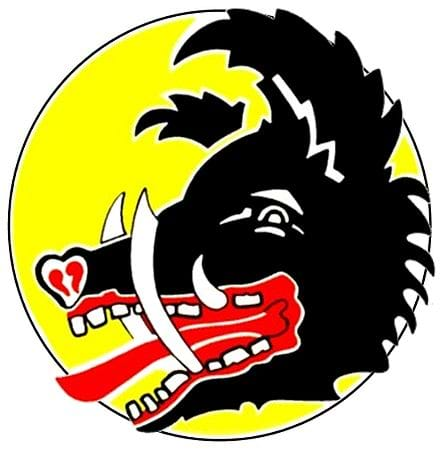 Wilde Sau (German for wild boar) was the term given by the Luftwaffe to the tactic used from 1943 to 1944 during World War II by which British night bombers were engaged by single-seat day-fighter aircraft flying in the Defence of the Reich.
Wilde Sau (German for wild boar) was the term given by the Luftwaffe to the tactic used from 1943 to 1944 during World War II by which British night bombers were engaged by single-seat day-fighter aircraft flying in the Defence of the Reich.
It was adopted when the Allies had the advantage over German radar controlled interception. The fighters had to engage the British bombers freely as they were illuminated by searchlight batteries, while avoiding their own anti-aircraft fire. After some initial successes, rising losses and deteriorating weather conditions led to the abandonment of the tactic. (Wild Boar), the Rammkommando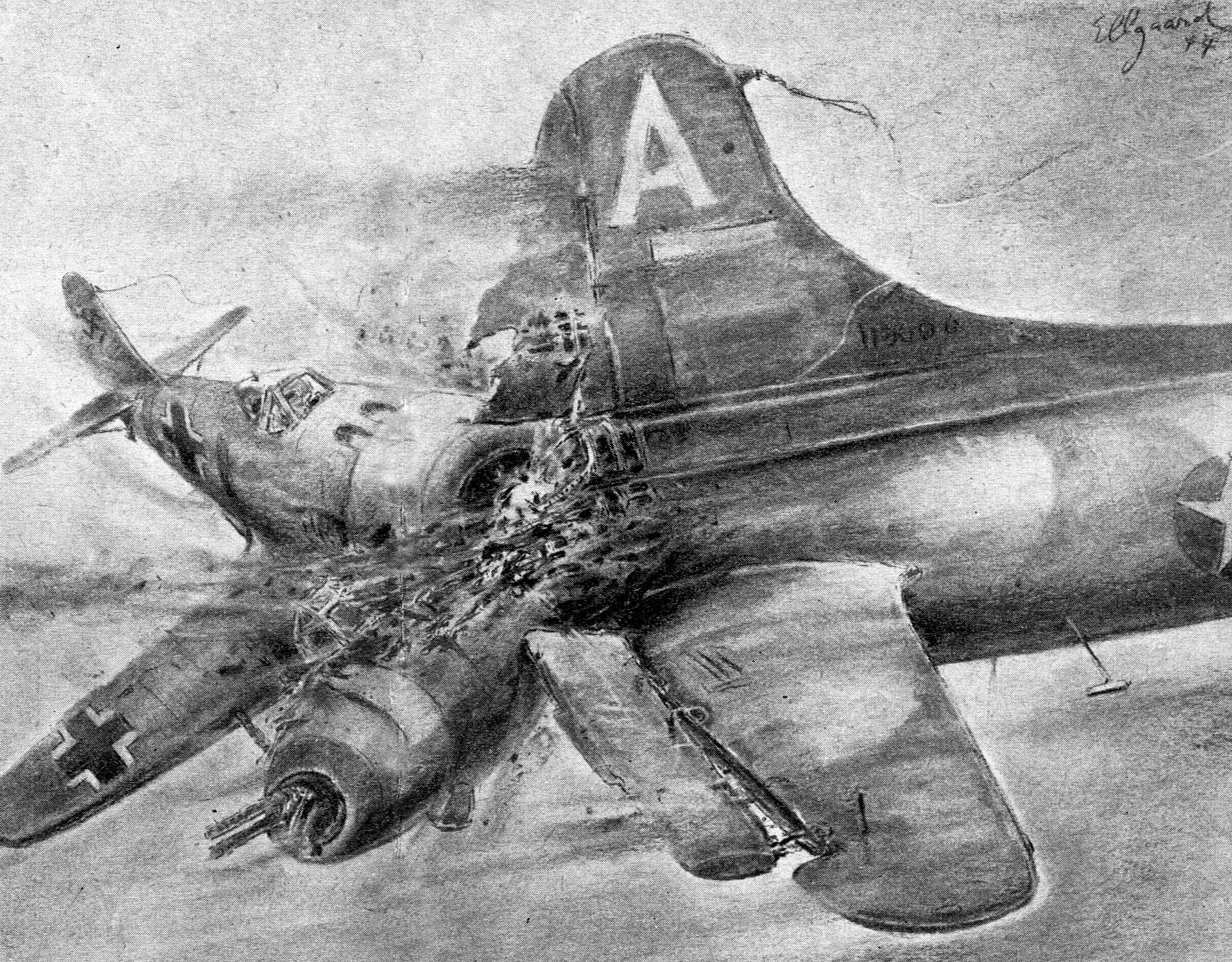 Sonderkommando "Elbe" was the name of a World War II Luftwaffe task force assigned to bring down heavy bombers by ramming aircraft into them mid-air. The tactic aimed to cause losses sufficient to halt or at least reduce the Western Allies' bombing of Germany.
Sonderkommando "Elbe" was the name of a World War II Luftwaffe task force assigned to bring down heavy bombers by ramming aircraft into them mid-air. The tactic aimed to cause losses sufficient to halt or at least reduce the Western Allies' bombing of Germany.
The pilots were expected to parachute out either just before or after they had collided with their target. The chances of a Sonderkommando Elbe pilot surviving such a practice were low, at a time when the Luftwaffe was lacking sufficient numbers of well-trained pilots. (Collision Commandos), and its attachment as a guiding aircraft to Ju 88s in the Mistel (flying bomb) configuration.
The Wilde Sau operations were the brainchild of Major Hajo Herrmann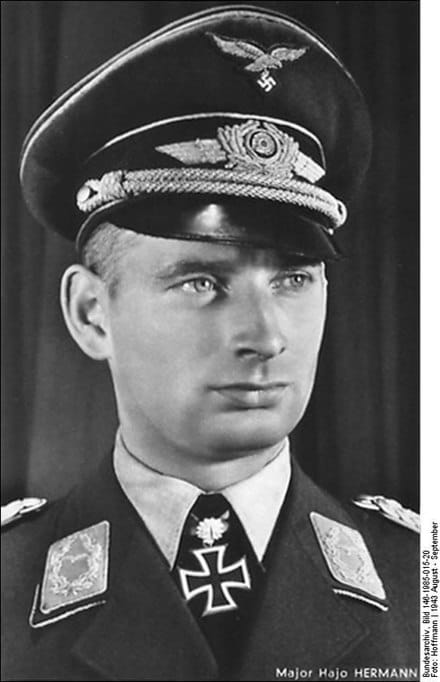 Hans-Joachim "Hajo" Herrmann (1 August 1913 – 5 November 2010) was a German lawyer whose high-profile cases included the defense of neo-Nazis and genocide deniers. In World War II he served in the air force of Nazi Germany and was awarded the Knight's Cross of the Iron Cross with Oak Leaves and Swords., who, during the summer of 1943 had proposed the use of single-place fighter aircraft in a night-fighter role over key German target areas where the enemy bomber stream would be illuminated by both search-lights and fires. The concept also had the advantage of visual contact, and was not dependent on the use of the Himmelbelt line of FuG 220 Lichtenstein air-borne and Wuerzburg ground radar used by the Luftwaffe to guide its nightfighters to the incoming bombers.
Hans-Joachim "Hajo" Herrmann (1 August 1913 – 5 November 2010) was a German lawyer whose high-profile cases included the defense of neo-Nazis and genocide deniers. In World War II he served in the air force of Nazi Germany and was awarded the Knight's Cross of the Iron Cross with Oak Leaves and Swords., who, during the summer of 1943 had proposed the use of single-place fighter aircraft in a night-fighter role over key German target areas where the enemy bomber stream would be illuminated by both search-lights and fires. The concept also had the advantage of visual contact, and was not dependent on the use of the Himmelbelt line of FuG 220 Lichtenstein air-borne and Wuerzburg ground radar used by the Luftwaffe to guide its nightfighters to the incoming bombers.
With the advent of the use of chaff (small strips of aluminum foil dropped from the RAF pathfinder aircraft and bombers), the German radar systems became temporarily inoperative, providing only confusing readouts to the operators, not capable at the time of distinguishing contact with the metal strips from contact with the real aircraft. Until a number of modifications could be incorporated into the radar sets, Wilde Sau became the primary night-fighting weapon of the Luftwaffe.
In July, 1943, decision was made to from an entire Jagddivision, with Jagdgeschwader 300 under Herrmann as the initial unit. Each of the new units, JG 300 near Bonn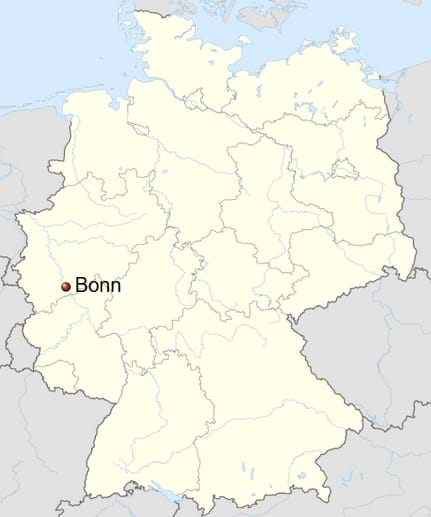 , JG 301 near Munich
, JG 301 near Munich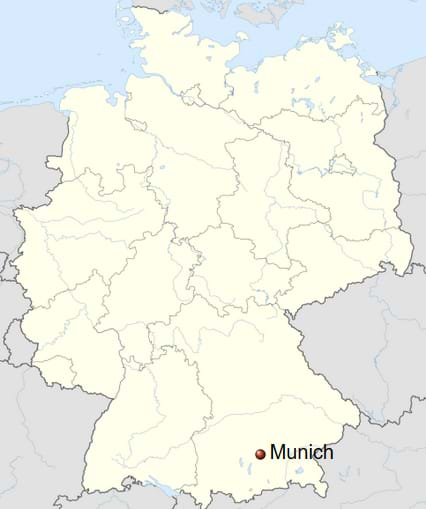 , and JG 302 near Berlin
, and JG 302 near Berlin , were equipped with a single Gruppe of fighters modified with the incorporation of the underwing cannon of Wfr. Gr. 210-mm mortar tubes for increased firepower. Formed primarily around the heavily armored Fw 190A, the limited availability of surplus aircraft forced each of the Jagdgeschwader to utilize the day fighters of other units operating from the same bases. This resulted in the use of several Bf 109G-6s in the new night-fighting role.
, were equipped with a single Gruppe of fighters modified with the incorporation of the underwing cannon of Wfr. Gr. 210-mm mortar tubes for increased firepower. Formed primarily around the heavily armored Fw 190A, the limited availability of surplus aircraft forced each of the Jagdgeschwader to utilize the day fighters of other units operating from the same bases. This resulted in the use of several Bf 109G-6s in the new night-fighting role.
Even though victories by the Wilde Sau operations mounted, so did their losses. It became evident that although both the Fw 190 and Bf 109G were highly effective in this new role, the increased weight of the added armament reduced speed and handling characteristics and made the landing of the aircraft extremely hazardous in inclement weather, especially at night. With the arrival of the late fall and early winter of 1943, the weather conditions and over-use of the aircraft became the major enemy of the Wilde Sau units. Equipment malfunctions, structural failures due to fatigue, and pilots bailing out rather than landing under potentially fatal conditions, rapidly reduced the number of available planes and the operations were cancelled in early 1944.

During this same time period, a new method daylight bomber interception was authorized under the leadership of Major von Kornatski. The new tactic was designated Rammkommando and was based on the use of heavily armored Fw 190 A-8s which would attack the American bombers, getting as close as possible before opening fire. Although ramming of the bomber was not be the primary objective, the suggestion was offered to the young pilots, who were instructed to bail out just prior to impact (a task more easily described than accomplished).
The success of the Rammkommando units lasted until late 1944 when the increase of Allied fighter escorts and the issuance of Allied Command orders to ignore the Bf 109G fighter cover and concentrate on the Rammkommando aircraft, spelled and end to this operation.
The use of the Rammkommando concept was revived, however, in April, 1945, when a special unit. Rammkommando Elbe was formed with Bf 109Gs. The special unit, composed of young volunteers inspired by patriotic conviction, flew only one mission. Over 80% of its aircraft never returned to base.
One of the strangest applications of the Bf 109 as an aerial weapon was in its use as the guidance plane for the Mistel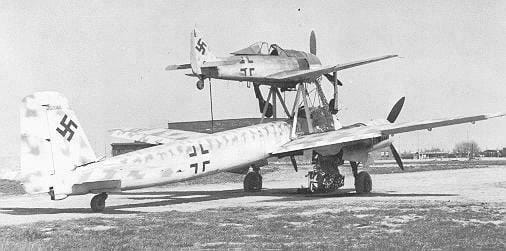 Mistel (German for "mistletoe"), was the larger, unmanned component of a composite aircraft configuration developed in Germany during the later stages of World War II. The composite comprised a small piloted control aircraft mounted above a large explosives-carrying drone, the Mistel, and as a whole was referred to as the Huckepack ("Piggyback"), also known as the Beethoven-Gerät ("Beethoven Device") and Vati und Sohn ("Daddy and Son").
Mistel (German for "mistletoe"), was the larger, unmanned component of a composite aircraft configuration developed in Germany during the later stages of World War II. The composite comprised a small piloted control aircraft mounted above a large explosives-carrying drone, the Mistel, and as a whole was referred to as the Huckepack ("Piggyback"), also known as the Beethoven-Gerät ("Beethoven Device") and Vati und Sohn ("Daddy and Son").
The most successful of these used a modified Junkers Ju 88 bomber as the Mistel, with the entire nose-located crew compartment replaced by a specially designed nose filled with a large load of explosives, formed into a shaped charge. The upper component was a fighter aircraft, joined to the Mistel by struts. The combination would be flown to its target by a pilot in the fighter; then the unmanned bomber was released to hit its target and explode, leaving the fighter free to return to base. The first such composite aircraft flew in July 1943 and was promising enough to begin a programme by Luftwaffe test unit KG 200, code-named "Beethoven", eventually entering operational service.
Other Mistel composites included the Ta 154/Fw 190, Ar 234/Fi 103, Do 217K/DFS 288 and Si 204/Lippisch D-1. Projects included the Ju 287/Me 262 and Ar 234C/Arado E.377. or Beethoven flying bomb. The concept had been initiated in 1941, and revived in 1943 when Junkers proposed to the RLM that older Ju 88 airframes be loaded with high explosive and guided to a specified area by means of a fighter aircraft attached to the bomber by a center-mounted support structure which would be released near the target.

After a few successful tests with the Bf 109E, the prototypes were standardized utilizing Ju 88A-4 and a Bf 109F-4, and production of the Mistel 1 began in May, 1944. The first unit to take delivery of the new Mistel system was Kampfgeschwader 101 which carried out its first Mistel operation in June. Although the success of the sorties flown by KG 101 was limited due to problems (among them, the aiming and releasing of the Ju 88), the potential of the concept was recognized, and further production was ordered with incorporated modifications in the support bracing and aiming instrumentation. The improved configuration was designated Mistel 2, and spelled the end of the Bf 109 participation in the Mistel project. The Mistel 2 and Mistel 3 were to utilize the Fw 190A as the guidance aircraft. Aside from the operation of Rammkommando Elbe in April, 1945 (as described above), the last major operation of the Bf 109 in World War II occurred on New Year’s Day, 1945. Under the code name “Operation Herrmann” the Luftwaffe mounted a major offensive against Allied airfields in France, Holland and Belgium. The plan was to surprise the Allied command with an all-out attack and destroy the bulk continent-based Allied aircraft on the ground. With Fw 190s and Bf 109s (including the use of the Bf 109K for the first time) the Luftwaffe force was composed of aircraft from nine separate Jagdgeschwaders. Claiming over 250 Allied aircraft destroyed, the Luftwaffe, however, suffered equally staggering losses and never fully recovered. The operational combat career of the Bf 109 was almost over.
Flying the Bf 109
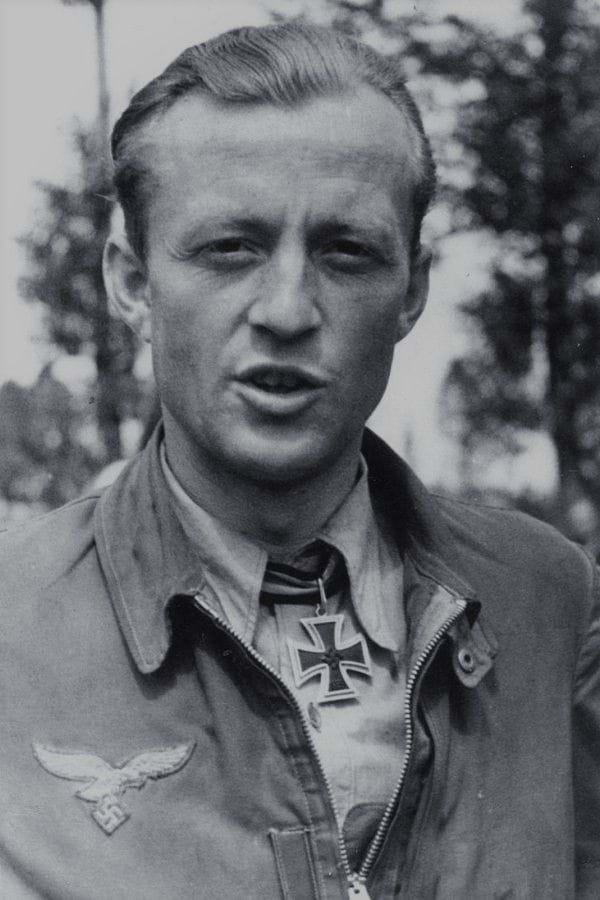
Flying several variants of the Bf 109 for over seven years against almost every Allied aircraft, Herbert Kaiser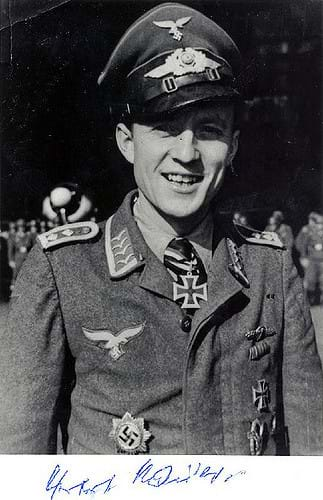 Herbert Kaiser (16 March 1916 – 5 December 2003) was a Luftwaffe ace and recipient of the Knight's Cross of the Iron Cross during World War II. The Knight's Cross of the Iron Cross was awarded to recognise extreme battlefield bravery or successful military leadership. He was captured by American troops in May 1945. During his career he flew 1,200 missions and is credited with 68 aerial victories., a Luftwaffe fighter pilot with 68 confirmed aerial victories, relates what it was like to pilot the Messerschmitt fighter and how it compared to its counterparts both on the Western and Eastern Fronts. As Oberst Kaiser describes it:
Herbert Kaiser (16 March 1916 – 5 December 2003) was a Luftwaffe ace and recipient of the Knight's Cross of the Iron Cross during World War II. The Knight's Cross of the Iron Cross was awarded to recognise extreme battlefield bravery or successful military leadership. He was captured by American troops in May 1945. During his career he flew 1,200 missions and is credited with 68 aerial victories., a Luftwaffe fighter pilot with 68 confirmed aerial victories, relates what it was like to pilot the Messerschmitt fighter and how it compared to its counterparts both on the Western and Eastern Fronts. As Oberst Kaiser describes it:
“The Bf 109B was not an easy aircraft to fly. It had to be directed with utmost attention from the split-second one gave it gas. The extremely narrow tracked under-carriage could not fully compensate for the normal tendency of the aircraft to pull to the right due to the prop torque. The maintaining of one’s starting direction could be accomplished only by the smooth application of power, the balancing of the rudder, and the balancing of the elevators to lift the tail only after being airborne in order to keep constant aileron efficiency. Any casual disregard for those basic rules had a result of breaking the flight path and a possible crash.
The cardinal rule during landing was that at the point of touchdown gear and tail skid had to be oriented in the line of a projected roll without further attempt at directional control. Separation of aerodynamic lift due to insufficient approach speed, and excessive directional corrections performed during the landing procedure was the most common cause of crashed. The experienced pilot had these rules in the flesh and blood and this enabled him to make better use of his time by concentrating on other matters.
Visibility from the cockpit was good, although during take-off it was quite restricted in the frontal area until the tail wheel left the ground. It was not at all reassuring to look forward and see only the large metal cowl, and this was why the aircraft had to be correctly oriented on take-off.
Although the Bf 109B was useful as a frontline combat aircraft and far outclassed enemy aircraft of the time in speed and climbing ability, its initial Junkers-built engine was extremely sensitive and not sufficiently powerful.
The Luftwaffe did not, in my estimation, have a truly superior and robust fighter aircraft until the appearance of the Bf 109E. The use of the DB 601 engine with 1200 hp, the increased speed, and the high climb rate made the Bf 109E, in relation to its counterparts, the best fighter of its time. Its armament of two machine guns and two cannon were more than enough to knock any enemy plane out of the air with a well-placed burst of fire.”
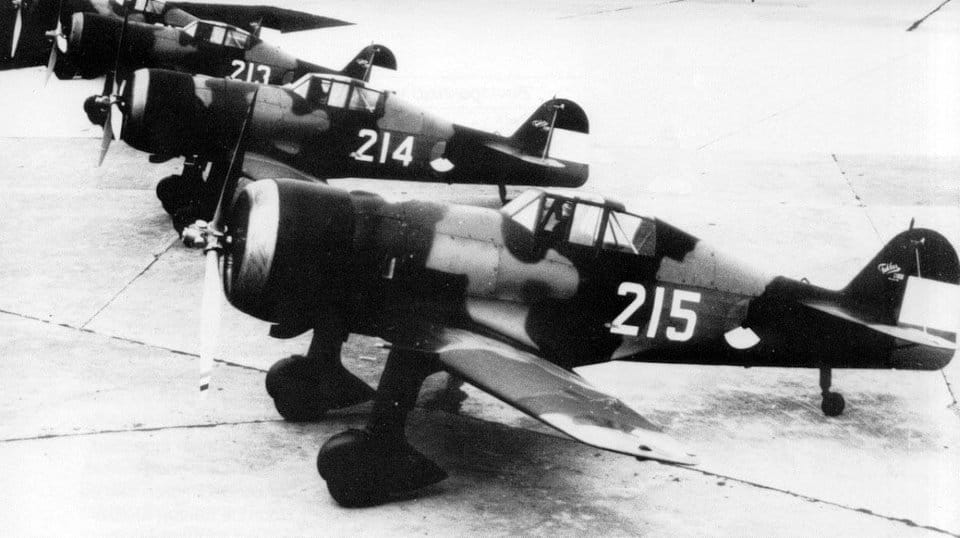
On 10 May, 1945, Kaiser, now flying as a part of III/JG 77, took part in the start of the Western Campaign against airfields in Holland and was credited with the destruction of two Dutch Fokker D.XXIs. He was then sent to France where he remained, flying patrol until the Dunkirk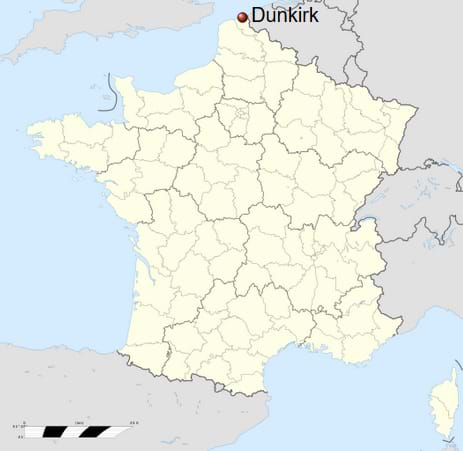 encirclement. Of these days Kaiser relates: “Although prior to the start of the Western Campaign in May, 1940, no German pilot could make a comprehensive comparison between British and French fighters and our Bf 109E, we firmly believed we had the best airplane based on comparative flying reports and an abundance of rumors. Personally, at the advent of hostilities, I had contact only with Dutch Fokker D.XXIs, and this fixed gear monoplane, approximately 80 km/h (50 mph) slower than a 109E, offered no particular challenge. Some of my comrades from neighboring units, however, had encountered the RAF Spitfires and Hurricanes, as well as the French Dewoitines and Morane Saulniers and thus affirmed what we all believed about our aircraft.
encirclement. Of these days Kaiser relates: “Although prior to the start of the Western Campaign in May, 1940, no German pilot could make a comprehensive comparison between British and French fighters and our Bf 109E, we firmly believed we had the best airplane based on comparative flying reports and an abundance of rumors. Personally, at the advent of hostilities, I had contact only with Dutch Fokker D.XXIs, and this fixed gear monoplane, approximately 80 km/h (50 mph) slower than a 109E, offered no particular challenge. Some of my comrades from neighboring units, however, had encountered the RAF Spitfires and Hurricanes, as well as the French Dewoitines and Morane Saulniers and thus affirmed what we all believed about our aircraft.

In personally facing the RAF in the air over the Dunkirk encirclement, I found that the Bf 109E was faster, possessed a higher rate of climb, but was somewhat less maneuverable than the RAF fighters. Nevertheless, during the campaign, no Spitfire or Hurricane ever turned inside of my plane, and after the war the RAF admitted the loss of 450 Hurricanes during the Battle of France.”
On 19 June, 1941, III/JG 77 was posted to Bacau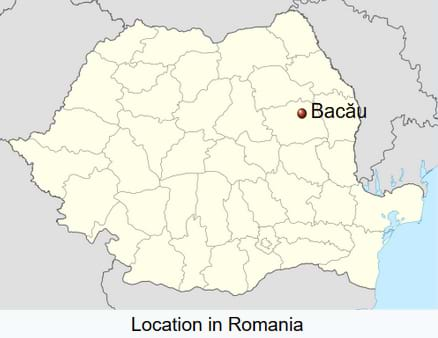 on the Russian border and on the 22nd engaged in their first missions against the Soviet Air Force. Taking off at 0400 hours Kaiser achieved his initial kill over the Eastern Front later in the day near Balti. Oberst Kaiser recalls the Russian campaign: “Against the early Russian aircraft the Bf 109E was untouchable. The Soviet planes were slower and could not climb with us. They were, however, highly maneuverable, especially the I-15 and I-16, and one could not allow an encounter to deteriorate into a contest of turns. This was easily avoided, because we always had the element of surprise, due to our high speed and advanced communication systems.
on the Russian border and on the 22nd engaged in their first missions against the Soviet Air Force. Taking off at 0400 hours Kaiser achieved his initial kill over the Eastern Front later in the day near Balti. Oberst Kaiser recalls the Russian campaign: “Against the early Russian aircraft the Bf 109E was untouchable. The Soviet planes were slower and could not climb with us. They were, however, highly maneuverable, especially the I-15 and I-16, and one could not allow an encounter to deteriorate into a contest of turns. This was easily avoided, because we always had the element of surprise, due to our high speed and advanced communication systems.

In Russia I encountered many varied aircraft, particularly bombers, for the most part the twin-engined Ilyushin DB-3, and later the Pe-2, and Il-2 attack bombers. The greatest losses for the Soviets, at least in our sector, occurred with the DB-3. A military version of a Soviet long-distance record-breaker, it had great range, but was incredibly slow, and possessed poor defensive firepower. All weapons were hand-held, rifle-caliber guns and the bomber was blind to a direct tail-on approach. A single burst between the left engine and the fuselage into the wing root and the unprotected fuel tanks guaranteed immediate burning and unavoidable crash. It was considerably more difficult to attack the Pe-2 because of her speed, twin-tail assembly and the unrestricted tail gunner’s vision.
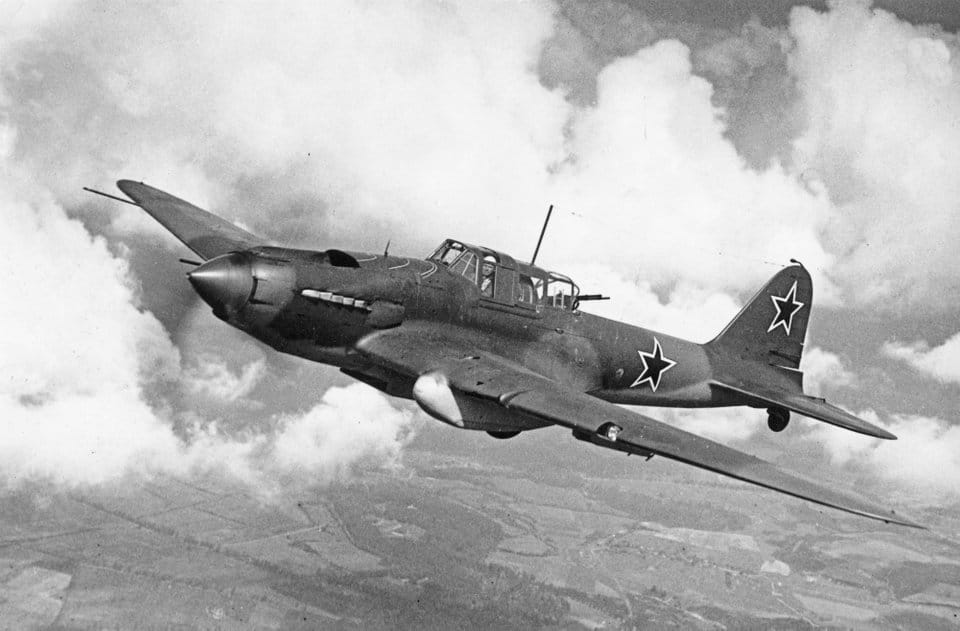
The Ilyushin Il-2 (Shturmovik) was also tough. A single engine fighter bomber not exceptionally fast, but very well armored, this plane required a detailed knowledge of its construction and a well-executed approach to destroy. The unforgettable Moelders showed me personally how one downed this aircraft. The Il-2 possessed armor behind the pilot; but just behind this armor was a small tank which was utilized as a starter cartridge. Totally unprotected and vulnerable, this tank was exploded with a single incendiary burst. Of course, in this mode of attack, a precise and accurate burst was necessary. Later the Soviets installed a rear gunner’s position and armored the starter cartridge.
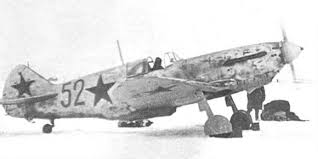
During my participation in the Russian campaign, I also encountered the LaGG-3 and the MiG-3. I did destroy some of these, but it would be extremely difficult to make any well founded comparison with the Bf 109 because of my limited confrontation.”
It was in North Africa that Kaiser received his first Bf 109G; “Here I was introduced to the Bf 109G which had an even more powerful engine than the F-model and a larger compressor (supercharger). It was had extremely good high-altitude performance. The air density of the North African sky was considerably less than that over Russia, and our performance could be maintained only through the constant use of the compressor. From a pure flying standpoint, the Bf 109G offered little over the Bf 109F. She was considerably heavier and still had the difficult take-off and landing qualities inherent with all the Bf 109 variants.

During the African campaign, we were short of aircraft and for the young pilots with little actual air of combat experience, it was very difficult to master the 109. In addition, landings and take-offs were aggravated by the general condition of the desert air strips, not to mention sand and blowing grit. Because of these conditions, the relatively few number of airworthy planes were usually flown by the older, more experienced pilots, and the appearance of the same familiar names dominated the victory totals.”
Describing the tactics employed by the Luftwaffe in North Africa in late 1942 and his impressions of some of the aircraft he faced, Oberst Kaiser relates:
“The classic dogfight was still partly used in Africa, and the lone sortie was prevalent. We were forced to this lone sortie tactic of surprise due to the overwhelming supply of Allied aircraft and, in this way, were able to spread ourselves over more area. Any other tactics would be coupled with high losses on our side, a condition we could not allow. Additionally, the speed and durability of the Bf 109G lent itself very well to this type of tactic. If we were overmatched, we could always break off.
The Curtiss P-40 was not as fast as the Bf 109G and in a confrontation with this plane we had nothing to worry about as long as the basic rules of combat tactics were followed. We did, however, have to avoid getting into the middle of a large formation, for the P-40 turned well and as an old German saying goes, ‘Too many dogs are the death of the rabbit.’

The P-38 Lighting was equal to our Bf 109G in performance, far superior in range, and was a much more difficult adversary in a dogfight. However, I never employed any special evasive maneuvers when I encountered one of them. Evasive tactics, as far as I am concerned, were dictated by the situation and were a reflex reaction. For the most part, independent of the aircraft on your tail, one would utilize a steep turn and pull out to get behind his enemy, or pull up on the stick in a succession of stuttering steps to reduce speed, hoping the abrupt velocity decrease would not be picked up in time by the aircraft behind you, forcing him to fly over, exposing his belly. I always considered a turn-out and dive a high risk tactic and, to my knowledge, this particular move was not used to any great extent by Luftwaffe fighter pilots.”
In January, 1943, Kaiser was detached from JG 77 and sent to a replacement depot in Southern France as an instructor. He stayed there for four months before rejoining III/JG 77 and was posted to Italy where he destroyed four more aircraft. Then in January, 1944, Kaiser was returned to Germany for a routine medical checkup after which was assigned to I/JG 1 under the command of Oberst Walter Oesau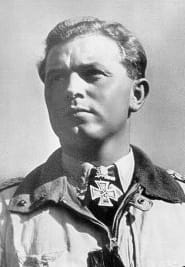 Walter "Gulle" Oesau (28 June 1913 – 11 May 1944) was a German fighter pilot during World War II. A fighter ace, he served in the Luftwaffe from 1934 until his death in 1944. He rose to command Jagdgeschwader 1, which was named in his honor after his death.
Walter "Gulle" Oesau (28 June 1913 – 11 May 1944) was a German fighter pilot during World War II. A fighter ace, he served in the Luftwaffe from 1934 until his death in 1944. He rose to command Jagdgeschwader 1, which was named in his honor after his death.
He served with the Condor Legion during the Spanish Civil War with the Jagdgruppe 88. He claimed nine aircraft during the campaign, becoming one of only 28 people to earn the award of the Spanish Cross in Gold and Diamonds.
At the start of World War II, Oesau was given command of a fighter group within Jagdgeschwader 20. The group took part in the Invasion of Poland, later moving to the Western Front as the redesignated III Gruppe, Jagdgeschwader 51. Oesau operated on both the Western and Eastern Fronts.
He returned to operations as commander of Jagdgeschwader 1. He was killed in action on 11 May 1944 aged 30. JG 1 was given the name "Oesau" in his honor.. With this unit he flew until 6 June, 1944, in the Defense of the Reich. From 6 June until 9 August he was stationed on the Normandy Front flying in a defensive role against the Allied invasion forces and describes his experiences as follows:
“Near the end of June, 1944, while attach to I/JG 1, on an airfield just outside Paris, France, an excellent example of the almost complete Allied air superiority occurred. I was vectored out to intercept an incoming flight of Allied bombers which was attacking our troops in the Normandy area. Our take-off had to be only in the smallest of groups (usually 2 to 4 aircraft) due to the Allied fighters which almost always waited above the bases for our fighters to emerge from cloud cover. We would be forced to sneak from our base into our target area by hedge-hopping over the terrain to take advantage of all the camouflage possible. Flying only a few feet off the ground kept us off radar screens, but sometimes put us on the side of a hill. We would only climb to any height when we had reached the attack point under the enemy planes.
My flight of four aircraft sighted a formation of escorting Spitfires, and we positioned ourselves to engage them. We were instead caught by a second group of Allied fighters and in the process I lost my three men. Escape from the onslaught seemed impossible. Only because of my experience and the lucky appearance of a nearby cloud was I able to save myself.
At this time the Luftwaffe was being ground into the earth. One could not count on this hand the days he expected to live. It was surprising to me that the Luftwaffe pilot had any nerve left at all, let alone the ability to prepare himself for combat with the enemy under these conditions.”
Bf 109 in Popular Culture
Messerschmitt Bf 109s are very common in popular culture especially in model kits and video games.
Bf 109 Model Kits


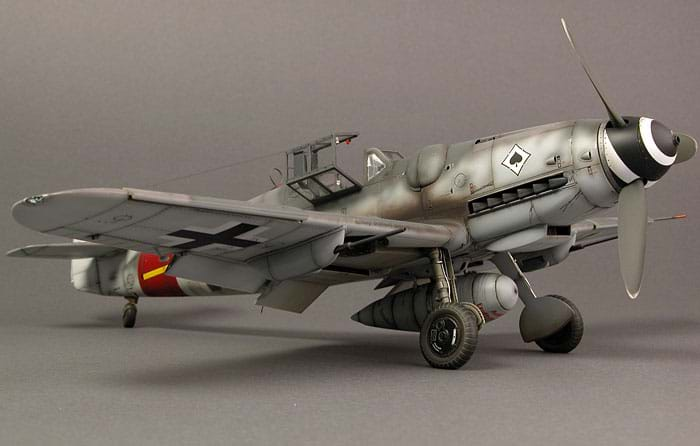





Bf 109 in Video Games

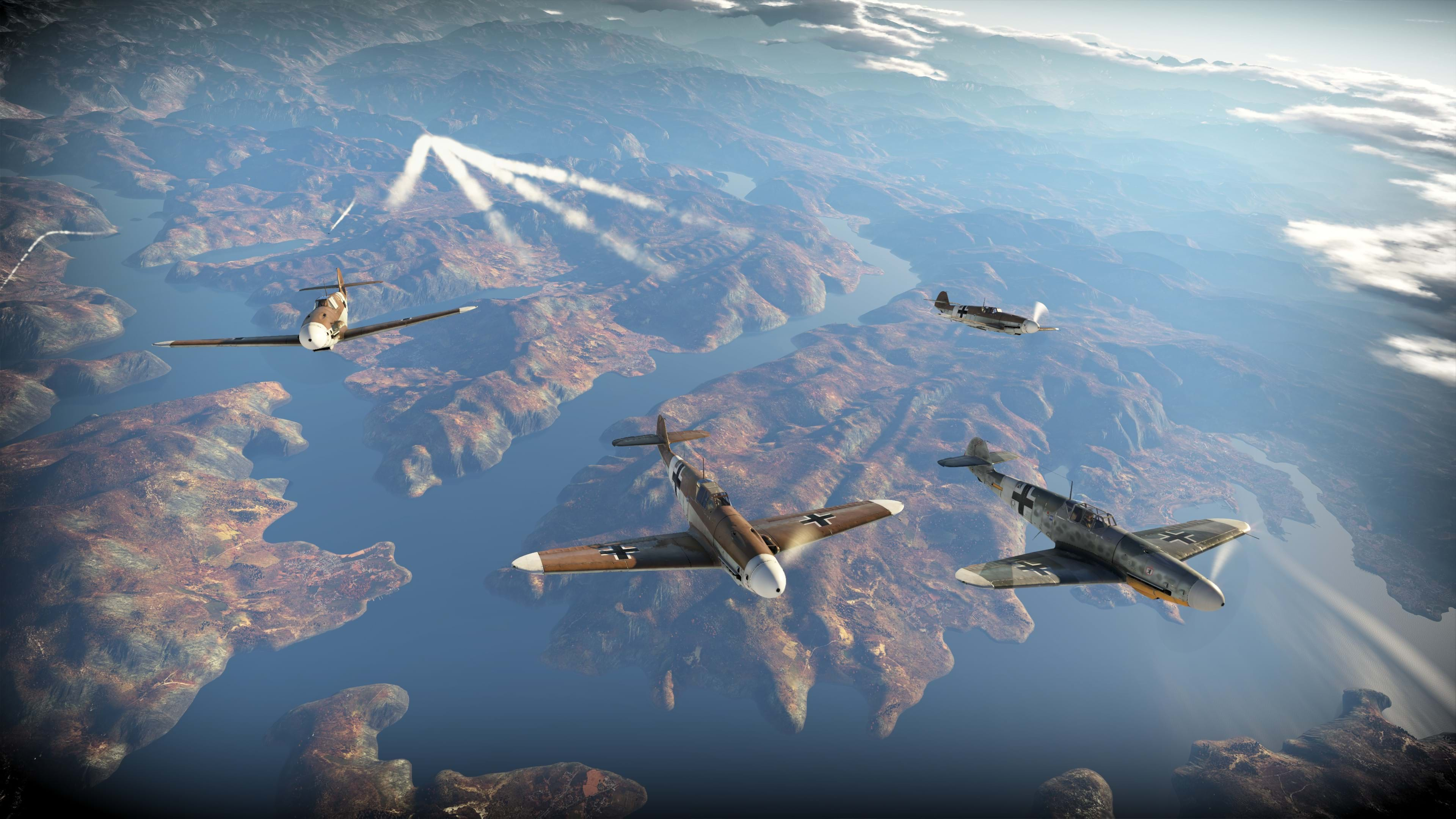
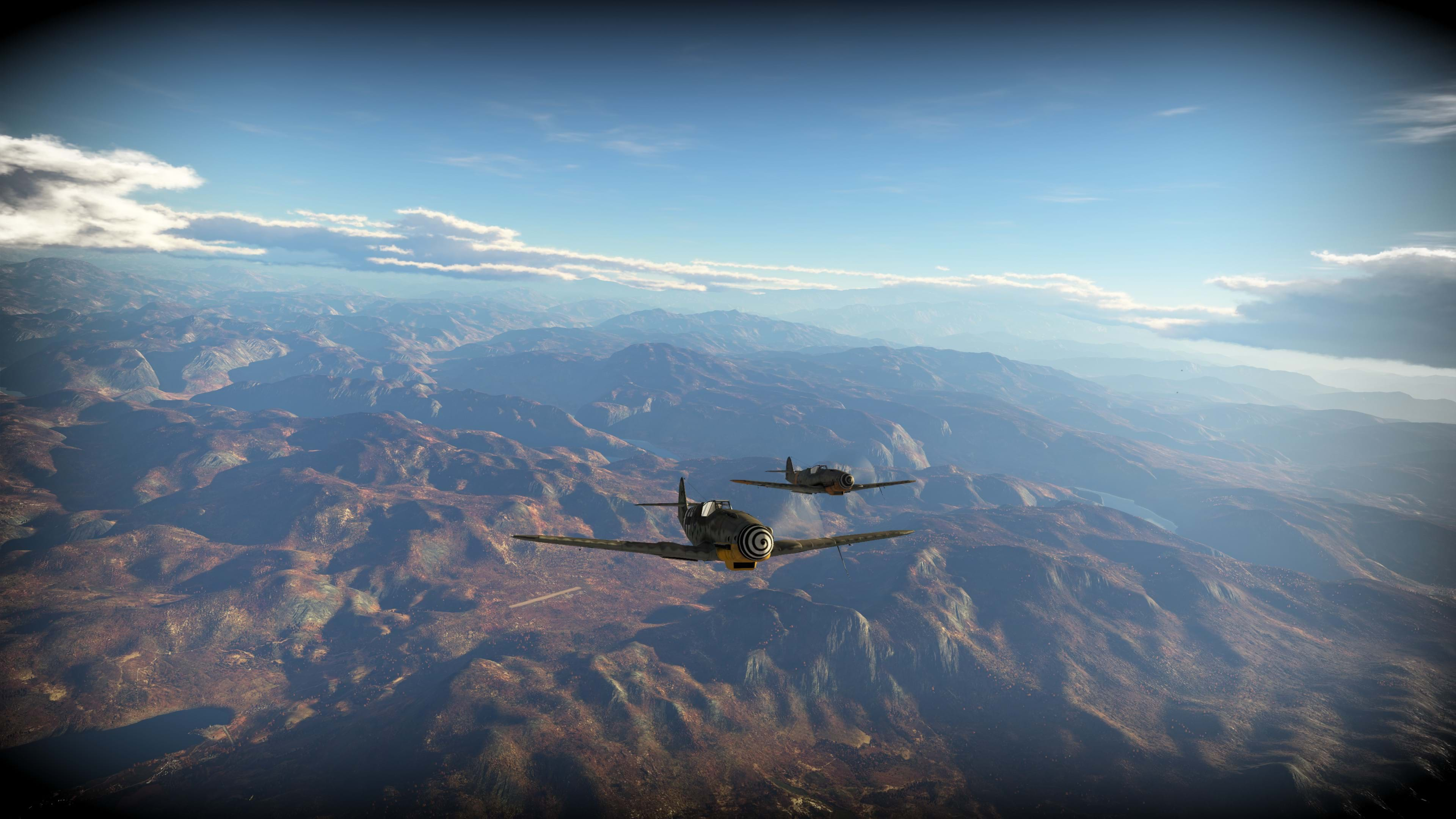
Bf 109 Videos
Books About Bf 109
- Messerschmitt Bf 109: The Design and Operational History
- Messerschmitt Bf 109 F, G, and K Series: An Illustrated Study
- Messerschmitt Bf 109 F (Yellow)
- Combat Colours 1
- Monogram Close-Up 9: Messerschmitt Bf 109 F
- Messerschmitt Bf109 at War
